
Global Fertilizer Trades Italian Equipment FIBCs & Bagging FEATURES DRY CARGO international DC i ISSUE NO. 263 NOVEMBER 2022 WWW.DRYCARGOMAG.COM The world’s leading and only monthly magazine for the dry bulk industry Cement Handling Equipment Geared Bulk Carriers Fertilizer Handling Systems
Our bespoke solutions are designed to meet each customer’s specific requirements from a tool kit of proven components, utilising the expertise of a team of specialist in house design engineers.



We lead the loading chute industry & set the standard for dust emissions and environmental pollution control in dry bulk handling.
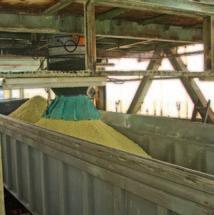
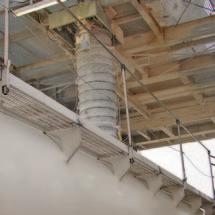

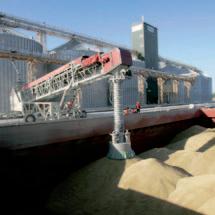
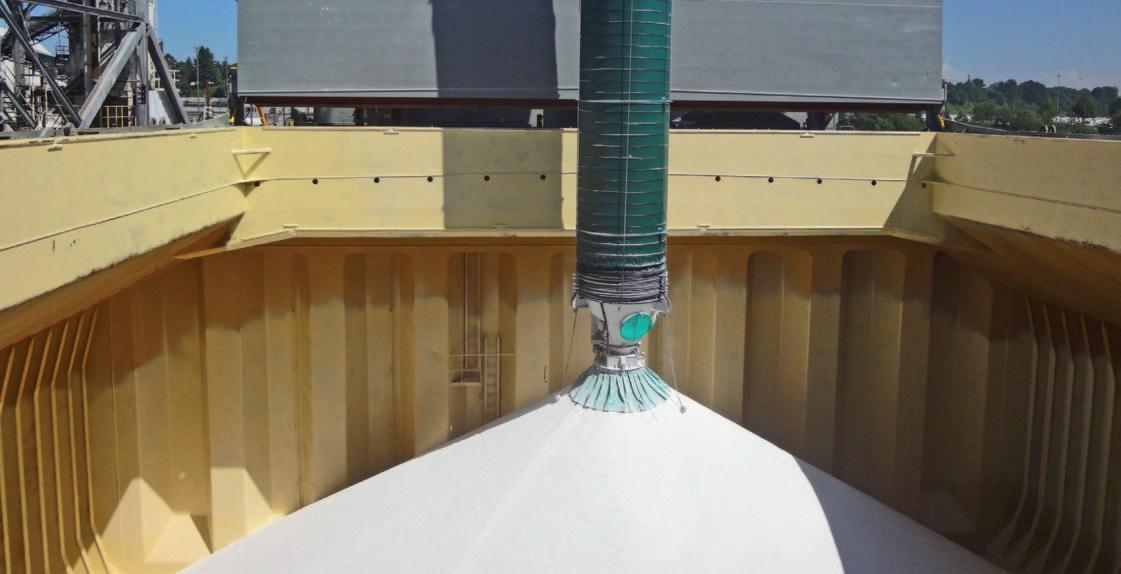
Our worldwide reputation is built on high quality, well-engineered, robust, high performance chutes, backed up by excellent customer service and global lifetime product support.






Contact Cleveland Cascades Ltd Unit 22, Dukesway, Teesside Industrial Estate, Thornaby, Stockton-on-Tees, Cleveland, TS17 9LT, United Kingdom Tel: +44 1642 753260 | Fax: +44
753270 E-mail: enquiries@clevelandcascades.co.uk | Website: www.clevelandcascades.co.uk
Cleveland Cascades Ltd Global leader in bespoke dry bulk loading chutes
1642
Cleveland Cascades are Specialists in the design and manufacture of bespoke dry bulk loading chutes.
Ship Loaders
Loaders Truck Loaders
Loaders
Silo
Tanker
The world has changed since early 2020, with significant disturbances to the global economy. Although raw material availability patterns have been greatly affected, there has been a strong revival of investments in the cargo logistics chain. This picture shows a recently installed multi cereal pneumatic unloader from VIGAN in the northern part of Germany.
Vigan Engineering 16 Rue de l’Industrie B-1400 Nivelles Belgium
T: +32 67 89 50 41 E: info@vigan.com
PUBLISHERS
Jason Chinnock jason@dc-int.com
Andrew Hucker-Brown andrew@dc-int.com
EDITORIAL
Louise Dodds-Ely Editor louise@dc-int.com
Jay Venter Deputy Editor editorial@dc-int.com Samantha Smith Directories directories@dc-int.com Bernice van Wyk Office Manager accounts@dc-int.com
SALES
Matthew Currin Senior Sales sales2@dc-int.com Executive Zack Venter Advertisement Sales sales@dc-int.com Executive
CORRESPONDENTS
Brazil Patrick Knight India Kunal Bose Asia David Hayes Europe Barry Cross Malaysia Wira Sulaiman Philippines Fred Pundol South Africa Iain McIntosh UK Maria Cappuccio UK Michael King UK Richard Scott USA Colby Haines USA Walter Mitchell
ADMINISTRATIVE OFFICE
Business Publishing International Corporate Park, 11 Sinembe Crescent La Lucia Ridge, South Africa, 4051 Tel: +27 31 583 4360
Fax: +27 31 566 4502
Email: info@dc-int.com Twitter: twitter.com/drycargomag

HEAD OFFICE
Trade Publishing International Limited Clover House, 24 Drury Road, Colchester, Essex CO2 7UX, UK
Tel: +44 (0)1206 562552 Email: info@dc-int.com Website: www.drycargomag.com Twitter: twitter.com/drycargomag ISSN 1466-3643
Insta: www.instagram.com/drycargointernational
Trade Publishing International Ltd does not guarantee the information contained in Dry Cargo International, nor does it accept responsibility for errors or omissions or their consequences. Opinions expressed herein are not necessarily those of Trade Publishing International Ltd
Int’l Ltd 2022
TRADE & COMMODITIES
Solid support from coal trade 2
The EU is buying more South African coal to replace Russian shipments 4 WAR, VOLATILE ENERGY & TIGHT SUPPLIES, RATION FERTILIZER USE 6
SHIPPING & TRANSPORT
A brand-new Ex instrument you cannot afford to miss 14 A HANDYMAX BULK CARRIER FREIGHT MARKET RETREAT 17
PORTS, TERMINALS & LOGISTICS
Celtic Freeport consortium announce chair to spearhead bid 25 Terminal Marítima de Cartagena begins operations 25 National Ports unveils the Mobidock™ 26 Port of Barcelona and PowerCon: electrical power to ships at the BEST terminal 27
ENGINEERING & EQUIPMENT
UK’s first ZW310-7s wheel loaders delivered to Norfolk quarry 38 LIEBHERR LHMS AT PORT OF DOVER POWERED BY HVO 100 40 ENHANCING PRODUCTIVITY WITH ENERGY EFFICIENT SOLUTIONS FROM SEMPERIT (SEMPERTRANS) 44 CLEVELAND CASCADES TO SUPPLY SYSTEM TO HANDLE IRON ORE CARGOES 48 WHY THE RIGHT TOOLS MATTER WHEN HANDLING AND STORING CEMENT 50 GROWING FERTILIZER MARKET NEEDS CAREFUL HANDLING 80 ITALIAN EQUIPMENT MANUFACTURERS 89
BREAKBULK & BAGGING
Port of Arendal adds LHM 550 97 PACKAGE DEAL: BULK BAGGING & FIBCS 99
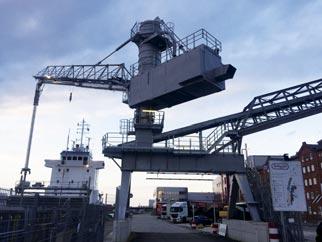
DRY CARGO international DC i
NOVEMBER 2022 issue
featuring... WWW.DRYCARGOMAG.COM
DC
© Trade
CONTENTS 1 NOVEMBER 2022 DCi www.drycargomag.com
i
Publishing
Solid support from coal trade
Amid dampeners on economic activity in many countries, commodity import demand is experiencing a weaker trajectory. The broad pattern of global seaborne dry bulk trade consequently appears to be losing momentum, with a flat or lower trend becoming a more likely outcome in the short term.
In a sombre assessment published last month, the International Monetary Fund concluded that “the global economy is headed for stormy waters”. World growth in gross domestic product during 2022 is now forecast to slow to around half of last year’s recovery from the pandemic, followed by a further deterioration in 2023. China, Europe and the USA — the three largest economies — “will continue to stall”, as the energy and inflation crisis and Covid effects persist.
COAL
Seaborne coal trade has been a beneficiary this year of turmoil in global energy markets, and may continue to derive further advantages next year also. Several reliable forecasters are suggesting that, after last year’s upturn, world coal trade is staying flat in the current year but could resume an advance in the period ahead.
A recent evaluation by analysts at the Australian Government’s industry department estimated world coal trade (including land movements, but mostly seaborne) in 2022 at 1,347mt (million tonnes), a minimal 5mt below the previous annual figure.
Both steam and coking coal movements are expected to increase in 2023, raising the total by 25mt or 2%, to 1,372mt, despite a possible continued weakening trend in China’s steam coal purchases.
IRON ORE
Steel production in numerous countries is facing challenges which are likely to exert downwards pressure on raw materials consumption and imports for some time. Major importers China, Europe, Japan and Korea seem quite likely to see lower volumes of iron ore received this year (compared with the previous twelve months).
Prospects for steel demand next year, with implications for iron ore trade, reflect present uncertainty about the main influences and potential for negative events. The World Steel Association’s latest short range outlook published last month estimated unchanged steel demand in Japan during 2022, but declines of about 3 4% in China, Korea and Europe. In 2023 changes varying between a marginal reduction and a small increase in these countries are expected.
GRAIN & SOYA
About half of the global trade reduction envisaged in the wheat plus corn and other coarse grains segment, during the current 2022/23 crop year, is comprised of China’s expected import reduction. Other decreases are spread among importing countries. International Grain Council calculations show the world total
falling by16mt or 4%, to 408mt, after a marginal decrease in the preceding twelve months.
Following the exceptionally high wheat and coarse grains purchases seen in 2020/21, when the total reached 61mt, China’s trend has been downwards, to 53mt in 2021/22 and a forecast 45mt in the current year. Improved Chinese harvests have been one influence, with extra domestic supplies of corn in particular supporting stocks and boosting livestock feed availability, enabling imports of this grain to be curtailed.
MINOR BULKS
Agricultural commodity seaborne movements within the minor bulks category include miscellaneous oilseeds and meal, rice and sugar. The global total is estimated to have reached about 120mt in 2021 despite lower sugar trade, and a similar volume may be seen in the current year.
BULK CARRIER FLEET
The largest size group within the world fleet of bulk carriers consists of Capesize ships (vessels of 100,000 deadweight tonnes and over), which statistically includes larger Newcastlemaxes and ore carriers. Table 2 shows that this fleet has been growing by 4% annually in the past three years, reaching 377 million dwt (1,912 ships) at end 2021 according to Clarksons Research data.
A lower growth rate is likely this year because of greatly reduced newbuilding deliveries.
BULK CARRIER TRADE & FLEET OUTLOOK 2 NOVEMBER 2022 DCi www.drycargomag.com
2017 2018 2019 2020 2021
121.0
116.8
South
China#
Total of above
source: various & BSA estimates #excluding lignite *BSA forecast TABLE 1: STEAM COAL IMPORTS IN KEY ASIAN COUNTRIES (MILLION TONNES) 2017 2018 2019 2020 2021 2022* Newbuilding deliveries 15.3 14.3 19.0 25.0 19.0 11.0 Scrapping (sales) 6.4 3.1 5.9 11.4 3.4 4.0 Losses 0.3 0.0 0.0 0.5 0.0 0.0 Plus/minus adjustments 0.1 -0.1 0.0 0.0 0.0 0.0 Fleet at end of year 323.9 335.0 348.1 361.2 376.8 383.8 % change from previous year-end +2.8 +3.4 +3.9 +3.8 +4.3 +1.9
forecasts
(100,000DWT
by Richard Scott, Bulk Shipping Analysis, Tel: +44 (0)12 7722 5784; Fax: +44 (0)12 7722 5784; e-mail: bulkshipan@aol.com
2022* Japan
119.8
110.4 119.0 122.0
Korea 116.0 117.5 109.9 93.2 94.3 96.0 Taiwan 58.2 58.4 56.8 52.9 58.2 56.0
118.7 122.4 124.6 132.3 150.4 125.0 India 152.7 171.3 186.2 161.3 148.0 170.0
566.6 589.4 594.3 550.1 569.9 569.0
source: Clarksons (historical data) & BSA 2022
*BSA forecast TABLE 2: CAPESIZE
& OVER) BULK CARRIER FLEET (MILLION DEADWEIGHT TONNES)
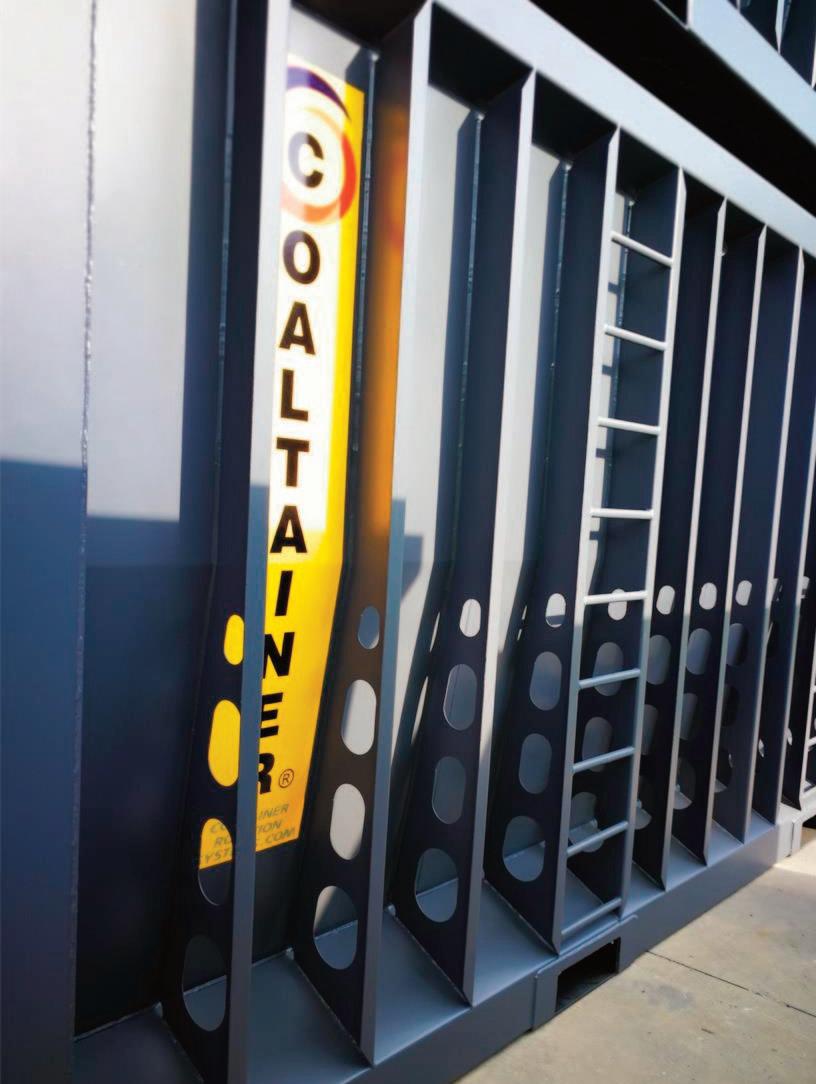
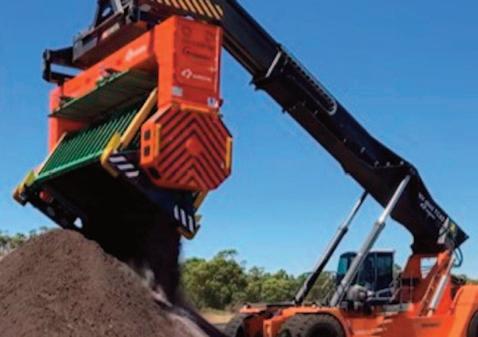
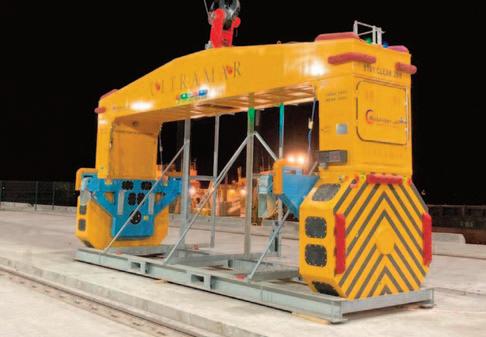
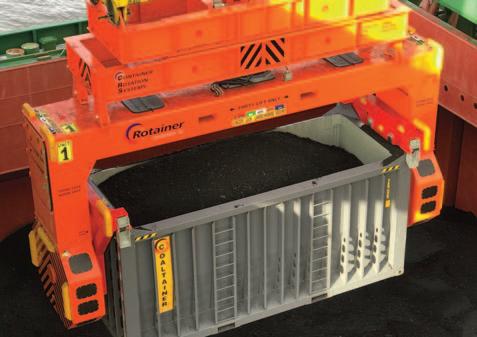



W W W . R O T A I N E R . C O M Reach Stackers – Ship Gears – Ship To Shore Cranes – Mobile Harbour Cranes – Gantry Cranes Eurospec 32 For Ships Cranes Diesel/Hydraulic Remote Control Eurospec 38 For MHC Diesel/Hydraulic or Electric/Hydraulic Optional CRS Lid lifting Eurospec 38 For STS Electric/Hydraulic Optional Rotating Headframe Eurospec MH 42 Material Handler and MHC Electric Hydraulic Optional CRS ‘E’ Link Eurospec 38 R.S Reach Stacker Diesel/Hydraulic Remote Control
The EU is buying more South African coal to replace Russian shipments
In the first three quarters of this year, South African coal exports to Europe amounted to 9.6mt (million tonnes), up a staggering 528% year-on-year.
Although India remains South Africa’s main customer, the European Union is now in second place with a 20% share of total output. The rise of South African coal in
Europe has come about because of sanctions imposed on Russian coal by politicians in Brussels. Indeed, Russian coal imports in the first three quarters were down 26.3% to 20.5mt.
In terms of coal exporters, South Africa is now the fifth largest globally, behind Indonesia, Australia, Russia, and the US. It
Glencore is a major coal miner in South Africa.

exports accounted for 5.4% of all global coal exports in the first three quarters.
Ironically, South Africa’s coal exports to both India ( 29.5%) and China (32.1%) have declined as these countries have benefited from cheaper Russian coal. Indeed, Russian coal exports to India are now up around 130% on the year. Barry Cross
Ukraine Grain Corridor officially extended

The Black Sea Grain Initiative was officially extended for a further 120 days, starting on 19 November, as agreed by the parties to the Initiative.
Three vessels left Ukrainian ports on 17 November carrying a total of 98,840 metric tonnes of grain and other food products under the Black Sea Grain Initiative. On the same day, one inbound vessel transited the maritime humanitarian corridor under the Black Sea Grain Initiative heading towards Ukrainian ports.
As of 17 November, the total tonnage of grain and other foodstuffs exported from the three Ukrainian ports is 11,186,228 million metric tonnes. A total of 941 voyages (470 inbound and 471
outbound) have been enabled so far.
As per procedures agreed at the Joint Coordination Centre (JCC), all participants co ordinate with their
respective military and other relevant authorities to ensure the safe passage of commercial vessels under the Black Sea Grain Initiative.
The JCC monitors closely the passage of commercial vessels through the maritime humanitarian corridor.
The Joint Coordination Centre was established under the Black Sea Grain Initiative in Istanbul on 27 July 2022. It comprises senior representatives from the Russian Federation, Türkiye, Ukraine and United Nations and its role is to enable the safe transportation, by merchant ships, of grain and other foodstuffs and fertilizers from three key Ukrainian ports in the Black Sea to the rest of the world.
TRADES & COMMODITIES 4 NOVEMBER 2022 DCi NEWS www.drycargomag.com

War, volatile energy & tight supplies, ration fertilizer use
The global economy faces steep challenges, shaped by the Russian war in Ukraine, a cost-of-living crisis caused by persistent and broadening inflation pressures, and a slowdown in China. A third of the countries that make up the global economy are poised to contract. The International Monetary Fund growth forecast is lower at 2.7% for 2023. The largest economies, the US, China and the euro area will continue to stall. This year’s shocks added to lingering pandemic woes, the policy of zero tolerance as Covid cases in China rise prompting further shut-downs; for many
people 2023 will feel like a recession. Rapidly rising prices, especially food and energy are causing serious hardship for all, especially the poor. Inflation pressures extend well beyond food and energy are more persistent peaking at 9.5% this year falling to 4.1% by 2024.
Global food and feed markets despite experiencing searing drought and floods, look to be supplied with large cereal and record oilseed crops projected at 3.39bn/t in 2022/23. Russia’s war in Ukraine has created great uncertainty shifting prices higher threatening food security, as global

stocks especially for wheat and corn are at historic lows. Agricultural prices have eased although not because production will improve significantly, more due to weaker demand. Since July, the Black Sea Grain Initiative, provided scope for Ukraine to export 9mt (million tonnes) of grains and oilseeds. On 17 November, the agreement was extended for a further 120 days from 19 November.
FOOD, FARMING TO BECOME MORE SUSTAINABLE
The theme for the UN’s Food and
TRADE & COMMODITIES 6 NOVEMBER 2022 DCi www.drycargomag.com
Maria Cappuccio
Fertilizer handling at the UK’s Port of Ipswich (photo: Helen McHenry).

Santos welcomes largest-ever fertilizer vessel
The Port of Santos has handled its largest ever fertilizer vessel. The Red Marlin, which is 229 metres long, had arrived from the Port of Huanghua, China, with 82,500 tonnes of ammonium sulphate on board.
The consignment of fertilizer once off-loaded at the terminal, was sent by rail to Brazil’s West-Central zone, which is the largest production area for soybeans and corn.
Wilson Sons, the vessel’s charterer, notes that there has been an increase in the volume of fertilizer being moved in Brazilian ports this year.

Agricultural Organisation (FAO) World Food Day, “Safe food today for a healthy tomorrow” highlights the way to improve long-term health benefits for people, the planet and the economy. While, enough food is produced to feed the world, wellover 800m people go hungry. There are several contributory factors, not least the impact of war in Ukraine, the energy crisis, changing climate as farmers find their sources of income and food are at risk from unpredictable downpours and droughts. At the November COP27 climate talks in Egypt, FAO’s Deputy Director Zitouni Ould-Dada confirmed, the FAO will launch a plan to show how
together the food industry and farming can become more sustainable with the goal of capping global warming at 1.5° Celsius. He hoped this would spur investment into companies, projects and technologies aligned with the plan.
FERTILIZER USE EXPECTED TO RECOVER IN 2024
Demand for fertilizers remains driven by solid fundamentals, though market conditions vary between regions and crops. While global grain prices so far remain supportive, surging input costs and disrupted supplies have significantly impacted the availability and affordability of
Barry Cross
crop nutrients, and lowered fertilizer application rates, some regions seeing a pronounced slowdown in buying. Earlier in the year the International Fertilizer Association (IFA) included preliminary estimates for each nutrient for the five years to 2026. In the table below the IFA’s min/max range is used, with fertilizer use expected to recover until after 2024.
FARMERS SECURE FERTILIZERS IN ADVANCE
Given ongoing risks of nitrogen shortages in Europe and price spikes during winter, should natural gas availability deteriorate, some farmers took advantage of a dip in prices to secure part of their fertilizer
TRADE & COMMODITIES 8 NOVEMBER 2022 DCi www.drycargomag.com
needs for spring 2023. The FAO calculate the global agricultural input bill to reach $424/bn in 2022 a near 50% increase on last year. The sharp increase is almost entirely due to soaring cost of inputs and disrupted food supply chains while growth in imports remains subdued.
FERTILIZER PRICES EASE BUT WELL ABOVE HISTORICAL NORMS
Yara confirmed it has reopened facilities and operating at 65% of its European ammonia capacity. This came after the company cut output to just over one-third of its total capacity for much of the second half of 2022. The move is in sync with other European fertilizer producers as European natural gas prices have fallen sharply in recent weeks due in part to milder temperatures and fuller-than-average gas storage facilities. European fertilizer output is about 63% of total capacity compared to 37% at the beginning of October. CF Industries believes producers in Europe and Asia will continue to face high energy costs into at least 2025, that will continue to challenge producer economics in those regions. Natural gas prices are still much higher than before the war in Ukraine, which threatens to keep a lid on production for some time, according to Chris Lawson, head of fertilizers at CRU. “We’re back to (price) levels seen at the same time last year, but they’re still well above historical norms.”
DAP PRICES FELL BY 11% IN THE THIRD QUARTER
DAP prices have been supported by rising input costs, especially ammonia, due to natural gas prices. Some countries like Brazil experienced strong phosphate demand to support soybean acreage and in India to boost low fertilizer stocks. Higher prices softened demand and the war in Ukraine induced a substantial reduction in the acreage planted. China accounts for 30% of global trade in DAP, the decision to impose export restrictions has had a material effect on supply. China’s DAP exports fell 55% during the first eight months of this year. Following large gains earlier in the year DAP prices are projected to fall in 2023 and 2024.
MOP contract prices remained unchanged in the third quarter having risen earlier in the year. Spot prices retreated due to lacklustre demand, notably in North America. The market remains tight due to reduced supply from Belarus — with exports cut by 40 60% and Russia by 20 25%, together they account for around two-fifths of global potash exports.
1961/2 2025/26 mt nutrients
Year Nitrogen Phosphate Potash Total 1961/2 11.6 10.9 8.7 31.2 1970/1 31.8 21.1 16.4 69.3 1980/1 60.8 31.7 24.2 116.7 1990/1 77.6 36.0 24.6 137.8 2000/1 81.2 32.5 21.9 135.6 2001/2 82.9 33.4 23.0 139.3 2002/3 85.1 34.1 24.7 143.9 2003/4 87.1 35.2 25.5 147.8 2004/5 90.2 37.5 25.6 154.7 2005/6 93.2 37.0 26.3 156.5 2006/7 97.4 38.1 26.9 162.4 2007/8 100.5 38.4 28.9 167.9 2008/9 97.7 33.7 23.4 154.8 2009/10 102.2 37.6 23.7 163.5 2010/11 104.1 40.6 27.5 172.3 2011/12 107.9 41.4 28.0 177.2 2012/13 108.6 41.4 29.2 179.1 2013/14 109.9 40.5 30.4 180.7 2014/15 110.3 41.1 32.0 183.4 2015/16 108.0 41.0 32.0 181.0 2016/17 107.7 46.0 35.3 189.1 2017/18 107.9 46.7 36.9 191.5 2018/19 105.6 45.5 37.1 188.2 2019/20 108.2 46.5 37.0 191.7 2020/21 113.7 49.7 40.4 203.8 2021/22 113.5 48.5 38.6 200.6 2022/23e 106.6-112.0 45.6-49.0 34.6-40.0 186.8-201.0 2023/24e 108.0-114.0 46.0-51.0 35.0-42.0 189.0-207.0 2026/27e 110.0-116.0 47.6-52.0 37.0-43.1 194.6-211.1
Source: FAO, IFA
Following the Russian war in Ukraine, fertilizer exports from Belarus were blocked from global markets, as sea, rail transit through EU countries, was denied. The Russian fertilizer industry is not subject to sanctions, but logistical issues limits exports from Russian ports. Robust fundamentals are expected to support increased potash consumption in 2023.
US WHEAT, CORN ACREAGE TO RISE AT THE EXPENSE OF SOYBEANS IN 2023/24
Preliminary forecasts for US plantings, indicate soyabeans are expected to give up acreage to corn and wheat in 2023/24. US farmers are expected to expand the area for corn plantings to 92m/acres — with production pegged at c.387mt (15.265bn/bu) on average yields of 181.5/bpa; for wheat the increase in area is expanded to 47.5m/acres on average yield of 49.2/bpa with wheat production pegged at c.52.8mt.
Wheat continues to be acutely affected by the Russian war in Ukraine-Rabobank sees a 6mt deficit for wheat next year due to uncertain weather prospects in the EU, US and Argentina.
TIGHT GRAIN INVENTORIES IN 2022/23
Persistent drought conditions in northern hemisphere countries have prompted a significant cutback to the global wheat crop recently estimated at 783mt in 2022/23 marginally higher than last year due mainly to better crops in Russia and Canada; partially offset by smaller and poorly rated crops in the US 45mt, EU135mt and Ukraine where the crop was reduced by over 12mt to 20mt due to the war. The Rosario Board of Trade has further downgraded the Argentine wheat crop to 11.8mt (USDA 15.5mt) after frosts compounded the drought, further decreasing yields with only 8 per cent of the crop in good to excellent quality. While Australia yields are strong, heavy rains, flooding have increased the risk of quality losses in eastern areas.
GLOBAL WHEAT STOCKS TIGHTEST IN YEARS 2022/23
Less food, feed and industrial use reduced global wheat consumption to 791mt; trade rose by 2mt to 207mt on better exports from Canada.
Global wheat stocks of 124mt
TRADE & COMMODITIES 9 NOVEMBER 2022 DCi www.drycargomag.com
GLOBAL FERTILIZER USE
2018 2019 2020 2021 2022 Oct Wk2 Oct Wk2 Oct Wk2 Oct Wk2 Oct Wk3
Urea $ $ $ $ $
Baltic 260 237.8 245 418.8 678
Persian Gulf 320 255-257 270 800 678
US Gulf 350 296 230.5 240 700
Ammonia
Yuzhny 320 322 225-230 220 700 —
Tampa CFR 330 255 228 558 1,175
Middle East 359 369 — 1,200
Ammonium sulphate — — — FSU 118
Asia 142.50 114 126
Di-ammonium phosphate
North Africa 409 —
US Gulf 421.50 271-280 360 727 752
China 414 310-316 357 — 514
Baltic 426 304 340 — 731
Triple super phosphate
North Africa 358 313 —
US Gulf 346 270 290 618 708
Muriate of Potash
Baltic 290 190 220* Vancouver 215.5 265.5 245 230* 562.50
US Gulf 268 280 202 740
Source Bloomberg, Farm Futures, Fertilizer Week, Fertilizer Market Bulletin, Profercy *Contract prices
(excluding China 144mt) are heading towards the tightest grain inventories in years on reduced harvests and stocks in the major exporting countries; elevated prices are forecast to persist. CBOT Futures Dec Contract for Wheat closed up at 8.476$/bu (4 Nov ‘22). Spot prices of Argentine Grade 2 wheat (Up River) $413/t, EU France Grade 1, Rouen $337/t and US HRW (Gulf) $427/t. (3 Nov ‘22).
LOWER OUTPUT, RISING PRICES CUT COARSE GRAIN USAGE
Coarse grain output is forecast lower in 2022/23 at 1.46bn/t. This is mostly due to hot, dry weather, which curbed yield prospects and lowered output for US corn by 34mt to 364mt. Severe drought affected a number of other countries including the EU where corn output fell to 55mt.
Reports in Ukraine indicate 10% of planted corn areas may not be harvested with output c.25.8mt (USDA 31.5mt) as farmers face fuel/storage shortages. With reduced global supplies of coarse grains and rising prices demand for feed/food/industry fell to 1,468mt in 2022/23. The drop in output further tightened already low global coarse grain stocks of 119mt (excluding China 207mt).
CORN SPOT AND FUTURES FIRM
South Korea’s Major Feedmill Group (MFG) purchased 134,000mt of corn at $330-$331/t for arrival in February ’23; the Korean Feed Association (KFA) bought 65,000/t of corn in a private deal priced at $332.45/t plus $1.50/t for additional port discharges. Ukraine’s grain exports have resumed, with FOB basis $2.50/bu below
US Gulf origin. Slow US corn exports due to a strong dollar, while challenging Mississippi River conditions, hampered grain deliveries and raised freight rates. US domestic values have held-up due to strong domestic demand for ethanol and feed. CBOT Corn Dec ‘22 closed up at US $6.80/bu (4 Nov ‘22).
RECORD HIGH GLOBAL OILSEEDS IN 2022/23
Global production of major oilseeds is forecast to rise to a record 646mt in 2022/23, mostly driven by soybeans 391mt, with US output 118mt and potentially large growing crops under way in Brazil 152mt and Argentina 50mt. For other oilseeds, gains are noted for rapeseed 85mt following a recovery in Canada, cottonseed 42mt, palm kernel 21mt, with groundnuts 50mt and copra 6mt unchanged. Lower output for sunflower seed 52mt, due to the war, Ukraine’s sunflower seed crop fell by 7mt to 10.5mt. The protracted drought in Argentina, linked to a third straight La Nina climate pattern has significantly reduced soil moisture and poses a threat for soybean output.
BRAZIL’S FUTURE PRESIDENT TO PROTECT THE AMAZON
The main road to Brazil’s Paranagua port for exports, was blocked by demonstrators protesting against the country’s election results after Luiz Inacio Lula da Silva defeated Jair Bolsonaro to become the next President of Brazil on 1 January. Following his win, he announced that “Brazil is ready to resume its leading role in the fight against the climate crisis, protecting all our biomes, especially the Amazon forest.”
CHINA’S COVID CURBS RATTLES MARKETS
Soybean markets fell on concerns about slowing demand in China, where trade contracted as the country struggles with Covid curbs. Phin Ziebell, agribusiness economist at National Australia Bank summed up the mood, “There are big questions about the end of Covid-zero
Source: USDA-mainly harvested Jul-Dec/ *oilseed meal — excl. fish meal
TRADE & COMMODITIES 10 NOVEMBER 2022 DCi
www.drycargomag.com
FERTILIZER PRICES $ PER TONNE FOB 2017 2022 Prod Prod Use Use Trade Trade Stocks Stocks 21/22 22/23 21/22 22/23 21/22 22/23 21/22 22/23 Wheat 779 783 794 791 205 207 276 268 Coarse grains 1,503 1,460 1,492 1,468 236 226 335 326 Sub-total 2,282 2,243 2,286 2,259 441 433 611 594 Rice 515 504 520 518 55 53 183 169 Total 2,798 2,747 2,806 2,777 496 486 794 763
605
340* 353* 178
Oilseeds
647
198 114 122
GLOBAL CEREALS & OILSEEDS-PRODUCTION, USE & STOCKS 2021/22–2022/23MT
policy and seemingly few answers.” The Chinese government indicated it is sticking to Zero Covid, while easing some restrictions as it grapples with higher infection rates in Beijing and other major cities.
CHALLENGES FOR CROP OUTPUT AND FOOD SECURITY ISSUES
Since last month the major exporters’ bids were little changed, the exception being the US bids increased as low water levels in the Mississippi River, negatively impacted grain deliveries. Prices spiked on news that Russia temporarily suspended its participation in the Black Sea Grain Initiative. Slack export demand, improvements in winter cropping weather and broadly favourable 2023/24 sowings have capped further rises and prices have since retreated. Grain and oilseed values reflect the surging costs of imported energy, labour, fertilizer and other costs behind the increase, that put a strain on low-income and lower middle-income countries resulting in lower agricultural productivity and food availability, likely to extend into 2023.
GLOBAL STOCKS TO USE AT 20-YEAR LOWS REMAIN PRESSURED
Grain and oilseed markets are expected to remain tight through 2022 and 2023. The damage and disruption to Ukraine’s agricultural production caused by war, coupled with poor growing conditions in several major growing regions like the US, Europe, China and Argentina, have resulted in lower global agricultural production. This suggests that global stocks-to-use ratios, already projected at 20-year lows, will remain under pressure and are unlikely to recover in a single season. For this and others reasons most fertilizer producers see elevated crop prices in some regions supporting a return to more typical fertilizer applications in 2023.
SUPPLY AND USE FOR KEY FERTILIZERS
IFA estimates for fertilizer supply and use for the three key nutrients Nitrogen, Potash and Phosphates, were adjusted following the war in Ukraine. Capability was based on the ability of Russia and Belarus to export amid sanctions imposed and logistic issues from Ukraine; Europe (west and central) was also adjusted based on disrupted natural gas supply from Russia and to take into account new plants coming on stream.
The IFA estimate for nitrogen in the table-reflect the min/max range for supply capability and fertilizer use.
US
Wheat No 2 HRW
2018 2019 2020 2021 2022 Oct Oct Oct Oct Oct Wk2 Wk3 Wk3 Wk3 Wk3 $ $ $ $ $
237 213 279 363 432
Corn No 3 Yellow (Gulf) 167 174 230 267 369 Sorghum (Nola) 191 188 293 297* 376 Soybean No 2 (Gulf) 324 364 456 502 603
Brazil (Paranagua)
Soybean 416 380 500 521 601
Corn (feed) 233 274 295
Argentina (Up River)
Wheat 232 228 283 300 426
Corn (feed) 164 174 228 250 310 Soybean 397 356 456 545 594
Thailand
Rice White 5% broken 390 397 449 381 415
Vietnam
Rice White 5% broken 407 353 477 428 424 India
Rice White 25% broken 340 330 342 361 364
Source: FAO IGC USDA—*Monthly average—Sept; Rice prices based on indicative quote
STRONG FUNDAMENTALS DRIVE NITROGEN VALUES
Nitrogen prices have strengthened significantly over the past year, driven by demand growth and supply limitations linked to Chinese exports, the war in Ukraine and sanctions. The tight supply environment remains challenging, primarily as a result of gas price volatility that prompted shut-downs by leading fertilizer producers, Yara and others have recently
reopened their European facilities. Fertilizer inventories remain at historically low-levels; risks remain from nitrogen shortages and price spikes during winter, should natural gas availability deteriorate.
Globally, industry projections show new nitrogen capacity additions are expected to become operational between 2023 25. Following large increases this year, urea prices are projected to fall in 2023 and 2024 as new capacity comes online.
TRADE & COMMODITIES 11 NOVEMBER 2022 DCi www.drycargomag.com
CEREAL EXPORT PRICES US
PER
2020/21 2021/22 2022/23 2023/24 2026/27
capacity 181.5
supply* 155.0* 159 150 160a 155 164a 159.8 169a
140.0
110.0 113.5 106.6 112 108 114 110 116
capacity
capability GLOBAL NITROGEN SUPPLY/DEMAND 2020/21–2026/27 MT N Fertilizer 2020/21 2021/22 2022/23 2023/24 2026/27 Potash capacity 62.5 Potash supply 48.4* 52 41 49a 41.5 50a 42 51a Potash demand 42.1 Fertilizer 38.5 38.6 34.6 40 35 42 37 43.1 Potash balance 6.3
basis * effective capacity derived acapability GLOBAL POTASH SUPPLY/DEMAND 2020/21-2026/27 MT K20
$ FOB
TONNE 2018–2022 Fertilizer
Nitrogen
Nitrogen
Nitrogen demand
Fertilizer use
Other 32.6 N Balance 15.0 Source: FAO/ IFA-data N/t basis * effective
derived a
Source: IFA-Data K20
POTASH MOST EXPOSED TO SUPPLY DISRUPTIONS
The IFA expect potassium to be the most exposed nutrient to capacity disruptions as over 80% of forecast expansions are located in Russia. Large scale projects such as BHP’s Jansen mine in Saskatchewan, Canada is excluded from the IFA’s forecast as it is unlikely to become operational before 2026. The IFA estimate for potash in the table-reflect the min/max range for supply capability and fertilizer use.
INCREASED ACREAGE IN 2023 SUPPORTS POTASH
Favourable weather conditions in North America, are expected to support normal application rates of potash and other crop protection products. South American spring crop planting is under way with a mix of planting conditions — Argentina continues to be impacted by La Niña related drought. By contrast, planting conditions in much of Brazil has generally been favourable-with soybean acreage expected to rise by 3 4%, with a proportional increase in safrinha corn acreage.
Due to sanctions, potash supply from Eastern Europe will continue to be constrained in 2023 — shipments from Belarus to fall by 40 60% and from Russia
Phosph’c acid capacity 59.1
Phosph’c
Phosph’c acid demand 48.8
Fertilizer
Phosph’c acid balance 1.9
Source: FAO/IFA-Data P205 tonnes basis * effective capacity derived a capability
to fall by 15 30% to 2021. Nutrien expect robust agricultural fundamentals to support increased potash consumption in 2023 as inventories are drawn-down and prices stabilize with potash shipments forecast to rise 64 67mt in 2023 an increase of 4-5mt.
PHOSPHATE IMPROVES, SUPPLY ISSUES REMAIN

The IFA forecast that of the three key nutrients, phosphates will be least exposed to capacity extensions in affected countries, because most of the new capacity in the next five years, will be located in Africa and East Asia, outside countries subject to sanctions. The IFA estimate for phosphates in the table reflect the min/max range for supply capability and fertilizer use.
TIGHT GLOBAL PHOSPHATE MARKET TO PERSIST IN 2023
Mosaic confirmed North America sentiment had improved significantly with phosphate application rates in the fall near normal levels, expected to deplete channel inventories. Fertilizer prices in Brazil remain historically high but have recently eased; while government subsidies in India are expected to remain at levels that support phosphate imports. China’s phosphate inventories are expected to fall, with exports cut by 5mt in 2022 — current export restrictions are likely to be extended into 2023. Mosaic forecast global phosphate shipments to rise to 72 76mt in 2023, depending on supply recovery with moderating prices expected to incentivize buyers.
TRADE & COMMODITIES 12 NOVEMBER 2022 DCi www.drycargomag.com
2020/21 2021/22 2022/23 2023/24 2026/27
Fertilizer
51 55a 55 57a
acid supply 50.7* 51a 51 52.0a
48.3 48.5 45.6 49 46 51 47.6 52
GLOBAL PHOSPHORIC ACID SUPPLY/DEMAND 2020/21-2026/7 MT P205 DCi
InterManager welcomes IMO commitment to address enclosed space risks
InterManager has welcomed a commitment by the International Maritime Organization (IMO) to review guidance governing safe working in enclosed spaces onboard ships.

Heralding the move as a significant step forward in crew safety, the association says it will work with the IMO, Flag States, and other maritime partners to ensure that lessons are learned from the many fatalities which have occurred in enclosed spaces and also, new legislation is workable and effective.
InterManager submitted a comment paper to the IMO’s Maritime Safety Committee (MSC) 106 meeting, cosponsored by a number of industry partners, in response to China’s proposal to revise IMO Resolution A.1050(27) which sets out recommend ations for entering enclosed spaces aboard ships. InterManager’s paper highlighted additional information which it believes should be considered and provided high level information relating to enclosed space incidents.
The ship and crew management trade body has been collating statistics on deaths and accidents in enclosed spaces since 1999 and reports that during this period, enclosed spaces have claimed the lives of 122 seafarers and 45 shore workers. However, InterManager Secretary General, Captain Szymanski, fears these figures could be higher still and says he believes there is under-reporting by shipping authorities.
“This is an opportunity for the shipping industry, led by the IMO, to comprehensively assess the dangers posed by the range of enclosed space and oxygendepleted areas onboard ships and to make meaningful recommendations which will remove or reduce risk, backed up by robust procedures that should aim to ensure no seafarer or shore worker dies while carrying out their jobs,” he said.
In its submission, InterManager and its co-sponsors recommend that the IMO Resolution A.1050(27) be considered by suitably competent sub-committees which should also consider emergency drills for
enclosed spaces, the carriage of gas detection equipment on board ships, and MSC.1/Circ.1401 dealing with vessels inerted with nitrogen, plus the associated risks and hazards. It advises re-examination of previous submissions to address issues already raised, such as cargo hold gas monitoring, an appreciation of oxygen depleting cargoes, cargoes which are fumigated and cargoes which emit toxic gas.
It states: “The scope of the revision needs to be broad and comprehensive in order to take into account both the human element and ship design factors that have contributed to previous enclosed space incidents. This would undoubtedly mitigate against, and hopefully prevent, such incidents occurring in the future.”
The submission highlights a need to consider design of access as a means of reducing the number of such incidents, pointing out the risks posed by areas such as hold access ladders, specifically the enclosed trunk ladder (occasionally referred to as the ‘Australian Ladder’).
InterManager points out that previous submissions on enclosed space risks have discussed “the repetitive systemic nature of the enclosed space incidents” and this is a
matter that InterManager has campaigned about, urging the shipping industry to delve deeper into accident investigations to look at the ‘why’ as well as the ‘how’.
The submission draws attention to industry-led investigations into enclosed space accidents, commenting: “These reviews have resulted in the emergence of several distinct themes focussing on; design and construction, gas evolution, movement and entrapment within the ship structure, and the human element prevalent in many enclosed space incidents, such as the rush to rescue a single casualty resulting in the death of many, the disregard of procedures and local adaptation of unsafe practices. Likewise, it has been identified that in many cases ship and shore personnel are subject to time pressure which may result in them rushing or missing checks to meet artificial deadlines which often result in entry into spaces for which they are not fully prepared. These aspects have resulted in countless casualties where a known breach of procedure, (just a ‘quick look inside!’) in an enclosed space, has often ended in further loss of life.”
The submission states: “In order to reduce, indeed halt, such needless loss of life within the complexities and risks of the maritime world, the review of A.1050(27) needs to be comprehensive, in depth and as wide-ranging as possible in order to encapsulate the breadth of such studies. A new resolution on the recommendations for entry into enclosed spaces would go a long way towards avoiding the unnecessary deaths of seafarers and shore-workers.”
IMO MSC106 agreed that the MSC107 meeting, scheduled for June 2023, will draw up a plan for the revision of IMO resolution A 1050/27 in relation to Enclosed Space Entry Procedures. Responsibility for the output will be spear-headed by the CCC Sub-Committee, which next meets in September 2023, in association with five other IMO Sub-Committees, as and when requested by CCC, with a target completion year of 2024.
13 SHIPPING & TRANSPORT NOVEMBER 2022 DCi NEWS www.drycargomag.com
A brand-new Ex instrument you cannot afford to miss
Since the Materials Testing Exhibition kickstarted the launch of Cygnus 1 Ex gauge, the company has highlighted many of its unique features; however, there is much, much more to this impressive piece of tech than meets the eye.
For those who work in the following industries, this gauging device is an invaluable leap forward for safety. oil and gas; v mines; v chemical plants; v fuel depots; v road tankers; v oil and gas tankers; v explosive atmospheres; and v
hazardous storage tanks. v
A CLOSER LOOK AT CYGNUS 1 EX’S ADVANCED FEATURES
Cygnus 1 Ex provides a first-class experience in user control and flexibility — unmatched within intrinsically safe UT measurement. Users can adjust the complexity of the settings to suit their level of experience.

The great news for advanced users is, beyond Cygnus’ 3 measurement modes (Multiple-Echo, Single-Echo and EchoEcho), the Manual Measuring Mode allows you to manually adjust the gain and gates to suit your application. Like a flaw detector, it
features two gates which you can manually position anywhere on the A-scan, and you can alter the gate height, start-point and width. With these two gates, you have the option to take a measurement from the first gate or between gates. Further still, if the second or third echo is rather weak, the Time-Controlled Gain (TCG) enables you to introduce different gains to boost the weaker echo(es) whilst keeping the first echo the same. Such versatility makes measurements on tricky areas more easily and more accurately.
When it comes to storing your data, you have just as much flexibility. Comprehensive data-logging offers linear
SHIPPING & TRANSPORT 14 NOVEMBER 2022 DCi NEWS www.drycargomag.com
and 2-D grid formats, and users have 16 grid patterns to choose from according to preference. Radial points can be used to further investigate an area of interest around any measurement, attaching up to 12 measurements ‘around’ the principle measurement in a ‘clock-face’ pattern. Plus, you can add comments to any measurements to assist at the point of analysis.
What’s more, measurement settings can be saved as a measurement setup file for restoring when next time the gauge is used.
No matter how complex your logging process is, the gauge is designed to give seamless data analysis and report generation using Cyglink, easily connected to via BluetoothTM or a data port. The CygLink software manages data logger records, Ascans, B-scans, templates, measurement comments and material velocity tables; and can generate PDF reports and export to Excel. It also displays A-scans and B-scans, allowing for afterthe-event analysis of logged measurements.

Flexibility is also key in the operations of the gauge — all designed with ease of use, time efficiency and the practicality of working in challenging environments. Two rechargeable batteries provide eight hours of uninterrupted, continuous measurement. Users can quickly switch the screen between a light or dark background to adapt to indoor and outdoor lighting.
The display also gives four measurement screens: Measurement, A-Scan, Data-logging, and B-Scan, which can be easily rotated using the left and right navigation keys. Positioned just below the display are four coloured function keys – giving you easy control and quick access to dynamic functionality.
The Cygnus 1 Ex is the only one of its kind in the world certified to ATEX, IECEx, UKEX for Zone 0 and NRTL for Class 1, Division 1 available today. Like all Cygnus products, it is manufactured in the UK.
SOME THINK THAT RAW MATERIALS TRANSPORT REQUIRES TRUCKING.
WE THINK DIFFERENT.
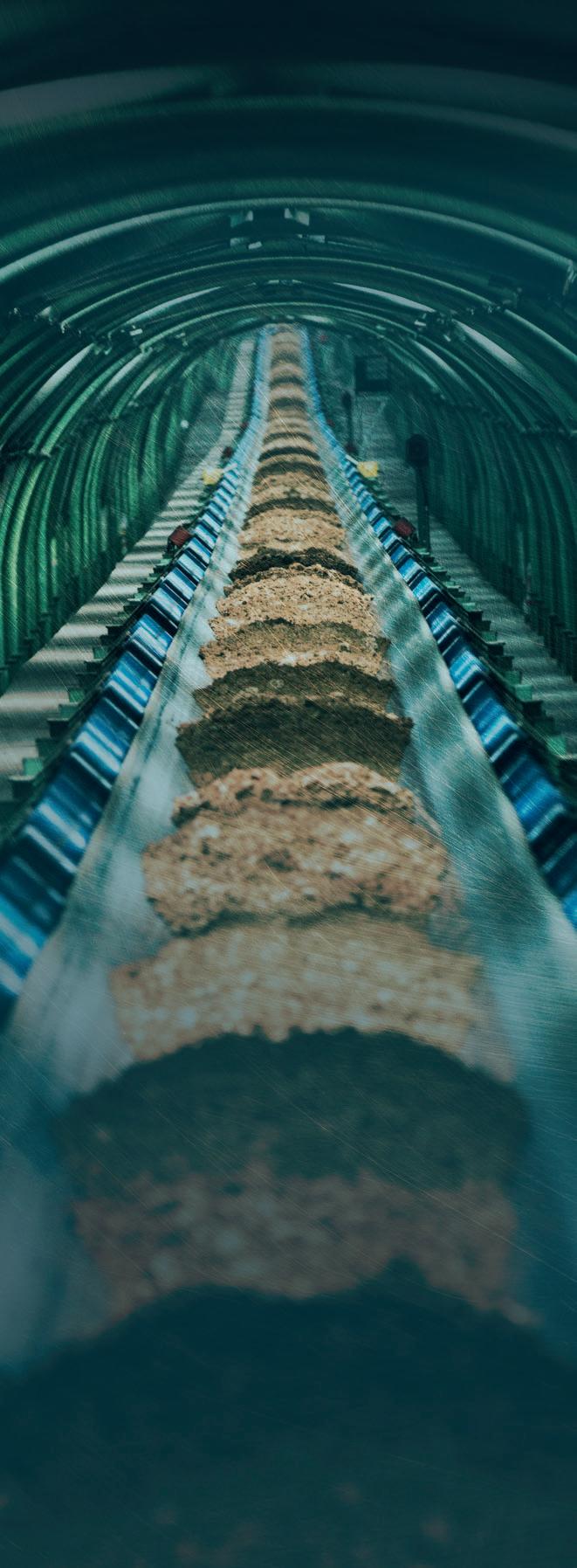
beumer.com

A Handymax bulk carrier freight market retreat
After an abrupt setback twelve months ago from remarkably high levels, the Handymax bulk carrier freight market recovered but in the past six months has seen a weakening pattern resume. Shipowners and charterers have experienced freight rates varying within a wide range during 2021 and 2022. The outlook over the next twelve months for the global demand/supply balance for these bulk carriers points to a number of influences which could provide support.
Handymax bulk carriers — medium-size dry cargo vessels with a carrying capacity of between 40,000 deadweight tonnes and 70,000dwt — embrace many commodity trades. Notable sub-categories within the size group are the Supramax and Ultramax vessels, which successively gained most attention.
Investment in Handymax bulk carrier newbuildings has been sustained by

shipowners’ cautious optimism about longer term future growth in the relevant global trades, encouraging confidence in ongoing employment prospects. Perceived potential for replacing existing ships with tonnage of greater efficiency enhanced attractions. These vessels’ adaptability ensures extensive as well as varied employment on numerous routes. Steady world fleet growth of 3 4% annually in this segment in recent years reflected the popularity.
VERSATILITY BENEFITS
The inherent appeal of Handymaxes is explained by specific design features. A typical ship of this type is a ‘geared’ vessel (cargo-handling gear installed on board), equipped with cranes and grabs for loading and discharging cargo. This feature is included in the distinctive sub-categories of larger ships within the Handymax size
group, the Supramax and Ultramax vessels.
Within the bulk carrier fleet as a whole, bigger capacity units — Panamax, Kamsarmax, Capesize and Newcastlemax bulk carriers — usually are ‘gearless’ (no installed cargo-handling equipment on board) and therefore are totally dependent on loading and discharging equipment at ports. An advantage of being geared is that this equipment allows efficient operation in trades where shore-based facilities are either unavailable, or inadequate. Handymax gear also often assists handling cargo from or into barges moored alongside, at an offshore anchorage or river berth.
Another benefit is the Handymax dimensions — length, beam and draught — suitable for many ports around the world, on most trade routes. The carrying capacity offers some economies of scale. As a result, varied employment patterns
SHIPPING & TRANSPORT 17 NOVEMBER 2022 DCi
www.drycargomag.com
Richard Scott, Bulk Shipping Analysis
TABLE 1
HANDYMAX (40–69,999DWT) BULK CARRIER FLEET (MILLION DEADWEIGHT TONNES)
2017 2018 2019 2020 2021 2022
Newbuilding deliveries 10.5 5.6 8.2 9.2 7.0 7.0
Scrapping (sales) 3.1 0.7 0.8 1.8 0.6 0.5
Losses 0.1 0.1 0.1 0.0 0.1 0.0
Plus/minus adjustments 0.0 0.2 0.0 0.0 0.1 0.0
Fleet at end of year 194.7 199.7 207.0 214.4 220.6 227.0 % change from previous year-end +3.9 +2.5 +3.7 +3.5 +2.9 +2.7
source: Clarksons (historical data) & BSA 2022 forecasts *forecast
often occur. There is frequent involvement in the coal, grain and soya trades. Numerous cargoes in the minor bulk commodity trades are a prominent feature: steel products, ores and minerals such as nickel ore, other industrial commodity cargoes, fertilizers and various agricultural commodities including oilseeds and meals are carried.
In recent years the preferences of shipowners in new vessels, for employment within these trades, firmly shifted towards higher capacity Ultramax 60 69,000dwt bulk carrier designs at the top end of the Handymax size range. Previously the Supramax, typically 52 57,000dwt, was the preferred unit, taking over from smaller handymaxes below 50,000dwt.
STEADY FLEET EXPANSION
Growth at a moderate pace has unfolded over the past few years in the world fleet of Handymax bulk carriers. Deadweight capacity in the 40 69,999dwt size group increased by an average 3.3% annually in the five years from 2017 to 2021, including 2.9% in 2021 as shown in table 1. In the current year, 2022, a similar rate is foreseen, probably followed by a deceleration next year based on partly speculative assumptions.
At the end of 2021, Handymax fleet capacity reached 220.6 million deadweight tonnes according to Clarksons Research data. Vessels in the size group numbered 3,920. This total comprised under onequarter of the entire 946m dwt world bulk carrier fleet of all vessel sizes. On a longer period comparison, over ten years, Handymax capacity increased by twothirds.
During the 2022 first nine months the handymax fleet has been augmented by more than 2%, boosting the total to 4,000 ships amounting to 225.5m dwt at endSeptember. Newbuilding deliveries remained steady while scrapping has slackened slightly.
Handymax newbuilding deliveries to owners by shipbuilding yards around the
world fell in 2018 to the lowest level since eleven years earlier, followed by a revival to 9.2m dwt in 2020 and 7.0m dwt in 2021. Scrapping of mainly older vessels partly offset these volumes to varying degrees. Demolition sales rose to 1.8m dwt in 2020, from under 1m dwt annually in the previous two years, before receding to well under 1m dwt last year.
A notable trend is changing fleet composition within the Handymax segment. Large differences between the size of newbuildings delivered into the fleet, and the size of old ships sold for demolition is a feature. In 2021 newbuildings averaged 60,300dwt, confirming the popularity of ultramaxes towards the top end of the handymax size range. By contrast, ships sold for scrapping averaged 42,800dwt, with an average 27 years age, representing an earlier era when the original Handymax bulk carrier of 40 50,000dwt size was most popular.
Looking at newbuilding Handymax deliveries during 2022, the total in the year as a whole seems set to be similar to last year’s deadweight volume. This estimate is based upon the pace so far, coupled with expectations for the remaining months. The scrapping volume has been limited because of improved freight market sentiment and second-hand prices, and the annual total could be minimal at below 1m dwt. Although the end of 2022 is approaching, it is still difficult to estimate these elements precisely because there is
some potential for unexpected changes.
SLOWING FLEET AHEAD?
Based on tentative indications it seems likely that slowing fleet growth will emerge in 2023. Newbuilding deliveries may remain fairly steady. But there is potential for these to be offset to a greater extent by much higher scrapping. Fleet evolution is hard to predict accurately, because great uncertainties surround both inflows and outflows of tonnage. These influences will be affected by evolving freight market patterns, and by changing market sentiment and views, so perceptions may change.
Current global orders for new Handymax bulk carriers are set out in table 2, showing the schedule over the next twelve months and further ahead. Newbuilding orderbooks at shipyards, as reported, provide only a rough guide to the amount of future fleet capacity likely to be added within any given period, however. Orderbook slippage and postponements, difficult to predict, often occur while more orders could be added.
As shown, the entire current Handymax orderbook for all future delivery years now totals about 17m dwt, equivalent to 8% of the existing world fleet in this size group, a relatively low percentage. Most of the deadweight capacity on order consists of ultramax vessels, emphasizing how these ships have become the dominant investment focus.
Incentives to invest in new ships are
TABLE 2
HANDYMAX (40-69,999DWT) BULK CARRIER ORDERBOOK (MILLION DEADWEIGHT TONNES)
scheduled orderbook deliveries, not forecasts of actual deliveries 4q2022* 2023 2024/later total 40 49,999dwt 0.2 0.1 0.2 0.5 50 59,999dwt Supramax 0.2 1.0 0.3 1.5 60 69,999dwt Ultramax 1.6 6.1 7.4 15.1 Total 2.0 7.2 7.9 17.1
source: Clarksons Research *fourth quarter of year
SHIPPING & TRANSPORT 18 NOVEMBER 2022 DCi www.drycargomag.com
WORLDWIDE NUMBER ONE
IN ROPE-OPERATED GRABS
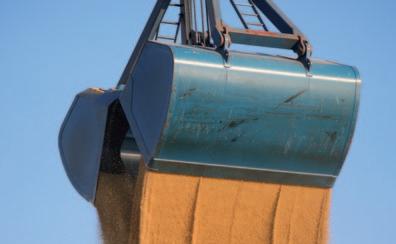
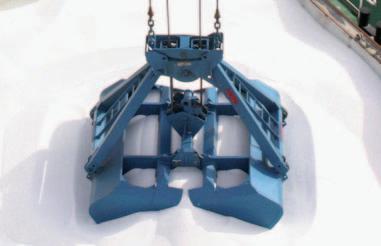

Are you looking for a new grab?
Please contact us. At Verstegen we are fully specialised in rope-operated mechanical grabs. Our goal is to provide the optimal grab for your specific operation. A new Verstegen grab leads to higher production rates and lower maintenance costs through extreme reliability and long lifetimes. Tell us how you want to improve your operation and together we will find the best solution.
Visit us at www.verstegen.net
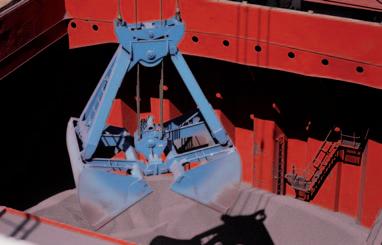
WWW.VERSTEGEN.NET
Verstegen Grijpers B.V. The Netherlands
affected by ideas about the outlook for the freight market and profitability, for the bulk carrier sector as a whole and for Handymaxes in particular. Although orders for Handymax bulk carriers picked up in the past two years, 2022 has seen a more limited response, apparently reflecting the setback in freight rates and renewed caution about how the future market trend may evolve.
Shipowners’ views of longer term market prospects have become more cautious, causing hesitation in ordering new ships. There is substantial uncertainty about the effects of tightening regulation of shipowning activities and, especially, surrounding the intensified focus on cutting ships’ greenhouse gas emissions. The technology needed for alternative fuels facilitating decarbonization, suitable for the entire lifetime of a typical new ship is unclear. Until more clarification is available, fleet growth may remain restrained.
Variations in the pace of scrapping (recycling) is another imponderable for fleet growth forecasts. How this influence evolves is always difficult to predict, both in the immediate future and further ahead. As well as the impact of secondhand vessel and scrap prices, owners’ views of current and expected freight market trends are among unpredictable aspects.
Potential for scrapping old tonnage is apparent, but the Handymax fleet’s relatively young age is a limitation. Only 10% (about 22m dwt) is 20 or more years old, an age group where recycling is more likely, mostly in the 40 50,000 dwt size subgroup. However, tightening regulations and compliance costs could encourage extra sales to demolition yards. Consequently higher scrapping is a possibility, after recent minimal volumes, resulting in a net deadweight capacity addition in 2023 of well below this year’s total.
TRADING PATTERNS DIVERSITY
Evidence of global trading patterns performed by Handymax bulk carriers confirms that a high proportion of dry bulk commodity movements is accessible, with relatively few limitations. The dimensions and cargo-handling capability of typical ships facilitates their employment carrying numerous commodities in most geographical areas.
But in practice large parts of global longhaul iron ore and coal movements do not normally employ Handymaxes. Bigger Panamax, Kamsarmax, Capesize, Newcastlemax and even larger bulk carriers can be accommodated on many of these routes. Higher-capacity units enable
greater economies of scale to be derived, providing cheaper transport.
As a very rough guide to the significance of various trades, calculations show that for Handymax 40 70,000dwt size bulker employment, the iron ore and coal trades each contribute up to one-tenth of total employment. Grain and soya trade contributes about one-fifth, while the remaining utilization category, contributing over half of the total, is the extensive and diverse minor bulk commodity trades.
COMMODITY MIXTURE
Global grain and soya trade is one of the most prominent segments providing many cargoes for Handymax bulk carriers. This market segment experiences a continuously changing pattern of trade routes and quantities, which is highly variable in both the short and longer term, and tends to be largely unpredictable. World trade in wheat and coarse grains, together with soyabeans and meal, saw strong overall expansion before flattening during the past crop year. In the current 2022/23 year restraining influences are still visible.
World trade in wheat plus corn and other coarse grains, during crop year 2021/22 ending June 2022, was 2mt (million tonnes) or under 1% lower compared with the previous twelve months, at 424mt based on International Grains Council calculations. Soyabeans and meal global trade was 11mt (5%) lower in marketing year 2021/22 ending September, at 219mt, according to US Department of Agriculture estimates. Decreased grain and soya imports into China was an especially visible change, explaining much of the downturn.
Flexible sea transport services provided by bulk carriers handle the frequently changing grain and soya cargo volumes

imported and exported by various countries, and varying geographical trade patterns. Large rises or falls from year to year, in volumes of grain or soya available in exporting countries, and quantities required in importing countries, often reflect harvest output fluctuations. These production changes are frequently caused by unpredictable weather variations. Coupled with port and storage limitations in many countries, this feature enhances employment opportunities for adaptable Handymax bulk carriers.
There are no signs at present of resumed growth in wheat and coarse grains trade in the current 2022/23 period. IGC estimates show a further large fall in China’s imports from the peak volume seen two years ago which, together with weakness among other countries, may result in global trade declining again, by 16mt (4%), to 408mt. By contrast in the soya category USDA estimates show strengthening imports into China, which comprise two-fifths of the world total. These were much lower at 90mt in the past twelve months. A prospective rise could contribute to a 13mt (6%) global soya trade increase to 231mt in 2022/23.
Carrying cargoes within the ‘minor dry bulk trade’ category is an extensive part of Handymax bulk carrier employment. Some individual elements of this group are not actually minor but large, amounting to massive annual volumes. The commodity range is broad and in recent years the overall total has been estimated at over 2000mt annually. Last year there was a revival when some elements previously affected by a pandemic-related weakening rebounded.
The two biggest trade components among minor bulk commodities are steel products (coil, sheet, plate and other
SHIPPING & TRANSPORT 20 NOVEMBER 2022 DCi www.drycargomag.com
Capesize vessel Nord Energy.
items), and forest products, although not all quantities are carried by bulk carriers. Other big volumes are contributed by bauxite/alumina (aluminium raw materials), fertilizer raw materials and semi-finished fertilizers, agricultural commodities, and cement trades. These are accompanied by large quantities of ores such as nickel and manganese, and scrap.
This category is widely diversified mainly among commodities related to manufacturing and construction activity, together with a significant agricultural component. Some estimates suggest that in 2021 there was an overall increase of around 5%, more than reversing the previous year’s reduction. Results in individual commodities varied last year although most appear to have seen growth, especially in industrial bulks where economic recovery around the world boosted demand for the products of many industries. But tentative indications point to a weaker 2022 outcome amid setbacks for economic activity in many countries.
Within the coal segment, numerous routes chiefly employ Panamax and Capesize ships but Handymax cargoes amount to big volumes, especially on specific trade routes. Global seaborne coal trade is the second largest commodity trade employing bulk carriers (after iron ore), and amounted to 1233mt in 2021, according to Clarksons Research data. Coal still exceeds one-fifth of all global dry bulk cargo movements, despite environmental restraints on consumption.

Coal trade grew by 5% last year, partly reversing the previous year’s abrupt decline. The principal positive influence during 2021 was the upturn in global energy consumption resulting from economic activity recovering after the coronavirus pandemic. Seaborne
movements comprise steam coal (used chiefly in power stations, also in other industries), and coking coal (used in the steel industry). Steam coal comprises almost four-fifths.
In 2022 seaborne coal trade is being supported by energy shortages exacerbated by the consequences of the conflict in Ukraine, reducing gas supplies from Russia. While the emphasis on a global shift towards cleaner energy sources persists, downwards pressure on fossil fuels including coal has temporarily diminished. Some forecasts suggest that world coal trade may be flat or marginally higher in 2022 as a result, and there are expectations of resumed growth unfolding next year.
FREIGHT MARKET EVOLUTION
Since early 2022 charter earnings of Handymax bulk carriers in the freight market have been on a downwards trend after reaching peaks in September/ October 2021 and again in March this year. The deadweight tonnage capacity of the world fleet of these ships has continued growing at a similar rate to that seen previously. But some of the trades in which there is much employment have
experienced weakening volumes, while an easing of port congestion and delays has apparently improved vessel availability, augmenting a loosening of the demand/supply balance.
A useful indicator of Handymax freight market changes is the Baltic Supramax Index calculated by the Baltic Exchange. This index began 2022 at above 2,000 points, after plummeting in the final quarter of last year from more than 3,500 reached following a steep upwards trend. In the first quarter of this year a partial recovery to around the 3,000 level ensued but the index subsequently was on a declining trend approaching the 1,500 points level at the end of October.
What are the prospects for Handymax freight rates in the period ahead? Forecasts for dry bulk trade generally and the commodity trades most relevant to handymax bulk carrier employment have become more cautious. Considerable headwinds are facing global economic activity with implications for import demand in many commodities during 2023, which may restrain or prevent trade growth, or even result in contraction. However, a potential upturn in China’s economy if covid restrictions are reduced could provide a boost.
On the supply side of the market there are clear signs pointing to additional support for freight rates over the next twelve months. A seemingly realistic expectation of higher scrapping could restrict expansion of Handymax fleet carrying capacity. Moreover, tightening international regulations designed to reduce ships’ carbon emissions are now being introduced.
In addition to encouraging the scrapping of older ships unable to comply with regulation changes, another result envisaged is slower steaming speeds to cut emissions. If such a change becomes widespread, it could further restrict transport capacity available, underpinning freight rates.

SHIPPING & TRANSPORT 21 NOVEMBER 2022 DCi www.drycargomag.com
Newcastlemax Lavinia Oldendorff.
Handymax Kang Man.
Make friends with your digital twin
With equipment installed on the equivalent of every other ship at sea, MacGregor’s marine and offshore ambitions to exploit digital twin technology at scale are as achievable as they are understandable.
Like many of the digital terms entering the marine and offshore lexicon, gains associated with the ‘digital twin’ have quickly become slippery due to multiple interpretations. But a technology with deep consequences for design, operations and maintenance cannot be allowed to slide into the shallows of the maritime buzzword, say Dennis Mol, Vice President Technology & Sustainability, and Bhavik Thakker, Director Digital Solutions, MacGregor.
This is one reason MacGregor recently formalized the Digital Twin part of its digital services offering. Another is that the group has already proved a front-runner in securing safety, productivity and sustainability gains by developing real-time digital processes to support the marine cargo and offshore load handling equipment it delivers.
“Rather than talking up potentials, we have evolved a set of cases to demonstrate the purpose of using a digital twin in different scenarios, and the benefits of calculating, simulating and analysing what is feasible for equipment based on data from the operating environment,” says Thakker.
MacGregor’s conclusion is that digital twin technology has value for marine and offshore customers at every stage of its product and service offering: from the
product concept stage, to design and engineering verification, testing and sea trials, training, operations and maintenance.
ALTERNATIVE REALITIES
“Data that is ‘engineering-level’ accurate allows a digital twin to simulate the real time dynamics of an actual vessel in its environment,” explains Mol. “This creates analytical power that goes beyond theoretical modelling. A designer can evaluate the impact of an integrated equipment configuration at the predevelopment stage, for example, and work to refine control systems in advance to benefit the whole.”
Allowing the user to try-out a new design is empowering for the customer and invaluable for the engineer — both as a way of exploring and predicting behaviour, and as a tool to get things right the first time and avoid cost overruns. For MacGregor, the benefits of using the digital twin are available from a product’s conception to the end of its operational life, Mol stresses.
“Working with accurate specifications and real data, we can use the digital twin for FEED studies and rapid prototyping in the idea development phase, and present the customer with interactive ‘almost-real’ experiences,” adds Thakker. “Later in the process, the technique allows us to optimize the general arrangement, choose the right equipment combinations, develop realistic structural analysis, verify the design, and simulate and analyse
work processes.”
BEHIND EVERY GOOD TWIN — A BETTER TWIN
“MacGregor has already used a digital twin in key product developments,” says Mol. “Its in-house developed ‘C-how’ simulation technology has been deployed to de-risk the engineering phase, verify the design in different on-deck scenarios and optimize operability.”
In one case, a shipyard used a digital twin to simulate control responsiveness of a MacGregor davit system during boat launch and recovery, in order to verify the maximum wave height limit. In another example, using the technique in the product test phase enabled dynamic vessel motion modelling so that an owner could verify that a gangway designed for the bow of a vessel would operate safely at greater wave heights.
For operational purposes, one MacGregor customer used a digital twin to maximize the weather window within which subsea equipment could operate, while another developed new subsea crane operating guidelines after an incident involving a mis-timed change in mode.

DATA DRIVEN LESSONS
Thakker explains that, once the equipment is built, a digital twin also proves invaluable for verifying safety, optimizing control procedures and automation sequences, and for detecting failure root causes.
“The data analytics capabilities can be
SHIPPING & TRANSPORT 22 NOVEMBER 2022 DCi www.drycargomag.com
used for predictive maintenance planning and to anticipate failure and repair needs for critical equipment well in advance,” he says.
But the usefulness of the digital twin for worldwide maritime industries is not limited to machinery. “The experience of using the digital twin also takes training using simulation to a new level,” adds Thakker. “In fact, the best point of delivery for the data-driven lessons that enhance equipment efficiency is to the people using it. Training needs to be delivered in the most effective way, and e-learning, scenariobased simulations, analytics and immersive augmented reality-based methods create a powerful mix to get the message across on standards to office-based and shipboard personnel alike.”
A digital twin-level of simulation accuracy makes high-fidelity training more affordable, based on MacGregor’s heritage and continuing role as a global supplier of handling equipment.
In a fast-changing scenario, MacGregor is already trialling the use of the digital twin technique for an augmented reality-based pilot covering air compressor maintenance sequencing, says Thakker, but his preference is to focus on gains already won.
“Getting that real-time feel and having the ability to simulate how equipment actually responds in an emergency situation results in a much steeper learning curve for the user,” he says. “If an incident has occurred in the past, we can just play it back using a rich visual format, see how the guys respond and then train them on what they could have done better or patterns to look out for.”
MacGregor is on the verge of delivering a new portable simulation-based offshore active heave compensation crane training

package which uses digital twin capability to an offshore support vessel operator, he discloses, based on a rental and software licensing agreement.
“Our experiences with digital twin technology have allowed us to mature and formalize our approach across the entire scope of our activities — from design and engineering to testing, verification, training, operational support and maintenance,” adds Thakker. “And the more we learn, the clearer the benefits for our customers become.”
All-electric Liebherr LS 800 E ship cranes for SAL ‘Orca’ project

Liebherr secures order for eight all- v electric heavy lift ship cranes type LS 800 E from SAL Heavy Lift
The completely new developed cranes v have a maximum lifting capacity of up to 800 tonnes and a radius of up to 39 metres
Continuation of a trusting partnership v between the two companies Harren Group and Liebherr that has lasted for decades
SAL Heavy Lift has ordered eight allelectric heavy lift ship cranes type LS 800 E. As part of the future-oriented ‘Orca’ project, two cranes will be installed on each of SAL’s four vessel newbuildings.
By combining the capacity of both cranes in tandem mode, cargoes of up to 1,600 tonnes can be handled. The innovative ship cranes will make it possible to lift components of the future project cargo while being prepared for the increasing environmental protection requirements.
The LS 800 E is the latest innovation of Liebherr’s heavy lift ship crane portfolio. The recently launched crane is designed for the ever heavier and larger cargo. Moreover, the all-electric drive concept supports vessel operators in saving CO2
emissions. The order of the first LS 800 E ship cranes marks the beginning of a new phase in the long-term partnership between the Harren Group and Liebherr. At the same time, it is SAL Heavy Lift’s first newbuilding project with Liebherr. The two family-run companies have been cooperating since the start of this new project for four multipurpose heavy lift vessels. The crane manufacturer was actively involved in the development from day 1. Since the ‘Orca’ class of ship breaks new ground in many respects and will significantly raise the bar in the relevant transport segment, the crane developers
were also challenged to rethink many details in addition to general requirements, and performance parameters and to make their contribution to the efficiency and innovation of the ship concept. The result is a perfectly co ordinated unit of crane and vessel that enables maximum efficiency and performance.
ALL ELECTRIC ENERGY EFFICIENCY
Apart from fulfilling the demanding operational requirements and different cargo scenarios, the new Liebherr ship cranes enable significant savings in smart interaction with the innovations on the ship
The LS 800 E has a lifting capacity of up to 800 tonnes and a total radius of 39 metres.
SHIPPING & TRANSPORT 23 NOVEMBER 2022 DCi
www.drycargomag.com
side. The new LS 800 E actively communicates with the ship’s power management system and thus enables intelligent energy utilization. Recovered energy is fed back into the ship’s energy system and stored so that it can be released when energy consumption is high again. This leads to a noticeably reduced fuel consumption and a considerable reduction of CO2 emissions on the ‘Orca” ships.
The entire power electronics of the drive system are installed inside the cranes. This allows the limited space below deck to be used for other purposes and noticeable facilitates the integration of the crane into the ship’s design.
COMPACT DESIGN FOR HIGH DURABILITY
The integration of the entire drive concept inside the crane also significantly increases the durability of the components, as they are protected from the weather. “The reliability of the cranes is extremely important for heavy lift vessels. They must function for the entire life of the vessel.
The family-run company Liebherr offers a convincing overall package for this, thanks to its wide-ranging product and technology knowledge as well as its worldwide service network.” explains Dr Martin Harren, CEO of the Harren Group.
READY FOR FUTURE REQUIREMENTS
The LS 800 E ship cranes expand Liebherr’s product portfolio and enter a new segment. They are the largest ship cranes Liebherr has built to date. The cranes are aimed for a growing market of shipping large wind industry components. In the future, these will not be manageable with the lifting capacities and dimensions that have been common in the market so far.
Moreover, the supply of heavy lift vessels with cranes of 800 tonnes capacity is lower
than the expected future demand. Liebherr has claimed the resulting growth market for itself with the development of the LS 800 E ship crane.
The all-electric drives are already preparing the cranes for future environmental protection requirements in terms of energy efficiency an emissions regulation. “The development of the new cranes combines SAL’s user experience and Liebherr’s crane construction expertise.
The LS 800 E will be the most advanced ship crane in its segment.” comments Gregor Levold, General Manager Sales for Liebherr Offshore, Ship and Port Cranes.
“The all-electric heavy lift cranes feature a variety of innovations that simplify maintenance and reduce operating costs.
At the same time, they are characterized by innovative as well as environmentally friendly drive technology,” adds Levold.
COOPERATION WITH HISTORY
The co-operation between Liebherr and the Bremer Harren Group began back in the late 1990s with the delivery of the first 40-tonne ship cranes for container vessels. This was followed by a large order for 24 Liebherr heavy lift cranes for use on multipurpose vessels in 2006 and 2007.

Since then, a trusting partnership has developed between the two companies on an equal footing, which was further expanded in the transport sector with Harren’s acquisition of SAL Heavy Lift.
Dr Martin Harren comments as follows: “The co operation between SAL and Liebherr is characterized by great commitment and mutual trust.” Jan Breckling, Senior Sales Manager at Liebherr Maritime Cranes, adds: “SAL is a reliable and competent partner with whom we work intensively in all areas and maintain close contact between the people involved. By ordering the LS 800 E ship cranes, we
The four multipurpose heavy lift vessels of the ‘Orca’ project will each be completed with two all-electric Liebherr LS 800 E ship cranes.
“
ABOUT SAL HEAVY LIFT
SAL Heavy Lift, a member of the Harren Group and part of the Jumbo SAL Alliance, is one of the world’s leading heavy lift shipping companies headquartered in Hamburg. Specializing in the shipment of project and heavy lift cargo, SAL offers tailor-made transport solutions worldwide. Jumbo-SAL-Alliance owns and operates a versatile fleet of 30 modern project cargo vessels with a lifting capacity of up to 3,000t SWL.
ABOUT LIEBHERR-MCCTEC ROSTOCK GMBH
Liebherr-MCCtec Rostock GmbH is one of the leading European manufacturers of maritime handling solutions. The product range includes ship, mobile harbour and offshore cranes. Reach stackers and components for container cranes are also included in the product portfolio.
ABOUT THE LIEBHERR GROUP
The Liebherr Group is a family-run technology company with a highly diversified product portfolio. The company is one of the largest construction machinery manufacturers in the world. It also offers high-quality and user-oriented products and services in a wide range of other areas. The Liebherr Group includes more than 140 companies on all continents. In 2021, it employed more than 49,000 people and achieved a total turnover of over €11.6 billion. Liebherr was founded in 1949 in Kirchdorf an der Iller in southern Germany. Since then, its employees have pursued the goal of continuous technological innovation and providing customers with industry-leading solutions.
SHIPPING & TRANSPORT 24 NOVEMBER 2022 DCi www.drycargomag.com
can jointly shape the future of heavy lift and project shipping.
DCi
Celtic Freeport consortium announce chair to spearhead bid
In the UK, successful technology investor with wide experience in the metals and mining sector Roger Maggs MBE, has been chosen by the bid partners as the chair of the Celtic Freeport consortium. The consortium is putting together a transformational bid for a freeport covering the ports of Milford Haven and Port Talbot to create a green investment corridor that spans clean energy developments and innovation assets, fuel terminals, a power station, heavy engineering and the steel industry across south-west Wales.
Maggs will work with the consortium partners — Associated British Ports (ABP), Neath Port Talbot Council, Pembrokeshire County Council and the Port of Milford Haven — to help present the case for the Celtic Freeport to the UK and Welsh governments. The bid will be submitted on
24 November 2022, with the successful bid announced in early spring 2023.
“I am delighted to join such a strong bid team. The Celtic Freeport offers the potential to generate significant economic impact and will provide a large-scale boost to Wales’ critical pathway to a greener and more sustainable future,” commented Maggs, chair of the Celtic Freeport bid consortium.
He added: “The Celtic Freeport will catapult Wales’ path to a cleaner future across target sectors including floating offshore wind and the hydrogen economy to sustainable fuels, cleaner steel and low carbon logistics.
“A good example is floating offshore wind. With a freeport, we can secure firstmover advantage for Wales, which will create a green industry with a substantial number of new manufacturing jobs. The
TMC begins operations
In the Spanish Mediterranean city of Cartagena, the new Terminal Marítima de Cartagena has commenced operations. Its first vessel was conveying a consignment of cereals from Ukraine. The vessel was carrying a cargo consisting of 20,095 tonnes of wheat, 34,071 tonnes of barley and 8,640 tonnes of sunflower meal.
TMC has a 24,000m² warehouse dedicated to bulk cargo storage, which is located at Escombreras dock.
For its first operation, two mobile harbour cranes were deployed over a seven-day period, each with a 30-tonne capacity. The unloaded grain was put into HGVs for transport to the warehouse.
A second consignment of 97,000
development proposed at the ports of Pembroke Dock and Port Talbot will embed this industry locally to create a renewable energy legacy, which has genuine global export potential.”
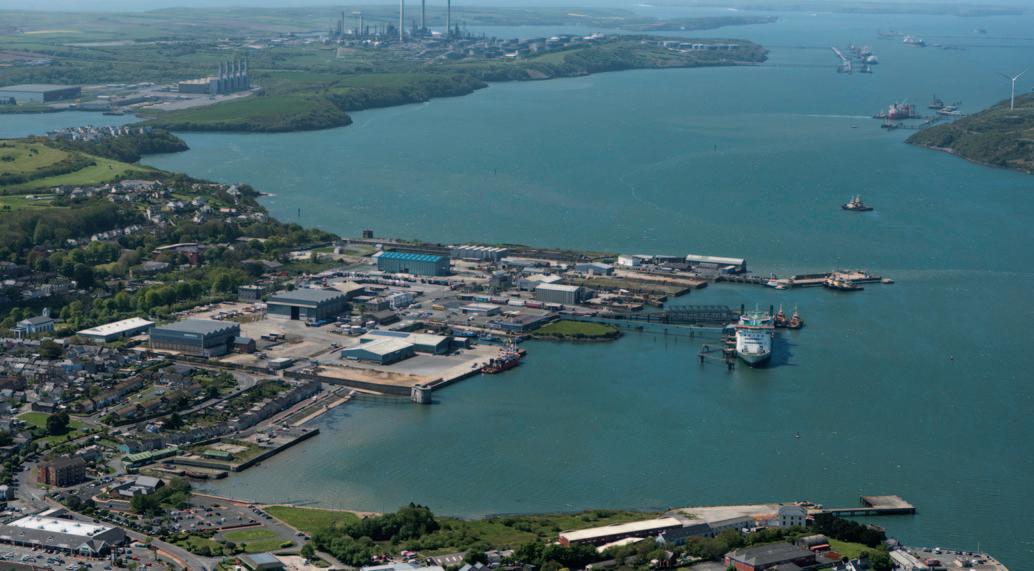
ABOUT ROGER MAGGS
Roger Maggs MBE has had a 27-year career at Alcan Aluminium, with a number of global senior postings, including three vice presidencies at Alcan’s world headquarters in Montreal Quebec. In 1994, he co founded Celtic House, a Canadian venture capital fund. Most recently, Maggs has been chair of the Port Talbot Waterfront Enterprise Zone and chair of the Canadian public technology company Sandvine. He is currently co-chair of the International Convention Centre Wales. Maggs was born in Newport and grew up in Carmarthenshire.
tonnes of cereals also took place in October. Grain consignments have been at a premium in 2020 because of the war in Ukraine. However, now that Ukrainian grain reserves are leaving that country’s ports, traffic is recovering. Nevertheless, these are not expected to reach the same levels as in previous years.
Barry Cross
25 PORTS & TERMINALS NOVEMBER 2022 DCi NEWS www.drycargomag.com
National Ports unveils the Mobidock™ a revolutionary 60,000m² scalable floating port to rapidly expand global port capacity
National Ports Corporation Limited, based in Perth, Australia, has unveiled the Mobidock™ a 60,000m² (15 acres) scalable floating port with a 520,000dwt. The revolutionary design is set to address the capacity crises and unlock revenues at busy ports worldwide.
PORT CONGESTION IS A GLOBAL CRISIS
Port congestion has become a major challenge in high-growth regions globally. This has been exacerbated by the pandemic and geo-political pressures around the world
Every major port globally is struggling to meet demand and remain commercially competitive. Excessive wait times for ship berthing and associated high demurrage costs are now the norm. And the effects of port congestion reverberate far beyond shipping providers; project44 estimates that retailers incurred approximately $321 million in added interest expense on inventory in 2021 due to port congestion.
Port capacity is essential for boosting international trade and boosting the revenue profile of nations; however, significant time and capital are required to build new port capacity. Moreover, open land next to deep water is no longer plentiful.
Building deep-water berths is expensive and time-consuming, and dredging and environmental permitting are becoming
SPECIFICATIONS OF THE 60,000M2 MOBIDOCK™
Length: 300m
Beam: 200m
DWT: 520,000 tonnes
Draught: 19 metres (on 520,000dwt)
Deck area: 60,000m² (15 Acres)
Under deck area: 700,000m³
Berth frontage: 600m
more complicated, expensive and restrictive.
INTRODUCING THE 60,000M² MOBIDOCK™ A COST-EFFECTIVE , AND ENVIRONMENTALLY CONSCIOUS APPROACH, NO DREDGING REQUIRED
Around the world, floating ports are now considered the most economical way to expand port capacity. National Ports’ patented scalable ports offer an unrivalled opportunity to quickly and economically expand port capacity on a never-beforeseen scale.
The Mobidocks™ provide an uninter rupted laydown deck area of 60,000m² or more, plus over 700,000m³ of under-deck area. They have a deck strength of 15 tonnes per square metre (or as required by the client), over 600 metres of berthing space for easily berthing by any type of vessel and a deadweight (DWT) of 500,000 tonnes. The patented design is also incredibly safe
and stable. This flexible Mobidock² solution offers on-board accommodation, dynamic positioning (optional), can be scaled to clients’ requirements and is available for lease or purchase.
The Mobidock™ is ideally suited for: extension of existing ports; v countries or islands with limited or v nonexistent ports infrastructures; supply base for the oil and gas v industries; storage and/or installation of wind v turbine components.
The Mobidock™ provides a safe and stable cost-effective alternative for all types of cargo:
containerized; breakbulk; v bulk commodities; and v project cargo. v
The Mobidock™ floating terminals’ strategically located offer services including:
600m of deep-water berth frontage; v 60,000m² (15 acres) laydown and v storage; 700,000m³ under-deck storage area; Customs & quarantine; v 90,000m³ fuel storage; v bunkering facilities; v potable water generation; v ship repair & maintenance; v container cranes; v cold storage and warehousing; v stevedoring services; and cargo v management.

PORTS & TERMINALS 26 NOVEMBER 2022 DCi NEWS www.drycargomag.com
The Mobidock is an innovative breakthrough in engineering, providing a solution to the challenges facing today’s global ports.
The Port of Barcelona and PowerCon start building the pilot project to provide electrical power to ships at the BEST terminal

The Port of Barcelona and Denmark’s PowerCon A/S have started building the pilot project to provide electrical power to ships at the BEST terminal. The company has been awarded the contract for this project, which is part of Phase Zero of the Wharf Electrification Plan developed by the Port of Barcelona and includes the drafting and performance of the project as well as the ships’ connection and disconnection service and the maintenance of the installation. The contract has been awarded for €4,978,640.
The first meeting was held between the Port of Barcelona team that heads the pilot project (Ana Arévalo, Energy Transition Manager; Gemma Peñalver, Site Manager, and José Manuel Hernández, electrical engineer) and the team from PowerCon A/S, led by Peter Castberg Knudsen, Team Manager and founding partner of PowerCon; Soren Munch, Site Manager, and Javier San Miguel, coordinator.

During the meeting, the Port of Barcelona and PowerCon teams established the ground rules for the performance of the construction project in accordance with the tender and visited the Hutchison Ports BEST terminal to inspect the facilities where the electrification equipment will be located. Ana Arévalo stated “we hope to have the construction project approved in six months, at most, so that we can start the building work”.
NEXIGEN
With a planned overall investment of nearly €110 million, the Wharf Electrification Plan is among the key projects promoted by the Port of Barcelona to halve CO2 emissions from port operations by 2030 and become a carbon neutral port by 2050. This plan,
known as Nexigen, will make it possible to connect ships to the general electricity grid while they are berthed, using clean energy that is generated at the port itself or that is certified 100% renewable.
Awarding the pilot project at the BEST terminal marks a decisive step towards realising the first OPS (onshore power supply) supply points, which will work at the port’s commercial docks. It should be remembered that the port’s first OPS points are already working at the MB92 Barcelona facilities.
Once the BEST pilot project is underway, the Port of Barcelona will have real and useful experience-based information about the performance of OPS on container ships and will be able to draw conclusions regarding best practices and identify future needs and developments.
The Port of Barcelona Dock Electrification Plan is fully aligned with the United Nations Sustainable Development
Goals (SDGs) and one of the keys to its success lies in connecting the Port directly to the high-capacity electricity grid to respond to expected demand for electricity from ships.
THE SUCCESSFUL TENDERER
PowerCon is a Danish engineering and manufacturing company specialising in electrical energy conversion solutions for various applications. With its roots in the Danish wind power sector, PowerCon is not only involved in the wind turbine industry but also operates in the maritime sector, where the company ranks among the leaders in power supply equipment.
PowerCon offers high- and low-voltage power supply solutions from land to all types of vessels, ranging from cruise ships to container ships, ferries and fishing vessels. All of its flexible and innovative systems are built according to international standards.
27 PORTS & TERMINALS NOVEMBER 2022 DCi NEWS www.drycargomag.com

Bulk in Belgium Bulk in Belgium
Belgian Regional Report
Port of Antwerp-Bruges: slight growth despite ongoing challenges

After nine months, the total throughput of Port of Antwerp-Bruges was 217.4mt (million tonnes), a slight increase of 0.8% compared to the same period last year. Despite the negative impact of the geopolitical and macroeconomic context, all cargo flows are recording growth, with the exception of the container segment, which remains under pressure. Together with a series of announcements of new investments in the port platforms of Antwerp and Zeebrugge, this confirms the attractiveness and resilience of the unified port.
After nine months, container throughput is down 8.8% in tonnes and 5% in TEUs compared to the same period last year.
Conventional breakbulk grew by 9.7%. While steel outflows are holding up well, steel supply volumes are showing a downward trend as a result of high inventories and falling demand. Despite a declining trend in the throughput of wood and building materials, these product groups, like fruit, are still recording growth.
Roll-on/roll- off traffic saw an increase of 8.1%.
Growth in the dry bulk segment (+21.5%) is primarily fuelled by growth in the transport of coal. The increased demand for coal for power generation translated into throughput of 2.43mt compared to 364,000 tonnes in the same period last year. Throughput of iron ore is
showing growth, while scrap metal, sand and gravel show a decline and other building materials remain status quo Although both fertilizer inflows and outflows have picked up compared to the second quarter, there is still a decline from the 2021 record year ( 11.8%).

The liquid bulk segment recorded an increase of 13.3%.
After nine months, Zeebrugge has welcomed 102 cruise ships with 325,406 passenger movements, up from last year when cruise shipping was largely at a standstill due to Covid-19.
UNIFIED PORT ATTRACTS INVESTMENT
Since the official launch of merged port
Port of Antwerp-Bruges six months ago, several investors and new projects have already found their way to both the Antwerp and Zeebrugge port platforms. Conti Seafrigo Antwerp, for example, will construct a new frozen food warehouse, Antwerp Euroterminal (AET) will commission Belgium’s largest unit parking lot and Fluxys will build an ammonia terminal in partnership with Advario. Meanwhile, Covestro has begun construction of an aniline plant, ITC Rubis is expanding with an additional tank pit and Lanxess is installing a new climate protection system. Ineos has also chosen to set up a pilot for Carbon Capture and Storage (CCS) from Antwerp. In
REGIONAL REPORT 29 NOVEMBER 2022 DCi www.drycargomag.com
Jay Venter
Zeebrugge, Ziegler Group is opening a branch for unaccompanied ro-ro freight to Ireland and the United Kingdom, and real estate group Intervest this week officially opened the logistics complex acquired in April from Chinese developer Lingang.
Jacques Vandermeiren, CEO Port of Antwerp-Bruges commented “Despite the ongoing challenges due to the current geopolitical and macroeconomic context, we stand as a unified port. The negative trend in the container segment, rectified by growth in the other segments, is likely to continue towards the end of the year. But the flood of substantial, forward-looking and sustainable investments and new projects, especially in a climate of closures and production cuts due to high energy prices, is a confirmation of our strong position and attractiveness as a world port.”
Annick De Ridder, Port Alderwoman of the City of Antwerp and Chairwoman of the Board of Directors of Port of AntwerpBruges, added, “In these particularly challenging times, our unified port is demonstrating its resilience. This is proven by the slight increase of 0.8% compared to the same period last year. In addition, some major investments were announced this month.
“The modernization of the Europa Terminal (investment by Port of AntwerpBruges of €335 million and €500 million by PSA Antwerp), the inauguration of the Lanxess climate protection installation (€13 million) and the start of construction work on Covestro’s aniline production unit (€300 million) are the most notable examples. There will also be a net addition of 750 port workers this year and next. Together with the innovative companies
that believe in a sustainable future and are anchoring their presence through investment, the port is and can continue to function as the engine of the Flemish economy.”

Dirk De fauw, Mayor of the City of Bruges and Vice-Chairman of Port of Antwerp-Bruges said, “The fact that we can achieve this result in the current context makes me hopeful for the future, even though we will certainly need to be resilient. The growth in LNG throughput confirms the important position of Port of Antwerp-Bruges in that segment. In addition, we recently received two new Far East services and were included as the first port of discharge in Europe on MSC’s ‘NWC USA SAWC Service’. Together with the new investments, this will continue to strengthen our international position.”

REGIONAL REPORT 30 NOVEMBER 2022 DCi www.drycargomag.com
North Sea Port sees cargo traffic go up by over 9% in first nine months
During the first nine months of this year, the North Sea Port companies recorded transhipment of goods by sea of nearly 57mt (million tonnes). This is a 9.3% increase. Transshipment of dry bulk, general cargo, ro-ro and liquid bulk all improved significantly.
In 2020, during the first nine months — in the middle of the coronavirus crisis — North Sea Port was faced with a 13% drop in cargo traffic by sea compared to the previous year. A 9% growth was recorded for the first nine months of 2021. Again, a 9.3% increase can be recorded for the same period, mainly in the second quarter.
DRY BULK , GENERAL CARGO, RO RO AND LIQUID BULK ON THE UP
Transshipment by sea increased by 4.8mt (+9.3%) during the first nine months of this year to 56.9mt compared to the same period in 2021.
Dry bulk experienced a 13% growth (3.6mt) and reached 31.4mt. Here, solid fuels account for almost half of this increase (+1.6mt). Transshipment of oilseeds, iron and ores also increased.
General cargo recovered strongly with an 11% growth (+0.8mt) and clocks in at
7.7mt. More than half of this increase was achieved by trade in steel plates.
Ro-ro continued to grow by +8.4% (0.2mt), clocking in at 2.8mt.
Total liquid bulk transshipment recorded 13.3mt, an increase of 3.1% (0.4mt).
Container transhipment declined 8.9% in the first three quarters of 2022, reaching 1.7mt compared to the same period in 2021. This mainly concerns a decrease in the transshipment of fruit and vegetables not transported by container but as break bulk.
INLAND NAVIGATION TRANSHIPMENT ALSO ON THE UP
For the first nine months of this year, transhipment via inland navigation also recorded an increase, plus 8.4% (3.7mt) to 48mt. This increase was, to a large extent, due to an increase in cargo traffic during the second quarter.
IMPACT RUSSIA-UKRAINE
During the five months, March to July this year, immediately following the start of the war in Ukraine, many companies stockpiled large amounts of goods. This was because
of limited exports from Ukraine and EU embargoes on goods from Russia such as coal and wood.
Daan Schalck, CEO North Sea Port: “Uncertainties on the geopolitical stage therefore cause (temporary) spikes in supply streams in certain segments. The drop in trade with Russia will be compensated by additional transhipment from mainly the United States, Canada and Finland. Russia may then cease to be the first trading partner by the end of this year.”
Ukraine also logically drops further down the list of trading partners despite the supply of grain since early September through the grain corridors set up by the United Nations. A total of 0.4mt were traded, well below the 1mt in the same period in 2021. The declines are in maize, animal feed and iron ore.
OUTLOOK
Growth in cargo traffic by sea and inland waterway occurred strongly during the second quarter of this year. During the third quarter, growth slowed down. It is expected to continue like this in the months to come.
Zoutman to build the world’s most advanced salt tower at North Sea Port
Zoutman is to erect the world’s tallest and most modern production tower for sea salt at its Ghent Kluizendok site in North Sea Port. The €30 million investment features high sustainability as well as creating 40 new jobs and enhancing the port’s position as a food port.
The new 64.5 metre tower will provide an additional capacity of 150,000 tonnes per year. High-tech production may start as early as the middle of next year. The site will include five unique optical cleaners to remove impurities from the salt. To Zoutman this investment is an important landmark. The family-owned company specializing in sea salt aims to double its sales by 2030.
GROWING DEMAND FOR SUSTAINABLE SALT

The process in the new tower will focus on producing salt without additives in order to combat salt clumping and hardening. “We find that food companies want to switch to table salt without artificial additives as soon as possible. Because of substantial investments in research, we are the only sea salt producer in the world that can offer a quality product for this growing
demand,” underlines co-CEO Bert Lamote. On top of that, natural and sustainably sourced sea salt is by far the most environmentally friendly type of salt. When extracting salt from the sea, CO2 emissions are up to 31 times lower than salt extracted from mines, the company said.
The new production tower will rank highly in terms of sustainability. Its high-rise reduces space requirements, doubles production efficiency per square meter and allows the use of gravity to reduce energy consumption. The plant that is selfsufficient in energy and heat will purify and reuse its process water.
FOOD PORT WITH THE LARGEST COVERED SALT TERMINAL IN EUROPE
The new installation is no chance occurrence for North Sea Port. The West Flanders salt producer has had a storage, production and distribution hub at the Kluizendok in Ghent for years. This has developed into the largest covered salt terminal in Europe and the main hub in Zoutman’s logistics. The storage capacity is 300,000 tonnes of sea salt. Each year, the group ships 450,000 tonnes of salt to more
than 60 countries.
This new Zoutman investment will enhance one of North Sea Port’s strategic pillars, CEO Daan Schalck pointed out. “The expansion of the Zoutman Ghent facility fits into our efforts to develop North Sea Port as a food port. The 40 additional jobs as well as the increasing cargo throughput of 150,000 tonnes of sea salt per year will further establish this development. It is good to see that this company of international standing has an eye for sustainability in the extraction of sea salt, the economical use of space with the very innovative building and its operation. A perfect example of how growth and sustainability can go together.”
REGIONAL REPORT 31 NOVEMBER 2022 DCi www.drycargomag.com
DCi



A new crane at BARRA SNM in Dunkerque-Port
The BARRA SNM company has installed a new Liebherr 420 mobile crane at its terminals in the port of Dunkerque in Dock 6.

This new multi-purpose crane with a maximum hoisting capacity of 125 tonnes completes the current fleet. It allows the company to meet the needs of its customers to consolidate existing traffic and develop new activities in breakbulk, heavy loads and small agricultural and industrial bulk.
In addition to the operational advantage that this new tool will bring, it will also improve the environmental footprint of port operations with reduced energy
consumption, the possibility of operating with bio-fuels and, in the long term, of switching to all-electric systems.
The BARRA SNM teams are happy to be able to continue to offer their customers the best possible services backed by their recognized human operational skills and by latest-generation tools.
ABOUT DUNKERQUE-PORT
Major French port complex (Calais Dunkerque); ninth-largest port on the Channel and North Sea Ranges, thirdlargest port in France, the port of Dunkerque stands out in many segments.
In the Region of France
Traffic,
equipment, upgrades and environmental commitments
It is the leading passenger port in Europe (Calais Dunkerque corridor); the largest energy hub in France; largest LNG terminal; top French port for containerized imports of fruit and vegetables; top French port for mineral and coal imports; largest rail port in France; largest regional river port; third-largest port in France for grain traffic.
Dunkerque-Port is also a sustainable port. It is the trading port of the new Hauts-de-France Region, the largest agricultural region of France, the leading region for the rail industry, and the leading region for the car industry. In 2021, traffic totalled 48.6 million tonnes.
REGIONAL REPORT 33 NOVEMBER 2022 DCi www.drycargomag.com
Jay Venter
Atlantic Port La Rochelle, Groupe Sica Atlantique: committed to sustainable soy
Solteam (importer), EVA (stockman) and Atlantic Port La Rochelle (located on the coastline of the west French Atlantic coast), have signed a tripartite agreement validating their collective commitment: now only sustainable soybeans, from nondeforested and non-converted areas, are being transited to La Rochelle.
During the recent stopover of the Ultra Leopard chartered by Solteam, at the EVA terminal of Anse Saint-Marc in La Rochelle, EVA unloaded 30,000 tonnes of sustainable soybeans from Brazil.
While on 13 September 2022, MEPs adopted a text prohibiting on European territory a number of products* whose importers could not prove that they come from unforested or unconverted land, Solteam says it has not waited for European regulations to embark on a virtuous approach. Guillaume Bettinger explains “We work in partnership with the non-governmental organization Earthworm Foundation, which describes
our goods as coming from non-deforested and unconverted areas. Our suppliers in Brazil carry out geolocation and satellite monitoring of the plots as well as the verification of the origins of the seeds. This is our guarantee of transparency, our commitment to non-deforestation and the preservation of sensitive biotopes such as those of the Cerrado or the Amazon.”
Sustainable soybeans will become the norm of the market, excellent news in terms of social responsibility in the face of climate issues.
EVA and the Grand Port Maritime wanted to support Solteam in this approach by placing social responsibility at the same level as health responsibility, which itself led to the construction of the new Saint Marin building in 2019.
The Groupe Sica ATLANTIQUE was born at the end of the 50s from the strong will of a few pioneers in the grain export sector. Around 80 grain operators decided to gather their strengths to build the first
port silo dedicated to export. port silo dedicated to export.
“Since then we always have nurtured our commitment to the regional agricultural sector; our shareholders and board members are all local grain market actors.” says Louis Tercinier, Président of the Board. “Our vocation is to design and implement innovative, integrated, global solutions to optimize and massify logistics flows for players in the agricultural and agro-industrial sectors, who represent our core businesses. We are their main port logistic operator. We also develop services for other sectors working towards our strategic objectives.
Since 1992, we have developed and organized our activities into six complementary divisions.
We have become the leading port operator in La Rochelle-Pallice. *Soy is one of them, such as palm oil, coffee, cocoa, wood, rubber, corn, livestock (pork, sheep, goats, poultry).

REGIONAL REPORT 34 NOVEMBER 2022 DCi www.drycargomag.com
Bruks Siwertell road-mobile alumina unloader exceeds expectations in France
Handling alumina, the valuable, powdery bulk commodity used in the production of the endlessly recyclable metal, aluminum, is a Trímet France speciality. At the end of 2021, Bruks Siwertell enhanced these capabilities further with the delivery of a new Siwertell 10,000 S next-generation road-mobile unloader to the company’s alumina import facilities in France’s largest port, Marseille.
SPEEDING UP AT THE BERTH Trímet France, part of Germanyheadquartered, Trimet Aluminum SE, principally receives vessels from Greece and Ireland, with the largest standing at around 14,000gt and the smallest close to 6,000gt. Shipments of alumina are discharged to silos, ready to be sent in rail wagons to a long-established aluminumproducing factory in Saint-Jean-deMaurienne, south-east France.
“One of the biggest challenges for us has been to reduce the time that a vessel stays at the berth,” explains a spokesperson for Trímet France. The faster vessels can be turned around the higher the utilization rate of the jetty, delivering better profitability for the terminal. With an expected alumina intake of around 50,000 metric tonnes into the port in 2022, the majority of which will now be handled with the new road-mobile unloader.
Siwertell unloaders are based on screwconveying technology and offer high, continuous through-ship efficiencies. They
can reach into the corners of a vessel’s hold, including under the hatch coamings, because of the range of movement in the horizontal conveyor and the pendulum capability of the vertical arm, which also means that assistance from payloaders is kept to a minimum.
“The mobility of the equipment’s conveying arm is definitely an advantage for achieving faster vessel turnarounds, and allows us to operate everywhere in the holds,” says Trímet France.

EXCEEDING UNLOADING EXPECTATIONS
For around a year and a half, Trímet France leased an older Siwertell 10,000 S unloader from another Bruks Siwertell customer. “We did this before deciding to buy a new, next-generation electric-drive model,” says the company. “Environmental issues have an important place in our mind. So, we are happy to reduce emissions, and the noise of the engine, with this electric Siwertell version.”
The new unloader has a designed rated capacity of 130tph (tonnes per hour) for discharging vessels up to 10,000dwt, it also features advanced digital capabilities. Fitted with the Industrial Internet of things (IIoT) device, CompuLab, owners of nextgeneration models have safe, remote access to extensive monitoring, follow-up support, diagnostics and troubleshooting.
Trímet France highlights the additional performance capabilities of its nextgeneration road-mobile unloader. “The
remote control is particularly useful,” says the company. “Operators are able to see precisely if the unloading is efficient, so we can reach a discharge capacity of 150tph. This is over what we expected. Also, the digital capabilities mean that Bruks Siwertell is able to check any problem that occurs on this Siwertell unloader in real time.”
During commissioning Trímet France noted that the remote control needed further attention. “We were grateful to Bruks Siwertell for its reactivity to solve the issue, and are continuing to work together to find a solution to reduce noise from the screw because we are situated very close to neighbours,” it adds.
ENCLOSING THE DUST
Environmental protection legislation is often a driver for the adoption of enclosed dry bulk handling equipment, and prior to the Siwertell unloader installation, Marseille’s port administration had requested that Trímet France reduce its dust emissions.
All Siwertell ship-unloaders have a totally enclosed conveying line from the hold, where the inlet feeder draws material into the vertical screw conveyor from beneath the surface, to the receiving facility, offering close-to-zero dust emissions and eliminating any wasteful spillage.
They also operate with a layer-by-layer unloading process, which minimizes the
REGIONAL REPORT 35 NOVEMBER 2022 DCi www.drycargomag.com
Bruks Siwertell road-mobile unloader in Marseille.
chance of airborne emissions from avalanches in the cargo hold. This is further reduced because of the equipment’s excellent hold reach.
For road-mobile unloaders, a dust filter is installed at the top of the loading conveyor. It creates negative pressure and minimizes the risk of dust emissions at the transfer point where material leaves the unloader and enters the receiving equipment. It automatically returns the collected dust to the conveying system.
MINIMIZING DEGRADATION MAXIMIZES PROFITS
In addition to offering efficient, environment-friendly alumina handling, with no spillage and very low energy consumption, the Siwertell unloader minimizes material degradation, which delivers a particular benefit to the alumina industry that goes further than the port.
Alumina is sensitive to degradation and therefore has a high propensity for the production of powdery fines. These have a significant impact on a smelting plant’s energy consumption; the lower the percentage of fines, the lower the temperature required in the process.
“In the midst of soaring energy prices, any reduction in fines has a huge economic impact, and offers better cost control for the plant,” explains Jörgen Ojeda, Sales Director Mobile Unloaders, Bruks Siwertell. “We are not only keen for more port operators to benefit directly from our market-leading alumina handling capabilities, but in addition to this, for these advantages to extend to substantial savings for the global alumina industry as a whole.”
SUPPORT BEYOND DELIVERIES
Siwertell road-mobile unloaders provide a flexible, efficient solution for customers that have operations at more than one location. They can be folded down and relocated in under an hour. In the future, Trímet France plans to trial these capabilities, and transfer the equipment to its other sites to test if this solution could be successfully transposed elsewhere.
“We have really had a chance to get to know Trímet France and its operations, initially over its leasing of the older roadmobile,” continues Ojeda. “This was a valuable experience and over this time, we supported the company with any servicing needs.
“We hope that Trímet France will continue to benefit from the enhanced capabilities of its new road-mobile unloader for many years to come, and we look forward to helping the company with

its plans for the future,” he concludes.
ALUMINA : A BILLION DOLLAR POINT
Bruks Siwertell’s ship loaders and conveyors are well-established as preferred bulk material handling systems for alumina across the world, but it has even more to offer.

Bruks Siwertell can demonstrate that Siwertell screw-type unloaders outperform established alumina unloading methods, including grab cranes and pneumatics, to such a degree that across the global alumina industry, savings could reach the billion US dollar mark.
Alumina is an expensive dry bulk commodity, and its spillage costs the industry millions of dollars every year.
During alumina unloading, some grab cranes can spill up to one and a half percent of a shipment. In contrast, independently-observed tests with Siwertell road-mobile unloaders showed no loss of bulk material. Eliminating spillage and minimizing dust creation deliver additional savings in clean-up costs as well.
Pneumatic systems do not incur spillage on the scale of grab cranes, but they are less efficient, demand more energy and cause significantly higher material degradation than Siwertell unloading systems. Alumina degradation, and the presence of powdery fines, has a major impact on energy costs in the smelting process; reducing fines, reduces production costs.
REGIONAL REPORT 36 NOVEMBER 2022 DCi www.drycargomag.com
Siwertell road mobile unloader.
HAROPA PORT | Rouen — latest traffic figures
A major player in the development and protection of the Seine estuary, HAROPA PORT | Rouen, the Western European cereal exporting port, receives 3,000 vessels and 6,000 river convoys each year. At the heart of the HAROPA PORT, Rouen bases its uniqueness on its ability to handle all types of traffic, particularly industrial, thanks to the know-how of its operators and the diversity of its terminals, which range from Honfleur to the Rouen Normandy Metropolis.
2022 TRAFFIC UPDATE
In the first two quarters of 2022 dry bulk traffic at Port of HAROPA PORT | Rouen declined by 4.2%, despite a positive trend in the cereals segment (+2%) and a 2022/23 marketing year judged to be as good as 2021/2022.

Aggregates traffic going to the construction market registered a fall of 22%, down by 260,000 tonnes, as of the end of June, but up by +8% on average and remaining generally at historically high levels, underpinned by an positive trend in construction projects. This weakening can be put down to unfavourable weather in the early months of the year, which had an impact on worksites and logistics conditions for materials.
Wood pellets used for heating’s flow consists entirely of imports and accounted for 110,000 tonnes, an increase of 9%. This sector is likely to continue to progress. Last year, French consumption stood at 2.4mt (million tonnes) with domestic production of 1.9mt.
In addition to the commodities mentioned above:
Solid fertilizers are up (+84% at end of v June [417,000 tonnes]).
Coal is about to disappear, replaced by v biomass (including wood pellets).
INFRASTRUCTURE AND INVESTMENTS
During the past campaign, the Rouen silos continued their investments. The BZ Group undertook several maintenance
operations on its installations and equipment. Sénalia renovated the gantries of the Elie peninsula terminal for an amount of €7.3 million and finalized the construction of its new head office for the same amount of €7.3 million. Two wheel loaders were also acquired by the company. On its side, Simarex has built a new car park to make it easier for heavy goods vehicles to enter. The silo has also installed a new footbridge for access to ships. Finally, the Socomac silo of the new Invivo Soufflet group has completed the refurbishment of one of its gantries and extended the tread of the gantries by 2m, This has resulted in a new 145m-long quay.
HAROPA PORT accompanies private investments by modernizing the terminals (extended Radicatel, dredging, etc.)
For the transport of cereals, the typical vessel used is the Panamax (229 x 32m). The deepening of the port of Rouen channel, which has been operational since July 2019, makes it possible to receive large-tonnage vessels, and more and more Panamax.
For example, the Bregaglia charged 59,400 tonnes of barley in June 2020, the Andros charged 57,000 tonnes of feed barley in January 2021 (record draught at Rouen exit: 11.40m)
HAROPA PORT is working to develop its mass transit modes with freight and rail, this is an important point of its Strategic Project. Already committed, HAROPA PORT plans to increase its efforts to achieve a 30% modal shift by 2025, mainly: 1) by continuing the development of combined rail transport; 2) the development of inland waterway combined transport; and 3) by enlarging the rail and river hinterland of the cereals sector.
In 2021, which was a year marked not only by a strong recovery in global activity but also disruption in maritime calls and a shortage of empty containers, multimodal inland container traffic was maintained at 12%, reaching 270,000 TEU.
In order to cope with the constraints
generated by this massive upturn in activity, shipping lines prioritized road transport due to its advantages for rapid container throughput. However, modal transfer has progressed marginally by 2% since 2017, a year in which the port achieved 2.2 million TEU, not including transhipments, as in 2021. Efforts do however still need to be made in 2022 on the use of mass transport modes both for hinterland full container flows and empties.
VALUE ADDED SERVICES
An agro-industrial cluster is located directly on the quays of the port sites that allows the following: Packaging or sorting on demand for v agricultural products (skills and tools to handle all types of requests). Some companies are involved in the v processing of agricultural products
IMPACT OF WAR IN UKRAINE
The war in Ukraine has had a substantial impact on trade in agricultural products globally, and specifically on exports of wheat, maize and oilseeds, these being largely carried by sea, which means that stocks have been blocked in the Black Sea ports and forthcoming harvests are also compromised. Notwithstanding this, the situation highlights the key role played by France as a supplier of wheat and barley to countries with a structural need for imports, thus opening up new market opportunities.
France imports very few agricultural products from Ukraine and Russia (fertilizers, wood but in small quantities).
Some countries have returned to French cereals after having started to buy from Russia or Ukraine: Algeria, Tunisia, Egypt and a few new countries have placed some orders this year.
Thanks to its experience, the Port of HAROPA PORT | Rouen is competitive and well organized. The operators have the equipment and the commodities to respond quickly to new demands.
REGIONAL REPORT 37 NOVEMBER 2022 DCi www.drycargomag.com
Rouen-Sénalia Grand-Couronne Grain terminal.
DCi
UK’s first ZW310-7s wheel loaders
During its 70th anniversary year, Longwater Gravel has taken delivery of the first two Hitachi ZW310-7 wheel loaders supplied by Hitachi Construction Machinery (UK). The Norfolk-based aggregates company added the new machines to its existing fleet of Hitachi wheel loaders — including two ZW180s, a ZW220-5, four ZW220-6s and three ZW310-6s — and three ZX210 medium excavators in July 2022.
The ZW310-7s have started working at Longwater Gravel’s 200-acre Coxford Abbey Quarry near Fakenham. They are being used for loading the hopper with the raw materials, general material handling work, creating stockpiles and loading a steady stream of trucks.

RELIABILITY AND SUPPORT
“We are constantly evaluating the performance of our machines and the relationship with our suppliers,” says Simon Smith, Longwater Gravel’s Operations Director. “These factors were equally important when deciding for the two new wheel loaders. Our Hitachis have been reliable since we bought our first ZW180 wheel loader in 2014. They work well and there’s minimal downtime, plus the support we receive from HCMUK is also excellent.”
The Longwater Gravel team believes that the Hitachi ZW310 is better suited to their needs than the smaller models, as they load faster and are more efficient in the stockyard. They also prefer to have two models of the same size at Coxford Abbey,

ENGINEERING & EQUIPMENT 38 NOVEMBER 2022 DCi NEWS www.drycargomag.com
delivered to Norfolk quarry
as they are then able to interchange seamlessly between tasks and operators if required.


AVAILABILITY AND PRODUCTIVITY


Quarries Manager Rupert Jarvis has spent 13 of his 38 working years with Longwater Gravel: “As a manager, I like Hitachi wheel loaders as they have high levels of availability and productivity. And as an operator, they are reliable and robust — none of the other brands work as well as Hitachi machines.
“The ZW310-7 is a natural progression and a step up from the ZW310-6, with some notable improvements. It glides better, the suspension has been upgraded and the comfort in the cab has been enhanced. In addition, it is smooth, the controls and seat move together, and some of the components (such as the battery) are more accessible.”
IMPROVED ACCESS AND COMFORT
Similarly, operator Trevor Minns has been working with Longwater Gravel for 15 years. He has operated all of the company’s wheel loaders, with a preference for the larger ZW310-6.
“Having driven the old and new models back-to-back, my first impressions of the ZW310-7 are that there are quite a few changes in the cab,” says Minns. “Hitachi has spent time and effort on changing some of the features that really matter to operators. For example, climbing the steps at an angle and opening the door to the left allow better access in and out of the cab.

“The new model also offers a more comfortable workspace with the synchronized movement of the controls and seat. There is excellent visibility, as I can see all round the machine, with any blind spots eliminated due to the positioning of the (heated) mirrors and multi-angle cameras.
“Everything’s fully adjustable, so I can set everything to my liking, and my favourite features are the ZW310-7’s more comfortable seat and larger armrest. Even though I’m frequently in and out of the cab on a typical working day, I can still spend two or three hours at any one time driving the machine — and never feel tired.
“There’s even better access for routine maintenance tasks, such as cleaning the exterior of the windows, and checking the engine and hydraulic oils at the same time — it’s the small details that make such a difference. The overall performance of the machine is impressive, as it’s faster, more powerful and has greater capacity for my routine tasks around the yard.”
NEWS
EQUIPMENT
Liebherr LHMs at Port of Dover
powered by HVO 100
Liebherr mobile harbour cranes support logistical efforts at the Port of Dover, right along the world’s busiest shipping lane, the Strait of Dover.
HVO 100 allows the Liebherr v LHM 550 and LHM 280 to operate
without releasing additional carbon dioxide into the atmosphere. Five separate berths and minimal ship v deviation make the Port of Dover an important component in the supply chain of major European ports.
Two Liebherr mobile harbour cranes are reinforcing logistical operations at the Port of Dover, handling global products ranging from steel plates to South and Central American fruit. In a UK first, the cranes are operating on HVO. The fuel is made of

ENGINEERING & EQUIPMENT 40 NOVEMBER 2022 DCi www.drycargomag.com
Some of the most valuable things in life are invisible.
Port and transshipment solutions CBG series
100% renewable raw materials, which does not release any new carbon dioxide into the atmosphere.
The two Liebherr mobile harbour cranes — an LHM 280 and LHM 550 — were installed at Port of Dover to strengthen a fleet of equipment that enables the multipurpose terminal to handle and distribute all types of cargo arriving and departing from the world’s busiest shipping lane.
LIEBHERR MOBILE HARBOUR CRANES SUPPORT ALL YEAR OPERATING CONDITIONS AT THE TERMINAL IN DOVER

The LHM 550 is the larger of the pair, able to lift 104 tonnes and with a maximum reach of 54 metres, while its smaller stablemate has an 84-tonne lift capacity and will reach out to 40 metres, meaning they can handle steel, breakbulk, containers, palletized fruit, and many other loads. The robust design of the Liebherr LHM cranes was an important factor for the Port of Dover when procuring the cranes, especially
given the exposed and windy nature of the terminal in Dover. The two cranes have the ability to work in wind speeds of up to a Force 9 severe gale (75 88km/h), meaning vessels can be unloaded all year round, in nearly all weather conditions. Among the benefits of the cranes is their ability to run on HVO 100.
HVO AS AN ALTERNATIVE FUEL AT LIEBHERR
Cleaner drive concepts for vehicles and machines are becoming more important than ever in order to reduce CO2 emissions. Hydrotreated Vegetable Oils (HVO) play an important role at Liebherr. HVO is an alternative fuel, which can now be used in the majority of the Liebherr construction machines, cranes and mining equipment in pure form or in addition to fossil diesel.
When working on new drive concepts
Liebherr relies on HVO, among others, as an alternative fuel. Its manufacture is climate-neutral if electricity is solely
generated from renewable energy sources. In addition, it generates fewer emissions during its use than a machine operated with fossil diesel fuel. This becomes clear in a comparison: during the life cycle of a product the greenhouse gas emissions can be lowered by up to 90% if the machine is fuelled with Neste MY Renewable Diesel (= HVO 100) instead of fossil diesel.
NEW FUEL SOURCE SUPPORTS PORT OF DOVER DECARBONIZATION EFFORTS
When the cranes were delivered, Karen Hayes, General Manager at Port of Dover Cargo, commented: “Since our new terminal in the Western Docks opened just over a year and a half ago, our business has flourished. We have continued to adapt to the latest technologies and techniques, enabling the team to process every range of cargo in the industry and expand our customer base even further.” The team at Dover is particularly pleased that the cranes are running on HVO, as this is supporting the port’s drive towards achieving its recently announced industryleading decarbonization targets.
Robert Alexander, Sales Manager at Liebherr-Great Britain, said: “It has been a pleasure working with the team at Port of Dover. We wish the port every success as they expand their operations, and we look forward to working with them in the future.”
ABOUT LIEBHERR-MCCTEC ROSTOCK GMBH
Liebherr-MCCtec Rostock GmbH is a prominent European manufacturer of maritime handling solutions. The product range includes ship, mobile harbour and offshore cranes. Reachstackers and components for container cranes are also included in the product portfolio.
ABOUT THE LIEBHERR GROUP
The Liebherr Group is a family-run technology company with a broadly diversified product range. The company is one of the largest construction machinery manufacturers in the world. However, it also offers high-quality, user-oriented products and services in many other areas. Today, the group comprises more than 140 companies on all continents. In 2021, it employed more than 49,000 people and generated a total consolidated turnover of over €11.6 billion. Liebherr was founded in 1949 in Kirchdorf an der Iller in southern Germany. Since then, the employees have pursued the goal of convincing their customers with sophisticated solutions and contributing to technological progress.
ENGINEERING & EQUIPMENT 42 NOVEMBER 2022 DCi www.drycargomag.com
DCi
Reliability is one of them
Over 70 years of experience have contributed to the design and functionality of the CBG series. This is our visualisation of one of the most valuable things for your company. With the new CBG 500 E, we now also offer an all-electric solution. www.liebherr.com
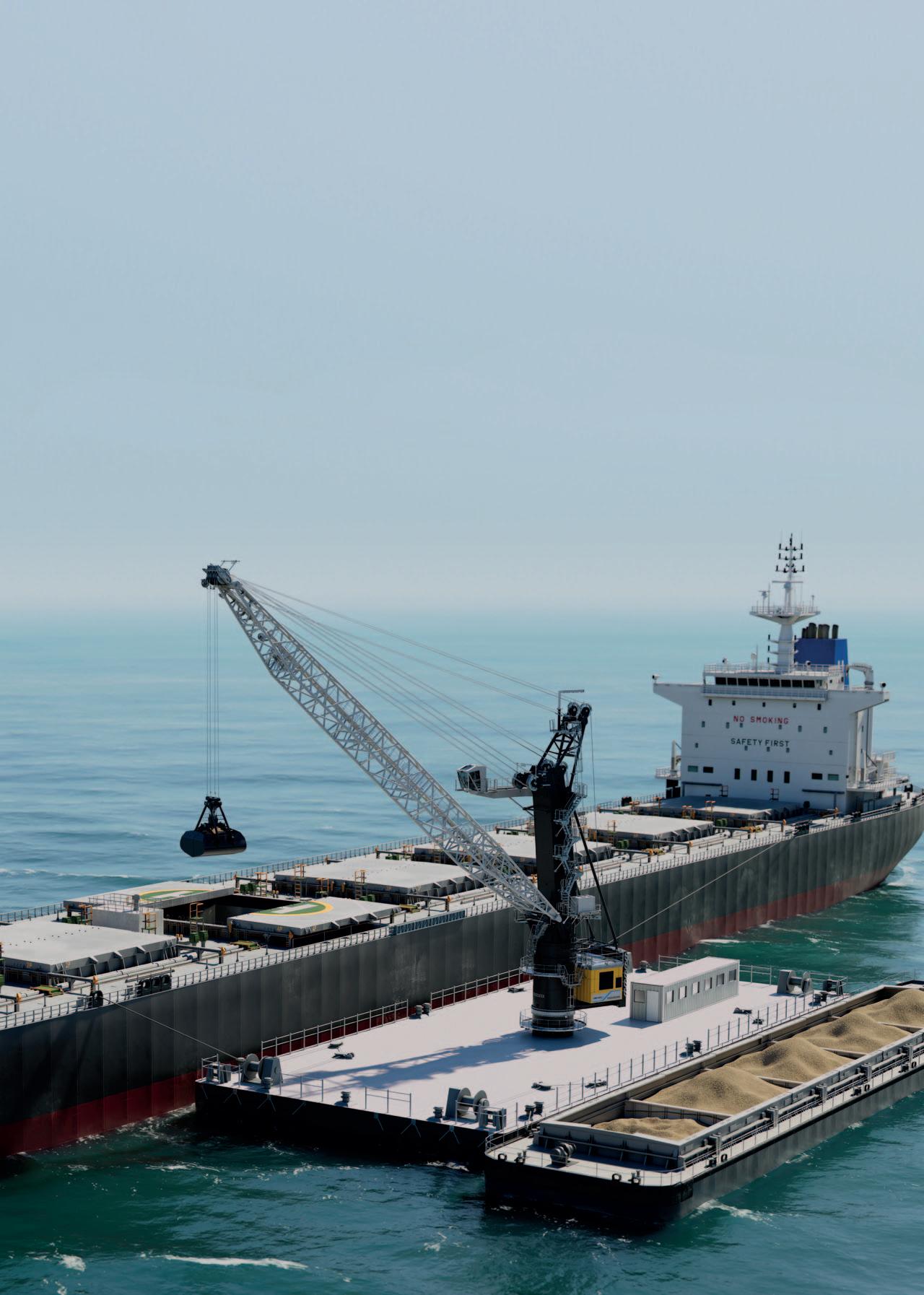 Port and transshipment solutions CBG series
Port and transshipment solutions CBG series
Enhancing productivity
with custom, innovative and energy-efficient solutions from Semperit (Sempertrans)
Conveyor systems are the most commonly used mechanisms for the handling or transportation of bulk solid in the mining, cement, steel, power, harbour, chemical and fertilizers industries etc. The effective handling or transportation of bulk solids is a critically important aspect and therefore reliable, cost-efficient, optimum performance and life expectancy of conveyor belts plays a very vital role in the success of a plant’s productivity, cost per tonne and performance.
The advancement in conveyor technology in terms of the transportation of bulk solids over a longer distance — negotiating horizontal as well as vertical routing efficiently without polluting the environment — is also eliminating the conventional transport of bulk solids by road with long-distance open or closed conveyor systems.

Semperit AG Holding has been a
renowned worldwide as a supplier of natural and synthetic polymer products for almost 200 years. The group is one of the largest and most technologically advanced conveyor belt manufacturers in the world with production facilities in Poland and India, from which it serves the global market. With more than 50 years of experience in conveyor belt technology and the relevant in-depth knowledge, Semperit knows what customers around the world expect and helps them to accelerate their operational performance. Semperit provides tailored conveyor belt solutions for the most demanding applications in the mining, cement and steel industries, as well as many others, starting from standard products such as textile belts to the highest-breaking-strength steel cord belts. Semperit ensures safe, highquality and highly efficient conveying solutions even under extreme conditions,
which require both high-performance and economical transport of raw materials and other goods.
MANUFACTURER PROFILES
Semperit’s conveyor belt manufacturing facility is located in India, namely Sempertrans India, and is among India’s most prominent manufacturers and exporters of conveyor belts. This manufacturing facility is in Roha town, 100km from Mumbai on the Mumbai–Goa Highway. The site has a state-of-the-art plant which maintains ISO 9001-2015, in addition to other high-quality standards relating to conveyor belting manufacturing.
Sempertrans India offers a broad range of high-performing conveyor belts for applications in the mining, cement and steel industries, as well as for other applications such as ports, power and heating plants, quarries and the chemical industry with
ENGINEERING & EQUIPMENT 44 NOVEMBER 2022 DCi www.drycargomag.com
Multitrans product, quarry in France (all photos: ©Semperit AG Holding).
international standards and are optimized to meet its customers’ specific requirements.
Sempertrans India uses the latest technologies for developing, testing and manufacturing high-quality belt solutions. These belts are manufactured with specially formulated compounds and high precision. The highly skilled professional research and development team of Sempertrans India is constantly in search of new innovations and upgrading the existing techniques applied in the manufacturing of conveyor belts.
Sempertrans India’s ambition is to be a trusted partner for its customers and to help enhance their business operations with innovative and reliable solutions. Sempertrans India places particular importance on the quality of its products and services, as well as creating long-term value to all its stakeholders by delivering excellence and effectiveness in anything it does. Sempertrans India strives to ensure that its customers achieve maximum operating life with the lowest cost of ownership achievable.
Sempertrans India’s strengths are combined in: world-class polymer processing v equipment; products that adhere to national & v international standards such as IS, CAN, etc.; world-class belt testing equipment; v comprehensive production practice v with complete traceability of
materials; experienced professionals and skilled v employees; and a global R&D centre in Wimpassing, v Austria.

SUCCESS STORY IN INDIAN CEMENT PLANTS
The Indian cement industry’s demand to expand the capacity of existing plants has resulted in the increase of the handling capacity of all associated conveyor belts. Consequently, the material cooling time in the storage of plants has reduced and increased the demand for conveyor belts to handle higher-temperature materials. Heat causes the rapid acceleration in the ageing process of the polymer, consequently hardening and cracking the polymer covers.
The higher temperatures of material handled also has a very destructive effect
on the carcass of the belt as it damages the adhesion between the covers on the top and bottom of the carcass and the adhesion between the inner plies confined within the carcass, consequently, the plies start to separate.
Since the heat-resistant polymer covers on the top and bottom of the belt work as a wall between the heat source and the carcass; this protects the carcass from heat damage. Therefore, the heat-resistant properties of the covers need to be selected very carefully considering the actual operating temperature of the plants.
In late 2016, Sempertrans India captured site data of one of the biggest cement manufacture plants, which is located in the western part of the country. The basic aim of Sempertrans was to study site operating conditions and accordingly verify the

ENGINEERING & EQUIPMENT 45 NOVEMBER 2022 DCi www.drycargomag.com
Semperit entrance in Wimpassing, Austria.
Sempercord at Belchatow, Poland.
conveyor belt specification. After studying the site data, Sempertrans experts established the variation in belt specification, pulley diameter etc. from the requirement of site operating conditions. Subsequently, Sempertrans India selected the suitable cover grade and fabric of conveyor belts needed and delivered them to the site. The customer then installed the belt in 2017 which gave improved performance over the expected life and availability.
Sempertrans India collected the data of various cement plants, which show the significant variations in the temperature from plant to plant of the same cement producer. Thus, the selection of conveyor belts is always based on the plant operating condition and not as a standardization practice for all the plants and subsequently Sempertrans India started offering the conveyor belt specifications after studying the site operating conditions. These operating conditions consisted of the operating temperature and the variations of those which the operating site had, in comparison to different industries. These studies have led to the development of the cover grade mainly SHR, UHR and UHR+ and the provision of the customized solutions to the Indian cement, steel and other industries.
The successful development of the cover grade with support of the Global R&D centre in Wimpassing, Austria for handling of higher temperatures, Sempertrans India has started the production of conveyor belts with TEA, TEA-P, TEC, TEC-K, SHR, UHR and UHR+. This development has provided offshore as well as onshore customers with the possibility to handle the material with higher temperatures in their plants.
Sempertrans India is now supplying the application specific products to the Indian cement plants and plant owners witnessed the increase in overall availability of the system, the longevity of the conveyor belt and consequently the improved productivity. Consequently, Sempertrans has a more than 60% share in their present requirement of belts for handling of higher temperature materials to their various plants located in western, southern and central parts of India.
CONVEYOR BELTS UNDER INSTALLATION
The graph above presents the various grades of conveyor belts manufactured and/or under manufacturing from the recent on-shore as well as off-shore contracts by Sempertrans India, supplied to various industries.

quantity (in m) of conveyor belts under installation, manufactured by Sempertrans India (quantity in metres)
The quantity (in m) of conveyor belts supplied between 2019 and 2021, manufactured by Sempertrans India (quantity in metres)

CONVEYOR BELTS INSTALLED IN THE PAST THREE YEARS
The following grades of conveyor belts have been manufactured by Sempertrans India and supplied to various industries located on-shore as well as off-shore during the year between 2019 and 2021.
TECHNOLOGICAL DEVELOPMENTS
Standard conveyor belts are not suitable for the handling of high heat materials and will quickly deteriorate. Such deterioration of conveyor belts always creates safety hazards, damages of conveyor components and costly belt replacements. Semperit conveyor belts are developed to handle extremely high temperatures up to 400°C short term peaks.
The right cover for high temperatures ensures the longest belt life. The standard types of Transtherm covers are:
CW: the cover grade especially designed v for the transportation of coal, providing medium heat resistance combined with flame-retardant properties according to DIN EN ISO 340.
TEA: the cover grade with excellent v
mechanical properties, providing heat resistance for medium temperatures. In specific markets TEA is also known as HR.
TEB: the cover grade for high heat v resistance and special applications such as transporting chemicals. In specific markets, the cover grade SHR is available for this temperature range, if no specific resistance to chemicals is required.
UHR: the efficient cover grade v providing heat resistance for high temperatures up to 200°C short term peaks.
UHR+: the efficient cover grade v providing heat resistance for high temp eratures up to 250°C short term peaks.
TEC: the cover grade for extremely v high temperatures up to 400°C short term peaks.
CONCLUSION AND RECOMMENDATIONS:
There is always a major difference between the temperature of the product conveyed and the temperature transmitted to the cover by the materials conveyed. This
ENGINEERING & EQUIPMENT 46 NOVEMBER 2022 DCi www.drycargomag.com
The
difference between the surface temperature of the belt and the inherent temperature of the product conveyed may vary according to various parameters:
a) The actual temperature range of the materials being conveyed on that conveyor, the maximum continuous temperature of the conveyed material and the maximum temporary peak temperature.

b) Particle size distribution of bulk material conveyed: the type and nature of the material i.e., with fine particles usually cause a greater concentration of heat on the belt surface. The coarse material allows better air circulation, which allows the heat to dissipate.
c) Length and speed of conveyor: the length and running speed of the conveyor plays a critical role in the life of a conveyor belt. The rapid acceleration in the ageing process of the polymer and shorter conveyor length has less time to cool down on the return side (empty belt). The higher temperature and abrasive materials are at speed on a short conveyor is the toughest combination of all and many heat-resistant belts often last only a few weeks or months before having to be replaced. But there are heat-resistant belts available that are capable of lasting two or three times (or more) longer.

d) Type of installation: the installation of conveyor belts with covering or in closed gallery prevent the proper ventilation.
DCi
ENGINEERING & EQUIPMENT 47 NOVEMBER 2022 DCi www.drycargomag.com
Sempercord product.
Cement, Multitrans.
Cleveland Cascades is in the final stages preparing for the departure of another iron ore loading system to be used in conjunction with its customer’s mobile shiploader.
Cleveland Cascades to supply system
With an extended length of 20.5m measured from the head chute interface to the base of the skirted outlet, the use of a locally mounted spool type hoist is employed in order to retract the system to


a non-operational height of 6.1m. This is to allow for sufficient clearance when exiting ship holds once loading operations have ceased.
The system utilizes Cleveland Cascades
ENGINEERING & EQUIPMENT 48 NOVEMBER 2022 DCi www.drycargomag.com
handle iron ore cargoes to handle iron ore cargoes
to
900 sized cones and is capable of loading iron ore at a nominal rate of 750tph (tonnes per hour) and a maximum rate of up to 900tph.



Due to the abrasive nature of the material and the specified particle size for this project, ceramic tile lining was selected for both the pivoting head chute area and the cones. This liner choice provides a cost-effective solution with more than sufficient wear resistance without impeding the flow of the product. Furthermore, ceramic tiles can be expected to ensure longevity with an increased life span when compared with other available liner options such as polymers.
Included in Cleveland Cascades’ scope of supply is a full electrical suite of components necessary for the safety and automation of the system. DCi

ENGINEERING & EQUIPMENT 49 NOVEMBER 2022 DCi www.drycargomag.com
Why the right tools matter...
... when handling and storing cement
Dodds-Ely
Green
applications in the cement industry
The cement industry is increasing every year, due to the continuing growth in industrialized and urbanized areas with consequent construction of new buildings, roads and infrastructures. Most of this new development is taking place in emerging countries.
At the same time, cement factories are major contributors to global CO2 emissions and dust emissions, both of which have high environmental impact.
Recently, the common goal has been set from keeping the temperature rise below 2° Celsius at 1.5° Celsius. More than 77 countries are committed to controlling and reducing the impact of the cement industry on environment by 2050.
Reducing the emissions of the cement industry will play a pivotal role in addressing the climate challenge. Companies will need to identify the best paths through technological innovation, eco-friendly equipment, and modern technology in order to ensure the highest environmental standards.
Bedeschi is committed to help reaching this global goal thanks to its 110 years of experience and the wide variety of solutions that it can offer. The R&D Department of the company is constantly working to improve the capability of all systems, focusing on environmental protection, energy efficiency, investments into eco-friendly and innovative equipment and pollution prevention.
The solutions Bedeschi is improving in its machines to reduce dust emissions and material spillage during bulk material operations are several: a careful selection of belt width and speed according to the handled cargo; the installation of belt conveyors and trippers in enclosed galleries; the use of pipe conveyors and enclosed conveyors; the use of gas cleaning and water spray for dust suppression, telescopic or spiral chutes; implementation of eco-hoppers; and the use of different conveying systems, like screw conveyors and chain conveyors.
Besides avoiding spillage and dust emissions, the use of a pipe conveyor makes it possible to get rid of several transfer points between straight conveyors. This solution reduces the consumption of energy need to handle the material, not to mention the energy used for the filters and other suppression systems to lower dust emissions. Fewer transfer point in a plant means fewer chutes, cables and other auxiliary equipment installed, with a positive payback in terms of erection timeline and related environmental cost. Without transfer towers a lot of steel fabrication is saved, as well as foundation works, and erection activities, thus reducing the overall carbon footprint of the plant and its environmental impact.
Moreover, Bedeschi is extremely proud to work closely with its clients in projects that aim to use alternative fuels to limit the
use of fossil-type fuels, as well as cutting plant power consumption.
Below are some of Bedeschi’s latest applications to guarantee environmental safeguard and avoid dust pollution:
MELON – CHILE
Bedeschi supplied a new eco-hopper to Melon S.A. The unit will operate on the austral port of Punta Arenas, Chile.

The eco-hopper is designed for direct unloading of clinker to trucks at a rate of 600tph (tonnes per hour) and is designed to work with 12m3 grabs. The machine is equipped with pulse-jet bag filters with high filtration capacity and performance and with low compressed air consumption: an economical and flexible solution to satisfy the stringent environmental standards required.
“The eco hopper has been a crucial part of the project, and the results in environmental matters are very satisfactory” confirmed Pedro Pinto, Corporate Technical Manager of Melon.
A set of four bag filters are mounted in the volume between the upper receiving hopper and the hopper main body. The bags are automatically cleaned with a pulse jet system and all the particles removed from the bags simply fall inside the hopper itself. Access platforms are provided for an ergonomic and safe replacing of the bags. A fan outlet with silencer provides noise reduction.
ENGINEERING & EQUIPMENT 50 NOVEMBER 2022 DCi www.drycargomag.com
Bedeschi eco-hopper in Punta Arenas, Chile.
Louise
The eco-hopper is equipped with a fully covered feeder conveyor to avoid dust dispersion due to wind action and it maximizes the efficiency of the dedusting filters.
For clinker loading inside the truck, there is a dust controlled telescoping spout. The automatic lifting control keeps the skirt in constant contact with the forming pile, to avoid fugitive dust. An aspiration system keeps the inside of the chute depressurized. Bedeschi’s ecohopper can guarantee to contain and minimize emission during every unloading phase, both from ship to hopper and from hopper to truck, and as a result, the company “has been able to fulfill and exceed the environmental regulations” says Pinto. “The teamwork between Melon and Bedeschi has developed a creative tailormade solution that allows it to operate in a multipurpose port,” he added.
In fact, the eco-hopper is designed with a special support structure that allows a solid anchoring of the hopper to the pier structures during unloading operations, but at the same time it allows the machine to be moved by means of SPMT (selfpropelled modular transporter) when not in use.
This configuration is made necessary by the multi-purpose nature of the Punta Arenas port and due to structural limitations of the existing pier. These operational constraints have forced our engineers to find a winning solution in terms of flexibility of use, weight limitation and structural strength.
SECIL – PORTUGAL
Incorporating alternative fuels such as waste and biomass to replace fossil fuels, a multi-decade trend in the industry, could reduce emissions by nearly 10% by 2050.
SECIL Group has awarded Bedeschi a contract for the supply of a new pipe conveyor to handle different kinds of alternative fuels at Outão Cement Plant in Portugal.

This project further strengthens the co operation started with SECIL more than 20 years ago and it is part of the major R&D Clean Cement Line (CCL) project.
The CCL project, aims to bring the Outão cement plant to the forefront of energy efficiency and lowest CO2 emissions among the European cement producers. The project is partly funded by the Portugal 2020 Government incentives programme, and it aims to develop a new concept of cement production. Bedeschi’s supply to SECIL Group will contribute to the elimination of dependence on fossil fuels.
The concept of Industry 4.0 will become essential for the plant’s management for improving efficiency and optimizing the processes, therefore a digitalized system will be integrated into the whole plant.
Bedeschi engagement in this project is among the activities implemented by the Italian company to contribute reaching some of the sustainable development objectives, especially environment protection, as established in the Agenda 2030 by the United Nations. For many years, Bedeschi has been working hard in this direction for achieving these goals.
The pipe conveyor with a diameter of 250mm and conveying length of 350m will grant a safe and clean transportation of alternative fuels at a rate of 300m3/h. Bedeschi will design and supply the complete pipe conveyor system, delivering the structure in pre assembled trans portable modules to allow a smooth and trouble-free erection.

The pipe conveyor solution has been selected for this application as it is a modern and environmentally friendly transport system solving numerous problems that are associated with conventional conveyor systems (i.e. spillage of materials, limitations with regard to steep incline and curve
layout, etc.) and transportation of difficult materials.
There isn’t one global solution that fits all the stakeholders of cement industry, and it will be a long journey to turn it into a green industry. Bedeschi is finding its own solutions to make a positive impact in this process.
Thanks to research and development in green technology, Bedeschi is able to design and produce machines and turnkey installations reaching the highest environmental standards. The company is fully committed to the fundamental aim: guarantying a sustainable model for the future.
ENGINEERING & EQUIPMENT
ISO 9001 21055 Gorla Minore (VA) - Italy Phone +39 0331 36.51.35 Fax +39 0331 36.52.15 Via A. Colombo, 144 www.sig.it E-mail: sig@sig.it CONVEYOR & ELEVATOR BELTS STEEL CORD & TEXTILE WE MANUFACTURE IN ITALY TO SUPPLY ALL AROUND THE WORLD 3D design of SECIL pipe conveyor.
Vurmak’s focus on tailor-made systems enriches its customer-based approach
Founded in 1997, Vurmak is a brand that provides cost-efficient, up-todate technological solutions, mainly to the concrete and cement industries. The company boasts a team of 250 personnel, a number that is growing day by day.
Vurmak’s initial product range was confined to batching plant equipment. However, today, the company offers a wider range of equipment, and works as a serial manufacturer for concrete batching plant equipment and a solution provider for cement companies with tailor-made equipment, specifically designed for their needs.

The latest project to be developed by Vurmak’s research and development team is bulk ship-unloaders. These are now operating all around the world, and have become a global success. They aim to minimize the cost of importing bulk material. Vurmak’s vision is to minimize the previously huge burden of initial investment required for such equipment by keeping the same quality of technology and thus not only increasing the profitability of the company’s customers but also, consequently, minimizing the price of products for end-users, especially in third world countries.
As Vurmak Machinery, the company’s product range includes, but it not limited to: a wide variety of concrete batching plants; batching plant equipment; pneumatic conveying systems; mechanical conveying systems; cement packing machines; shiploaders and unloaders; automation and
software systems related to cement and concrete production; and storage facilities.
However, a major part of the company’s business is tailor-made systems for cement terminals or terminals themselves. The wide variety of products that Vurmak manufactures, and its expertise in conveying systems, enables it to mix and match different equipment to create complete systems with a central automation system for its partners.

Vurmak also focuses on customers’ needs and limitations to design a system rather than providing rigid, standard machinery. In this way, it creates a relationship with customers that is based on providing solutions and creating win-win situations. This partnership-based model with clients enables Vurmak to select its customers accordingly and lets it focus on the technological advancement of the cement and concrete industry, rather than focusing on short-term profitability. This is why its concrete batching plant automation system is the market leader in Turkey and is enjoying a rapid expansion all around the world.
As the global trend for companies shifts to lean manufacturing methodologies, Vurmak is aware that any establishment unable to keep up with this trend is inevitably doomed to fail. However, from the day it was established, Vurmak’s working principle was to provide lean manufacturing methods with its machinery and automation systems to its partners and adapt them itself as well. That is the reason why Vurmak and its partners are thriving in these times of hyper-competitive business environment. The mix of lean manufacturing methods and manufacturing custom equipment, differing from product to product that Vurmak inevitably embraced have created a flexible structure to the company that can adapt to the needs of the contemporary. Also, its expertise in central automation systems — ranging from ERP integrations to CRM services — have created a base that it can adapt to any system.
Furthermore, the thorough field experience of its team, matched with its expertise in automation systems, creates an environment of constant product develop ment, with mixer washing machines, cement packing machines, telescopic belts being the newest equipment that Vurmak has developed in the past two years.
However, being able to develop both mechanical and pneumatic ship-unloaders, being able to produce them in sizes that can handle ship sizes up to 50,000dwt, and which are also suitable for any mobility (road mobile, dock mobile, on rails), with
ENGINEERING & EQUIPMENT 52 NOVEMBER 2022 DCi www.drycargomag.com
THE BEST BULK TRUCK LOADER IN THE WORLD
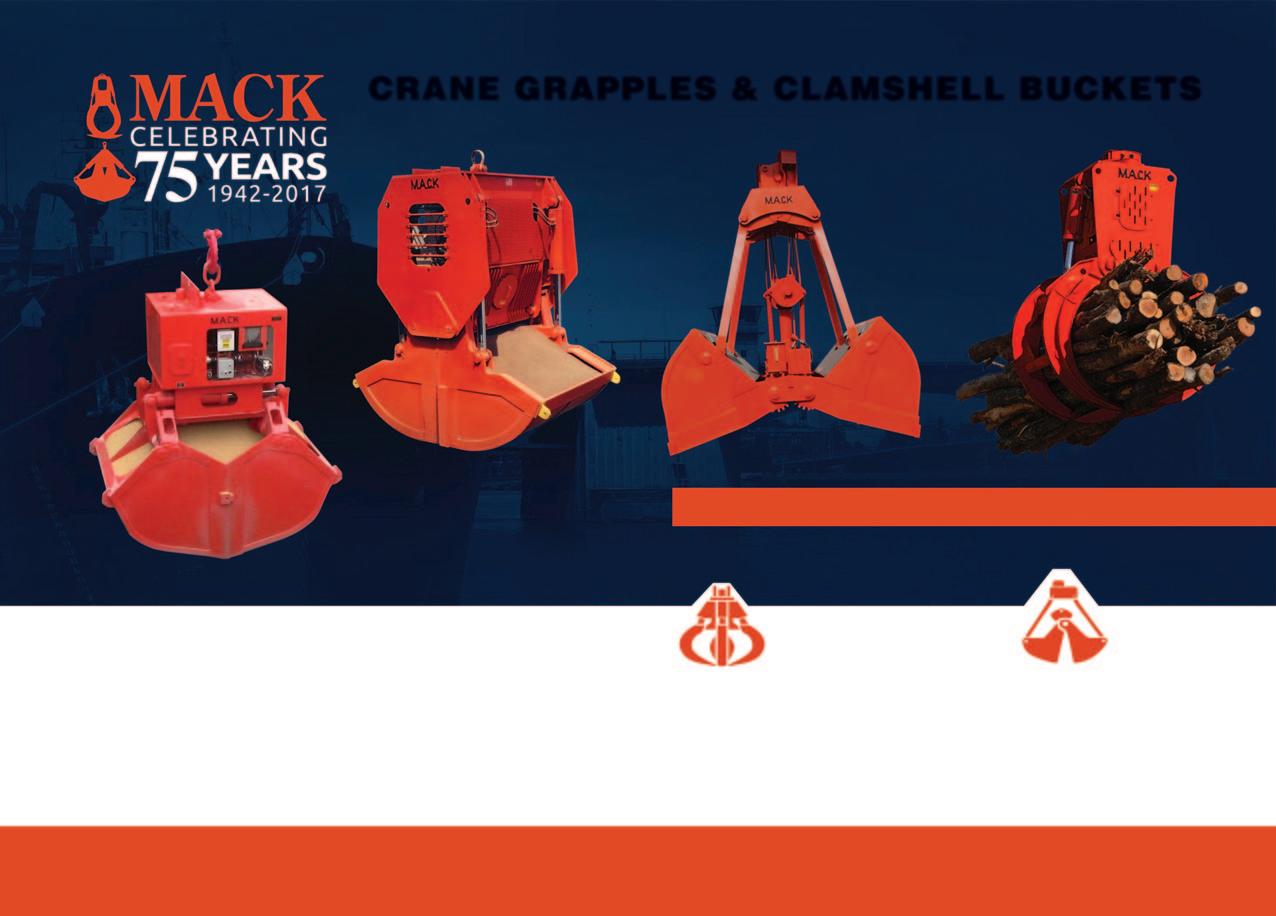








www.dino.nl


































Deployed as the most effective way to load a truck with bulk goods.




material limits
Nothing should stand in the way of your productivity – least of all the materials you move. With our compact Hägglunds direct drive systems, you can adapt easily to the job at hand, taking advantage of full torque at an in昀nite range of speeds. And should an overload try to stop you, the drives’ low moment of inertia and quick response will keep your machines protected. We’ll support you too, with an agile global network and smart connectivity to bring you peace of mind. Driven to the core.
Hägglunds is a brand of Rexroth. www.hagglunds.com
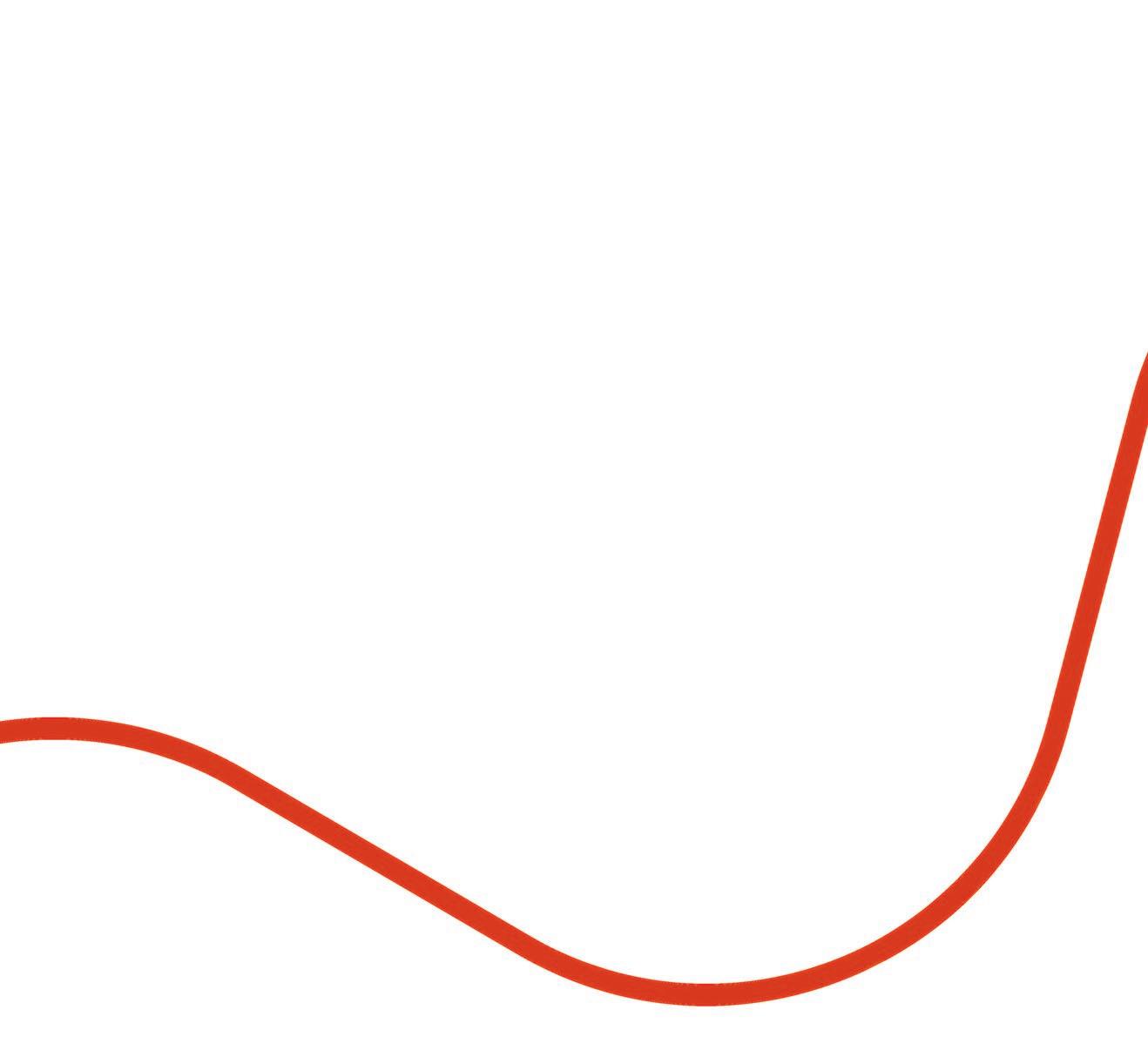
the same level of quality of European competitors, have been Vurmak’s biggest success so far and moved the company recognition to another level.
Finally, the technological and monetary competition with European competitors, especially in the field of handling bulk materials, have created a great competitive environment that Vurmak thrives on.


There is a world-wide shift to accessibility and affordability to these machineries, which aligns with the company vision, and Vurmak takes pride being a vanguard to this shift.
Just as it is with its other equipment, Vurmak has embraced a mix of standard products, such as unloaders that suit all required regulations to travel on road, have a capacity of 150tph (tonnes per hour) and can service 5,000dwt ships, with customtailored products — such as implementing the unloading systems into the cargo
carriers themselves with capacities such as 450tph.
In conclusion, the team of Vurmak embraces competition and views it a means of technological advancement, and increased affordability to all its customers,
and even, ultimately, the end-user. With its expert team of engineers and developers, Vurmak challenges all its competitors to upmost advancement and it believes that this is the root of its and its partners’ success.
ENGINEERING & EQUIPMENT
Is high-vibration screen media right for your operation?
There is no shortage of options for different kinds of screen media available today, writes Lars Bräunling, MAJOR director of product technology. From woven wire to polyurethane and perforated plate, it is possible to equip a screen box with a variety of different types of media. Highvibration screen media has grown in popularity as a way to improve efficiency and virtually eliminate issues like blinding, pegging and clogging. Users must decide if this type of screen media is right for their operations.
Here are a few things to consider:
COST
Traditional screen media options — for fertilizer, as well as other commodities — such as woven wire, offer a lower up-front cost. Price alone has historically made woven wire a more popular option. Many mining and aggregates operations are realizing, however, that investing in a more advanced option like high-vibration media, actually saves money in the long-term. This can be achieved through longer wear life, reduced downtime for cleaning and changeouts, increased efficiency and capacity or extended uptime. Often it is a combination of several of these effects.
WEAR LIFE
High-vibration screen media and other specialized designs tend to offer a much longer wear life than traditional options like woven wire. Woven wire and some types of self-cleaning media have cross wires that are subject to high-wear spots, leading to a shorter wear life. Alternatively, highvibration screen media uses highly engineered wires held together with
polyurethane strips, eliminating the need for cross wires. The design extends wear life by as much as five times longer than traditional screen media, while also optimizing open area.
BLINDING, PEGGING & CLOGGING Issues like blinding, pegging and clogging hamper an operation’s profitability potential. While some screen media is tapered to try to mitigate these problems, their design often limits the extent to which they can resolve severe issues. The independent wires in FLEX-MAT cause high frequency vibrations from hook to hook that magnify those produced by the screen box. This virtually eliminates pegging, blinding and clogging, and reduces risk of material contamination.
Better screening performance often depends on open area — a factor limited with traditional screen media. Highvibration screen media offers as much as 30% more open area than woven wire, and 50% more than polyurethane or rubber panels, enabling more material to be sized accurately in less time.
EFFICIENCY
Screen machines are a vital contributor to a plant’s productivity when they are operating efficiently. However, poor screening creates challenging bottlenecks that hold back the entire operation and reduce production volume. Certain screen media options actually amplify the screening process to offer unparalleled efficiency.
High-vibration screen media, for example, operates at an intense frequency— up to 8,000 to 10,000 cycles
per minute. That’s 13 times the vibration frequency of a standard screen box. This enhanced vibration accelerates the material stratification process, sending fines to the screen surface quicker and maximizing contact with the screen surface to improve throughput and eliminate carryover. So not only is material moving through the plant faster, the result is also a cleaner product with less risk of material contamination.
FINDING THE RIGHT FIT
When it comes to screen media selection, there is a lot to choose from, but more and more aggregate and mining operations are finding that high-vibration screen can take their production to the next level.

Screen manufacturer MAJOR has all the information on FLEX-MAT high-vibration screen media, and where it can fit in an operation.
ABOUT MAJOR
MAJOR is an innovative global manufacturer of wire screens for the aggregate, mining and recycling industries. FLEX MAT®, the company’s renowned line of distinctive lime-green high vibration screens made with OPTIMUMWIRE® ‘The longest-lasting wire’ sets a high standard in lowering the cost of production per tonne by dramatically increasing throughput and wear life while eliminating blinding and pegging. MAJOR masters wire quality, screen manufacturing and the screening process, and provides onsite screening performance assessment and training seminars on screen maintenance and screening efficiency to help producers increase their screening performance and profitability. MAJOR is a Haver & Boecker company.
ENGINEERING & EQUIPMENT 56 NOVEMBER 2022 DCi www.drycargomag.com
RopeCon ® Ef昀cient Solutions for Bulk Material Handling
Wherever bulk material needs to go – across impassable terrain, rivers, highways and buildings – RopeCon ® delivers without a hitch!
Long distances, capacities of up to 25,000 tonnes/hour, minimal environmental footprint, quiet operation plus low operating and maintenance costs: These are the features that convinced leading mining businesses.
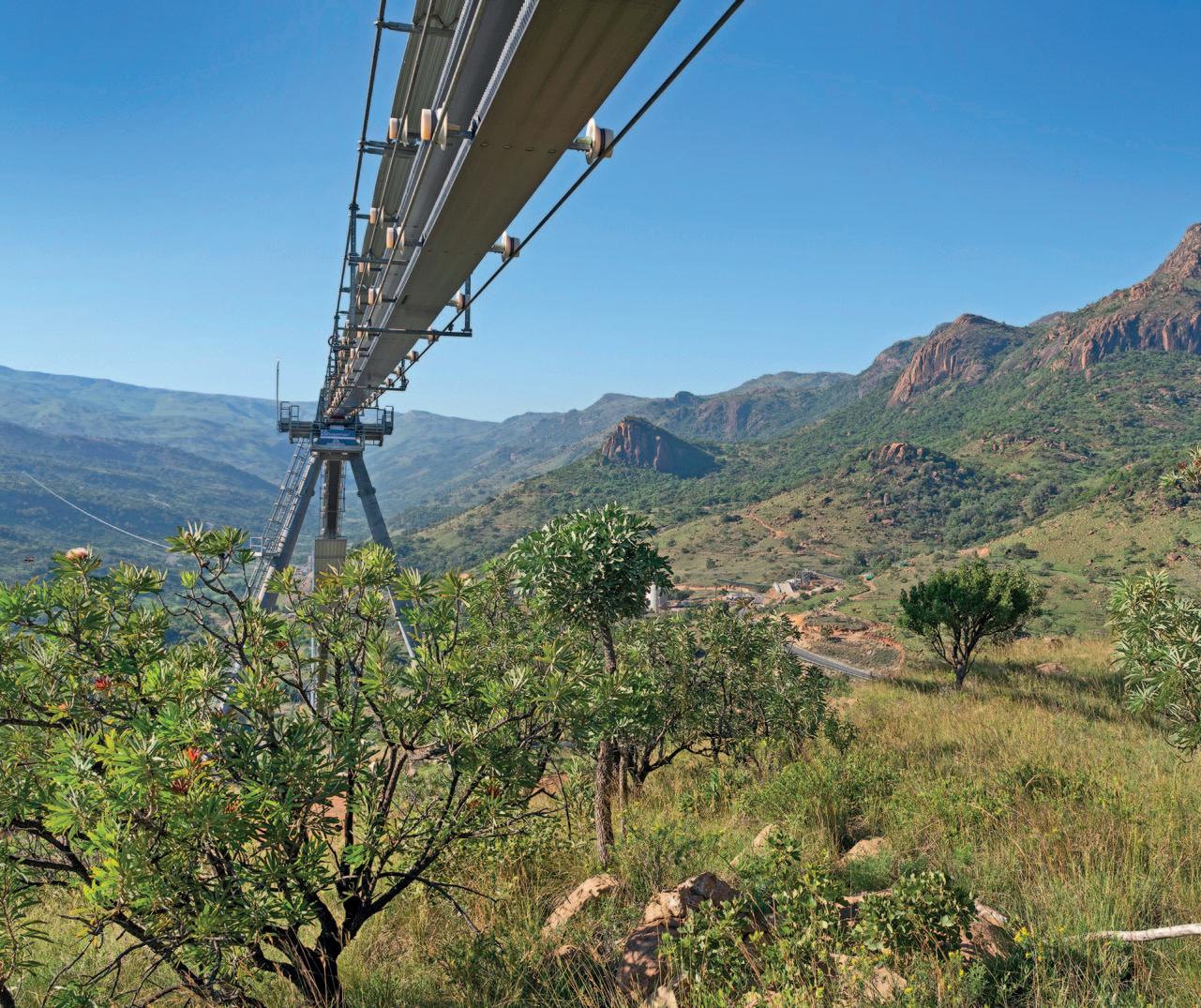
doppelmayr-mts.com
Declogging inside silos: the Airchoc® 6 solution simplifies maintenance and spare parts costs
Created in 1978 by the French company STANDARD INDUSTRIE International, the AIRCHOC® is an air cannon that is placed preventively on raw material storage units. Thanks to regular shots, it makes it possible


AIRCHOC®AC615
+ Solenoid valve.
to avoid production stops due to material accumulation. The unit is particularly appropriate in cement handling operations. The AIRCHOC® is a cost-effective maintenance solution that uses 6 bar
compressed air only when the shots are activated. It is suitable for use with many bulk commodities, including cement.
STANDARD INDUSTRIE International’s technical teams study an optimal installation recommendation according to the clogging factors and the environment of use (risks, high heat zone, corrosiveness, humidity).
Particularly attentive to its customers’ requirements, the design office team spent nearly three years testing modifications to its legendary AIRCHOC® air cannon, with the following results:
the quick exhaust valve was replaced v with a pneumatic valve system that improves impact force; the silencers have been replaced by a v protective cap which, in addition to protecting the new valve system, absorbs the noise caused by the shots. The main advantage is that there is no risk of clogging in the exhaust system; and as these two wearing parts (quick v exhaust valve + silencer) are removed
ENGINEERING & EQUIPMENT 58 NOVEMBER 2022 DCi www.drycargomag.com
AIRCHOC 6 new range on the test bench at STANDARD INDUSTRIE.
artin Engineering, the bulk material handling industry’s leading authority on conveyor efficiency and productivity, offers you and your team a wide variety of virtual or in-person training and education alternatives conveniently accessible via our online Foundations ™Learning Center






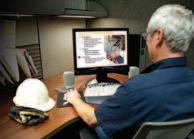
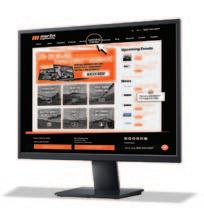
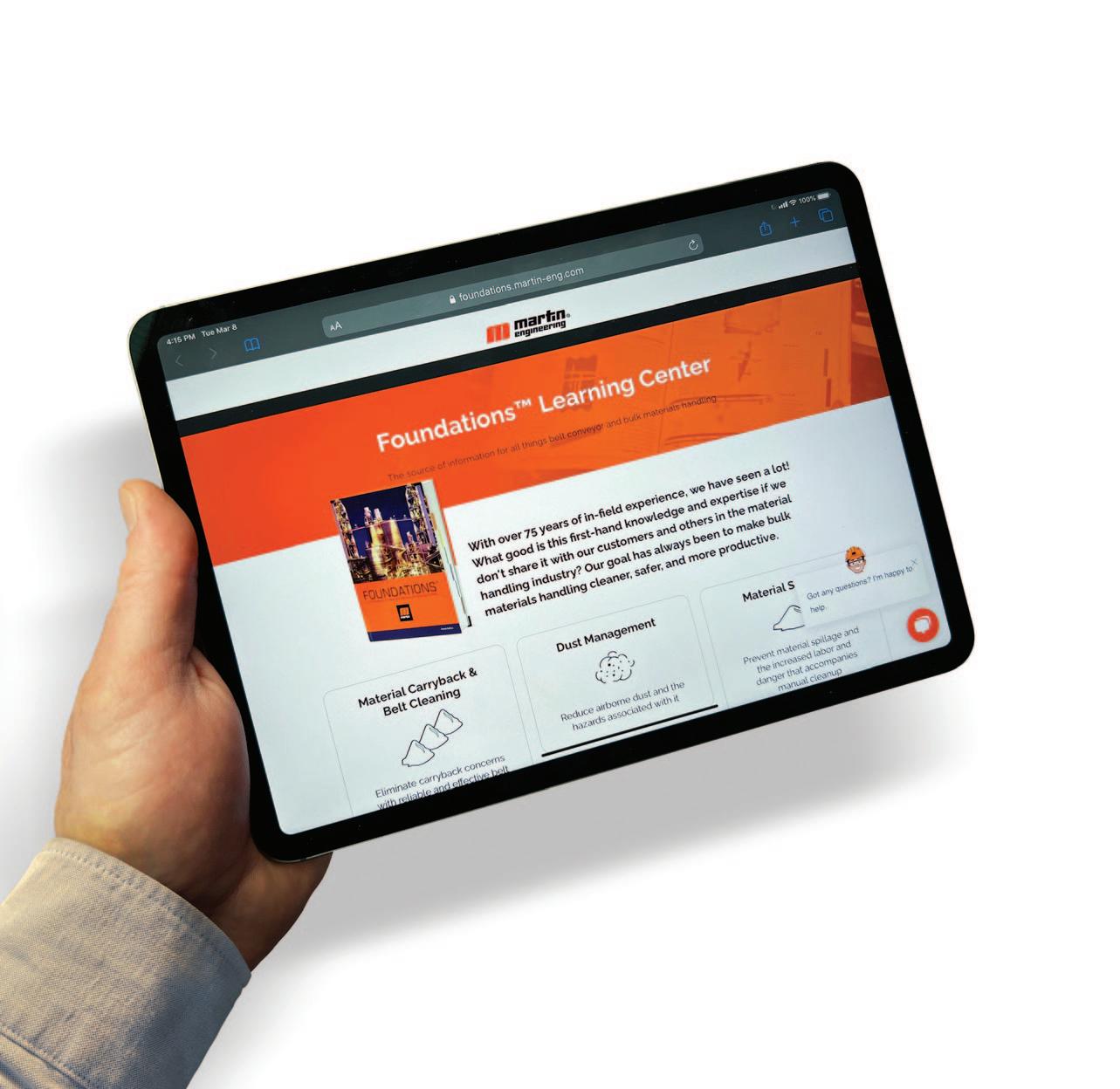
The many options available within the Learning Center bridge the theoretical and the practical — providing the information necessary for the proficient operation and maintenance of your conveyor system. Proper training is fundamental to reducing injuries, fugitive material, premature component failures, and so much more.
Learn why. Know how.
Foundations Learning Center

For factory-direct service, training and sales call 1-309-852-2384 For education and professional development options visit martin-eng.com, click the Learning Center tab.
™
from the design, maintenance is simplified and less expensive for the user.
THE BENEFITS OF THE NEW VERSION OF THE AIRCHOC® AIR CANNON
The AIRCHOC has always had the performance, profitability and safety characteristics expected by user customers. The latest innovations of the AIRCHOC® version 6 are focused on: Compressed air savings: thanks to a v better sealing of the piston and to a better impact force on the clogging (10% higher than the old version).
Indeed, the air pressure can be reduced for an equivalent result. The version 6 of The AIRCHOC® meets the challenges of the global energy saving policy.
Reliability: particularly due to an v improvement of the impact force of the shots coming from the cannon.
(No quick exhaust valve): No air passes through the piston seal, thus no wear and tear on the seal. This means that the air cannons are always available for preventive shots and thus maintain the production flow. The tests guarantee three years of shooting cycles without replacement of the triggering system.
Spare parts: these have been v streamlined and selected for their durability.
The new design of the AIRCHOC® with fewer wearing parts and components ensuring good resistance, allows for
reduced and simplified maintenance. This is a considerable advantage when maintenance operations require access at height and important safety precautions.
In this regard, STANDARD INDUSTRIE has also created an AIRCHOC® maintenance kit that avoids operators and foremen from having to perform lengthy and costly interventions.
Here again, STANDARD INDUSTRIE is responding to the need to save on maintenance and spare parts for large consumers such as cement plants.
In summary, the AIRCHOC® is the solution for plants that want to reduce maintenance and spare parts replacement on their cleaning system, and reduce their compressed air consumption.
The first few customers already benefiting from the AIRCHOC® improvements are very satisfied, as testified by Abraham Campos Figema, Maintenance Manager of the cement plant Cementos Fortaleza in Mexico.

Since 2020, this customer agreed to test the prototype of the new AIRCHOC® 6 air cannon head created by STANDARD INDUSTRIE International and placed in the plant on the kiln inlet.
After two years of use in the research and development of this product, the customer has answered the following questions:
Q: How much maintenance time do you save with this new AIRCHOC® head compared to the previous version 5 over one year of operation?
A: 24 working hours per year and less risk of intervention on the hot equipment.
Air cannon installed for a test on the kiln inlet of Cementos Fortaleza.
Q: How many maintenance kits for the quick exhaust valve have been saved in one year?
A: 24 maintenance kits.
Q: What do you think about the reliability of this new development (ACCMECBRD610) for the future?
A: The reliability is very good because there was no maintenance for one year.
Q: Have you noticed a difference between version 5 and the new prototype, what do you think about the power (impact force) of this head compared to the previous one?
A: Of course, the head is much stronger than the previous one. The impact force is good for the area where we placed it, which is the hottest area of our system.
Q: Do you need a more powerful conical head to reduce the pressure level of the compressed air and save energy and money?
A: Of course, saving compressed air means saving energy and therefore money.
Q: Do you have any other comments on your experience?
A: Yes, it is good that there are developments to increase the reliability of this equipment because it mitigates the risk of having personnel working on hot equipment. Congratulations!”
STANDARD INDUSTRIE International has succeeded in offering a solution that is both efficient and economical. Relying on its proven expertise with many bulk manufacturers around the world, the company is committed to offering reliable and durable ‘made in France’ equipment to ensure that its customers maintain their productivity.
ENGINEERING & EQUIPMENT 60 NOVEMBER 2022 DCi www.drycargomag.com
Keeping

For stubborn material carryback, the K-Rotabrush® conveyor belt cleaner is an ideal solution to ensure excess fugitive material will be effectively removed from the underside of the return belt.
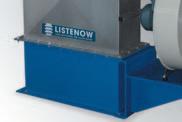

Carryback build up on conveyor hardware — especially during cement handling operations — can cause belt mistracking, as well as conveyor belt and structural damage. Material spillage may occur, which presents a potential slipping and tripping hazard. Fugitive material can also bury idlers, conveyor components, or structural supports — this requires expensive clean-up labour and replacement parts.

K-Rotabrush® will provide thorough cleaning, without compromising belt wear.
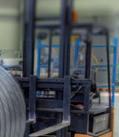


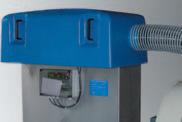

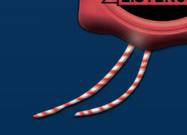

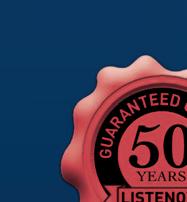
The rotary action of nylon, rubber or polyurethane bristles, sweeps wet, dry, sticky, hydroscopic, statically charged and abrasive conveyed materials off the conveyor belt. It is suitable for difficult applications such as salt, sugar, fertilizer, timber as well as cement/clinker.

The K-Rotabrush® conveyor belt cleaner is well suited to areas where space limitations apply. Often carryback occurs in awkward spaces that are difficult to safely reach; any manual labour allocated to remove the carryback is at risk of injury. The compact K-Rotabrush® will take care of the cleaning safely and effectively. It is simple to install, and maintenance is minimal.

LISTENOW GmbH & Co Dieselstrasse 21 71277 Rutesheim / Germany +49 7152 50900 listenow@listenow.com www.listenow.com LISTENOW VERLADESYSTEME FÜR SCHÜTTGÜTER › Bulk loading systems for open and closed loading › Loading with no segregation e.g. with FLOW-stop technology › Dust-free loading › High quality loading hoses e.g. made in wear-resistant PU-flex › Positioning System LIS-pos › First-class service: Start-up and installation Revision and repair services System maintenance, modernisation and upgrading › more informationen at www.listenow.com We make sure that nothing gets lost! For over 50 years, our loading systems for bulk materials have been synonymous around the world with long-lasting and reliable technology. Replacement loading hoses +49 7152 50900
cement
with K-Rotabrush® Conveyor
Kinder
conveyors clean
Belt Cleaner from
Australia
Medcem Madencilik: 41 AUMUND machines for the second kiln line
Medcem, which will increase its capacity by 90% in the first quarter of 2023, will be among the largest cement factories in the world (photo: Medcem Madencilik).

Before the end of the year AUMUND Fördertechnik GmbH, Rheinberg, Germany, will supply 41 machines for a new kiln line at the Medcem Madencilik cement plant in Silifke in the Turkish province Mersin.
The AUMUND supply package comprises six belt bucket elevators, two bucket elevators with central chain, four pan conveyors and eleven drag chain conveyors. The conveying capacities range from 50 to 900tph (tonnes per hour). The machines will be used for feeding material to the raw mill, the raw mill silo, the coal mill, the heat exchanger and the cement silo. The order also includes 13 silo discharge gates for belt conveyors and five telescopic chutes for truck loading.
Commissioning is expected to be carried out in January 2023.
AUMUND had also equipped the first kiln line at the Medcem Cement plant with various machines, commissioned in 2015. Medcem Madencilik ve Yapı Malzemeleri San. Tic. A.S. started construction on the second kiln line in August 2021, and when completed it will increase annual clinker production capacity from 3.5 to 6.5 million tonnes. According to Medcem, this makes it one of the largest cement plants in the world.
ABOUT THE AUMUND GROUP
The AUMUND Group is active worldwide.The conveying and storage specialists has special expertise at its disposal when dealing with bulk materials. With their high degree of individuality, both its technically sophisticated as well as innovative products have contributed to the AUMUND Group today being a market leader in many areas of conveying and storage technology. The manufacturing companies AUMUND Fördertechnik GmbH (Rheinberg, Germany), SCHADE Lagertechnik GmbH (Gelsenkirchen, Germany), SAMSON Materials Handling Ltd (Ely, Great Britain), TILEMANN GmbH Chains & Components (Essen, Germany) as well as AUMUND Group Field Service GmbH and AUMUND Logistic GmbH (Rheinberg, Germany) are consolidated under the umbrella of the AUMUND Group. The global conveying and storage technology business is spearheaded through a total of 20 locations in Asia, Europe, North and South America and a total of five warehouses in Germany, USA, Brazil, Hong Kong and Saudi Arabia.
Hucker-Brown on: T: +27 31 583 4360 E: info@dc-int.com W: www.drycargomag.com
ENGINEERING & EQUIPMENT
DRY CARG O international DC i TM
Advertising is important! To find out how you can benefit from advertising in the world’s only monthly dry bulk publication contact: Andrew

© 2022 Terex Corporation. Fuchs is a trademark owned by Terex Corporation or its subsidiaries. STRONG. RELIABLE. EFFICIENT. Discover More Fuchs World-Class Material Handlers www.terex.com/fuchs mhl 390 F-SERIES MHL390 F · Technical Data Engine Power: 300 kW · Operating Weight w/o Attachments: 110 t · Reach: max. 24.5 m
Van Beek’s Dino Cement: an immediate solution for truck loading

The Dino Cement has a capacity of 80m3/hour, where the capacity of a standard Dino is 40m3/hour. The inlet hopper is fitted with a crossor U-shaped blade so that a forklift truck driver can pour in the bags quickly, safely and easily. He does not have to get out to cut the big bag open and can immediately fetch the next big bag. This means a bulk truck can be filled within 30 minutes.

On the inlet hopper is a screening deck with vibrator. This separates the large chunks and lumps from the cement powder. The vibrator breaks down the chunks so that they can flow freely. The inlet hopper itself is fitted with fluidizing pads. These spray air into the product and create an ‘air film’ on the inside of the inlet hopper so that the product can flow into the screw more easily.
Van Beek’s standard models offer an immediate solution to suit most situations. Many decades of experience have shown that a specific challenge often requires a customized Dino, something Van Beek understands better than most. Its sales engineer works together with the customer to assemble a bespoke Dino, configured to meet specific loading operations.
ENGINEERING & EQUIPMENT 64 NOVEMBER 2022 DCi www.drycargomag.com
The Dino DS400 Cement from Van Beek has been adapted for loading big bags of cement and cement-like products such as limestone, soda ash and bentonite into bulk trucks.
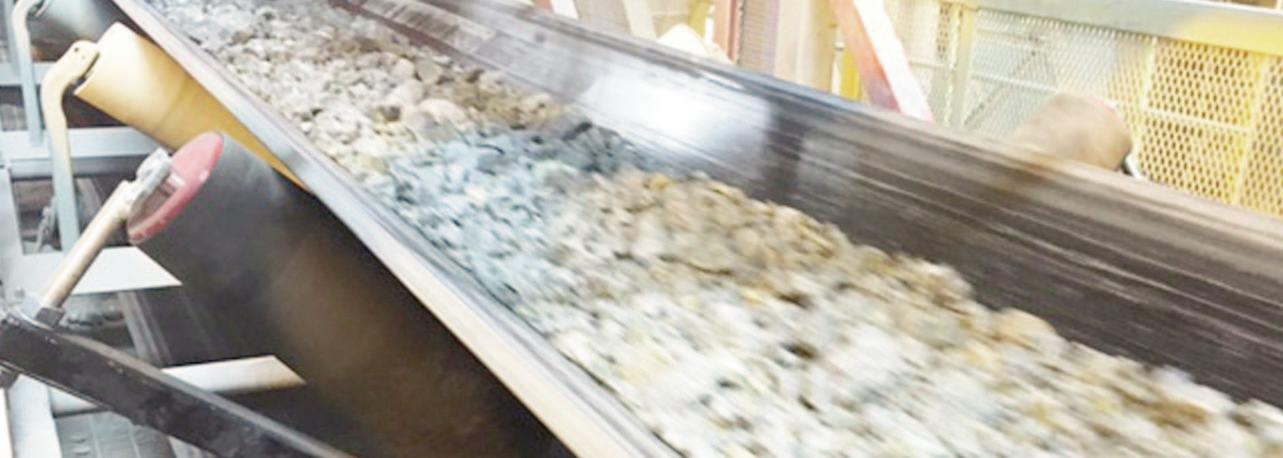


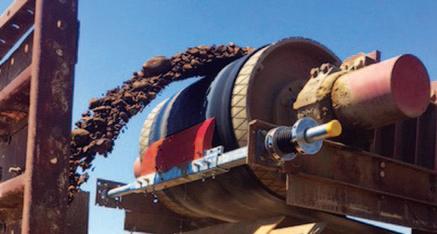

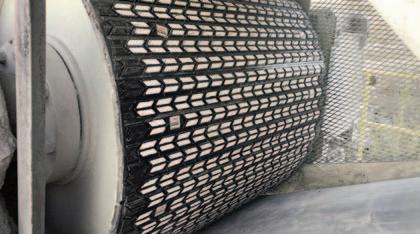


PROVIDING THE WORLD’S MATERIAL HANDLING INDUSTRY WITH EFFICIENT, SAFE AND PRODUCTIVE www.asgco.com | 800.344.4000 | info@asgco.com BC-2 CONVEYOR BELT CLEANER SUPER-SKALPER® BELT CLEANER SAFE-GUARD® CONVEYOR GUARDING ARROWHEAD® CERAMIC PULLEY LAGGING ENGINEERED LOAD ZONES TRU-TRAINER® TAPERED TROUGHER IDLER FROM THE TO THE AND EVERYTHING IN BETWEEN... Ask about our Conveyor Training Webinar Programs! TAIL PULLEY HEAD PULLEY • SKIRTBOARD & SKIRTING SYSTEMS • TRANSFER POINTS DESIGN & FABRICATION • VULCANIZING EQUIPMENT • WEAR LINERS • BELT CLEANERS • IDLERS • LOAD ZONE SUPPORT SYSTEMS • POINT CLOUD SCANNING • PULLEY LAGGING • SAFETY EQUIPMENT & GUARDING
GAMBAROTTA GSCHWENDT: the state of art for super-capacity chain bucket elevators
Since 1919 GAMBAROTTA GSCHWENDT has been developing and manufacturing loads of bucket elevators for lifting a wide range of bulk solid materials.
Thanks to its continuous research and development effort and to the quality of its equipment, addressed to their maximum reliability, GAMBAROTTA GSCHWENDT maintains a good position among the leading manufacturers of this sector.
This article focuses on one of GAMBAROTTA GSCHWENDT’s bucket elevators — the ESPLV.

The ESPLV is a double-chain bucket elevator that can be considered one of the most modern among heavy-duty elevators providing the highest flow rate: 2,000m3/h and higher.
The large-sized buckets are one of the main features, with a capacity up to 290 litres each on the largest elevators.
Mechanical chains have pin and bush, also designed for very high breaking loads (up to 4,000kN).
Thanks to the continuous buckets, these GAMBAROTTA GSCHWENDT bucket elevators have great flexibility allowing both slow and high speeds. They are perfect when a low speed is required (less than 0.7m/s), as in the case of lifting granular fertilizer material or for lifting mediumsized materials (50 100 mm). Never theless high speed is possible too (>1.5m/s) in order to minimize the size — and therefore the cost — of the bucket elevator required.
When speeds lower than 0.8 0.9m/s are required, the material discharge, although external to the trajectory of the buckets, occurs due to the combined effect of centrifugal force and gravity, with the material flowing on the back of the preceding bucket, thanks to the continuous bucket system. Therefore, when the material is being discharged, the back of each bucket acts as a ‘slide’ for that part of the material that is forced to follow a less effective expulsion trajectory due to insufficient centrifugal force.
This allows an easy discharge through the outlet chute.
When lifting granular fertilizer, low speed is used to minimize the crushing of the granules and the level of powdering, which is essential to guarantee a good product quality.
Low speed also allows the buckets to load (partly with dredging) and lift materials with larger grain sizes, up to 80 120mm.
When speeds exceeding 1m/s are allowed (the most frequent case) — usually up to 1.5-1.6 m/s — it is possible for the highest flow rate of material to be lifted. In this case the material is usually discharged centrifugally. A hydraulic tensioning system is frequently used for tensioning the chains, thus allowing for high loads (if necessary) as well as easy and uniform adjustment of the chains.
The larger GAMBAROTTA GSCHWENDT bucket elevators are equipped with double drive unit (see pictures 2 & 3).
CASE STUDY
In the cement industry this type of GAMBAROTTA GSCHWENDT supercapacity bucket elevator is used to lift a wide range of bulk materials such as clinker,
ENGINEERING & EQUIPMENT 66 NOVEMBER 2022 DCi www.drycargomag.com
Picture 1: ESPLV in Maryneal, Texas, USA.


Ship loaders Convey units Road mobile ship unloaders Truck loading Storage & reclaim Ship unloaders WWW.VANAALSTBULKHANDLING.COM The answer to your bulk handling questions
raw meal, raw mix, limestone, cement, coal, to name a few.
Recently GAMBAROTTA GSCHWENDT was awarded an order from DYPNF, South Korea, for the supply of a super-capacity bucket elevator, with a length of 50.6m.







This GAMBAROTTA GSCHWENDT elevator lifts petroleum coke (100mm max) at a speed of 1.3m/s and thanks to its two lateral bushed chains, which have a breaking load of 1,500kN each, is the best GAMBAROTTA GSCHWENDT solution to serve this purpose.
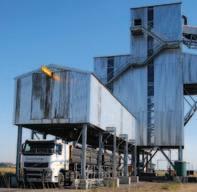

ENGINEERING & EQUIPMENT
Pictures 2 & 3: GAMBAROTTA GSCHWENDT ESPLV head stations equipped with double drive.
Picture 3.
Picture 5: ESPLV chains.
Specialists in Bulk Materials Handling, Niche Process Plants, and Conveyor and Stockyard Design Servicing the Power Generation, Mining, Metallurgical, Cement, Manufacturing and Port Handling Industries Strong reference list in Africa, SE Asia and South America, and in India, having partnered with M/s METHODS India From Concept Design to Project Completion
Picture 4: ESPLV wheels.
Leading
info@DemcoTECH.com www.DemcoTECH.com Engineering Excellence
Hot clinker transfer point design:engineered for workplace safety
For thousands of years, cement production has heated the constituents used in the mix to the highest temperatures possible to remove impurities, writes Byron Allen, Service Technician/Martin Engineering. Today, meal or raw material for Portland cement is calcined in a ~2000°F (~1,000°C) degree kiln, akin to dropping it into the centre of an active volcano. Although the material is run through a cooling process afterward, the light friable aggregate is still hot enough to burn through regular conveyor belting, high heat personal protective equipment (PPE), or pretty much anything else it encounters.
The presence of hot material has long made safety a priority for cement plant operators. However, regardless of the safety measures protecting individual workers, mitigating buildup and spillage in the hottest parts of the production process to avoid clogging and downtime is largely considered the least desirable job in the entire plant.
Safety personnel at a cement plant in
Texas raised attention to a transfer point leading from the cooling process to the tripper conveyor in the clinker barn. The transfer point struggled with excessive spillage of hot material and posed a potential risk to workers.
TEXAS CEMENT PLANT

“The transfer point in the clinker barn was an issue we’d been trying to address for a while,” said a source close to the project. “Our goal was to reduce the amount of maintenance needed for repairs and cleanup in the area. Unscheduled downtime, increased labour and product loss were raising the cost of operation. By making the system more efficient, we would also improve safety around the transfer point.”
FROM KILN TO STORAGE
Processing approximately 200tph (imperial tons per hour) [181.4 metric tph] of raw meal, when the molten clinker rolls out of the kiln, it is loaded onto a pan conveyor
consisting of several high heat metal pans pulled by a chain. Cold air cools the cargo quickly, reducing it from nearly 1,400°F (760°C) degrees to a temperature range of between 350 800°F (176 426°C).
Once the clinker is cooled, it’s dropped through a 5ft (1.5m)-long sloped chute onto a high-heat belt attached to a tripper conveyor that is suspended 80ft above the massive piles along the length of the airplane hangar-sized clinker barn. With a length of 1,100ft (335m) and a width of 24 inches (610mm), the belt conveys material at 260ft/m (1.32m/s) toward the tripper discharge chute.
Moving slowly back and forth along the entire length of the barn, the tracked tripper system discharges chalky clinker through a chute onto tall piles for storage. However, the stored material does not stay long, being constantly moved by front loaders to different sections of the plant as needed.
“This is a 24-hour operation to meet the demand of our customers,” said the source. “When there’s a problem with the clinker tripper conveyor, it needs to be addressed right away or it could hamper production.”

FEELING THE HEAT
Several issues contributed to safety concerns. The original transfer point from the pan conveyor to the tripper had some problems with sealing. Hot fines would spill out the sides and collect on the walkway around it. In addition, backups in the transfer chute often stopped production until they could be cleared.
Access was also a challenge. The outdoor staircase goes up eight storeys to an operations platform, which can be a daunting climb, especially in the Texas
ENGINEERING & EQUIPMENT 70 NOVEMBER 2022 DCi www.drycargomag.com
Texas cement plant.
The original transfer point had serious spillage issues (© 2022 Martin Engineering).

summer. Once staff has reached the transfer point, the temperature rises due to the clinker. Manually clearing the transfer chute carries the possibility of direct contact with the hot material, so it’s important that a trained employee with an air lance or CO2 blasting device perform the cleaning while wearing high-heat PPE.
To capture some of the spillage, there was a 3x5ft (0.9 by 1.5m) grated shaft installed on the platform under the transfer point. It leads down a chute and adds the product to the storage pile below. This was intended to mitigate worker contact with the material and shore up some production losses associated with the spillage. However, excessive fugitive material still piled around the platform, creating a potential hazard that needed to be removed often.

Even scheduled maintenance imposed both safety and cost concerns. Contractors were brought in approximately twice per month to clean the area. A crew of four to five workers with a vacuum truck would remove the debris. This cost the plant as much as US$15k to $20k per month, depending on the scope of the job and the number of times the crew needed to come in.
The large hole and the warped grate indicate the extreme heat emitted by the system.
EQUIPMENT STRUGGLES
The punishing environment of this transfer point had a profound effect on the equipment. Idlers would regularly seize or break due to warping from the heat, the weight of the cargo, or fines getting into rolling components such as bearings. The belt would also wear quickly, forming holes or even breaking at the splice.
When an idler seizes, it causes friction and excessive heat on the return side (bottom) of the belt. Friction can cause the belt to quickly degrade and fray at the edges. If left unnoticed long enough, it can erode mechanical splice attachments,
Poor belt support allowed fugitive material to collect on idlers, causing premature failure (© 2022 Martin Engineering)
causing the splice to break. Although the belt might be high heat graded on the cargo side, the return side is likely more vulnerable, which can potentially lead to fires.
The impact idlers were of particular concern, because they were the most likely to freeze from impact damage and warping due to constant heat exposure. The gaps between idlers would often allow dents and cracks to form on the protected side of the belt. These damaged spots would succumb to the heat and quickly become holes. Due to the high cost of belt replacement, operators would leave the holes, adding to

ENGINEERING & EQUIPMENT 72 NOVEMBER 2022 DCi www.drycargomag.com

the spillage until it became unmanageable.
The belt seal in the loading and settling zones was an issue that contributed to spillage, as well. Wear liners along the chute wall were not adequate for handling the high heat environment and would warp or tear, creating escape points for fines. The skirting would wear quickly and leave large gaps between idlers where the belt would sag, allowing more fugitive material to escape.
ONE SIZE DOES NOT FIT ALL
Managers did not immediately approach Martin Engineering, instead choosing what, on the surface, seemed like a logical solution. The company installed a prefabricated interlocking tube system that offered a sealed environment with good access for maintenance and idler replacement. Unfortunately, the system’s construction materials were unable to endure the punishing environment and the demands of the application. This caused excessive spillage, unscheduled downtime, product loss and a higher cost of operation. Due to failures and serious concerns over fires and safety, the tube system required premature replacement.
Having a long-time relationship, several service contracts and many successful projects throughout the plant, Martin Engineering was brought in to inspect the
Wear liner, skirting and apron seal.
transfer point and offer solutions. Trained technicians who were familiar with the issues in the clinker barn executed a Walk the Belt™ procedure that allowed them to complete a full checklist and identify issues throughout the transfer process.
Technicians proposed a fully modular heavy-duty Total Transfer Point Solution™ that would be better suited for the application. This included raising and shortening the transfer point enclosure, drastically improving the seal, adding belt
support and controlling airflow through the settling zone.
“We liked the plan and the fact it could be done in only a few days during scheduled downtime,” the source continued. “Martin equipment in other parts of the plant had held up well, so we trusted that they would be able to offer a long-term solution.”
HIGH FLYING INSTALLATION
Using a crane to lift the components to the high work platform, five contractors and a Martin Engineering supervisor were able to dismantle the old system, install the new components and clean up the area in fewer than four days. This quick turnaround allowed improved testing of the system prior to the end of downtime.
The team installed a new enclosure with an impact cradle, external wear liner, apron seal skirting, track-mounted idlers, support cradles and dust curtains. These components work together as a total solution to improve belt loading, reduce spillage and dust, and minimize impact damage to the belt.

The previous enclosure was 20ft (6m) long. The idea is to give cargo and dust as much time to settle in a sealed environment as possible. To accomplish roughly the same goal in a shorter length, Martin Engineering technicians raised the height of the enclosure slightly and reduced the length to 12ft (3.6m).
The impact cradle eases the cargo’s collision with the belt, reducing the chances of serious belt damage. The unit features troughed low-friction UMHW bars that support belt edges and stabilize the belt line. This eliminates belt sag and bounce associated with impact idlers and minimizes the need to replace broken rolling

ENGINEERING & EQUIPMENT 74 NOVEMBER 2022 DCi www.drycargomag.com
Integrated modular components work together for maximum performance.



Dust curtains at the front and back of the chute keep emissions down.
components that can increase friction on the belt. The ‘box’ design allows each bar to be turned over to provide a second wear life.
When loaded at a high speed, hot material hitting the enclosure wall can quickly erode the metal and create holes where spillage can escape. The external wear liner adds an extra layer of protection and can be replaced from outside the chute. Previous designs required confined space entry by a certified worker to remove the liner using a blow torch. Now it can be done safely with simple tools from outside the enclosure.
Accompanying the wear liner on the outside of the enclosure is the apron seal skirting. This innovative dual sealing system made from EPDM (ethylene propylene diene monomer) 70 durometer rubber composite prevents spillage by maintaining an effective dust barrier. The primary seal is clamped to the chute wall, with a selfadjusting secondary flap laying outward for extra protection.
Following the tail pulley leading into the impact cradle are track-mounted idlers, which also support the belt in between cradles. Idler replacement is easy, since the units slide out from the stringer for external maintenance. Preventing belt sag is key to creating a tight seal and controlling spillage. Well-placed idlers between cradles help retain a smooth belt path throughout the loading and settling zones.
Two slider cradles smoothly direct the cargo through the settling zone, helping center the material. A similar concept to impact cradles, these feature wider troughed bars that prevent the bumping and jostling associated with idlers. Placed sequentially with track-mounted idlers in
between, they promote a tight seal with the skirting to prevent spillage.
Dust curtains at both ends of the chute control the turbulent airflow created by the loading process, minimizing the escape of fugitive material at either end of the chute. By controlling airflow, material settles faster on the belt and more product is retained.

SUSTAINABLE RESULTS
Nearly a year following installation, operators report improved efficiency and a drastic reduction in spillage. “Clinker is dusty stuff being dropped into open piles, so completely preventing dust from collecting anywhere in the clinker barn was virtually impossible,” said the source. “However, material piling on the walkway has been drastically reduced, and there’s less dust in the immediate area, so this project made working around the transfer point much safer.”
Belt damage such as holes and splice detachment have not been a problem since installation, reducing the cost of operation significantly since the belting is the most expensive and time-consuming component to replace. The enclosure has remained intact and sealed, continuing to control spillage. Removing most of the idlers from the entire transfer point reduced the chance of roller seizure and friction damage on the return side of the belt.
“We no longer need the crew with the vacuum truck, so that has definitely cut down on man hours and the significant expense for maintenance and cleaning,” the source concluded.
“Overall, we’re happy with the results. The Martin equipment has made the area safer and more productive.”
ABOUT BYRON ALLEN, TERRITORY MANAGER , MARTIN ENGINEERING
Byron Allen is the Martin Engineering Territory Manager in Texas, specializing in air cannons, transfer points and conveyor belt cleaning, primarily serving customers in the cement industry. He has been instrumental in training service technicians and managing the company’s Mr. Blade programme in the region, helping customers optimize belt cleaner performance and longevity. Byron’s work experience includes ironworking and boiler construction, failure analysis, preventive maintenance and reliability engineering.
ABOUT MARTIN ENGINEERING
Martin Engineering has been a global innovator in the bulk material handling industry for more than 75 years, developing new solutions to common problems and participating in industry organizations to improve safety and productivity. The company’s series of Foundations books is an internationally recognized resource for safety, maintenance and operations training — with more than 22,000 print copies in circulation around the world. The 500+ page reference books are available in several languages and have been downloaded thousands of times as free PDFs from the Martin website. Martin Engineering products, sales, service and training are available from 17 factoryowned facilities worldwide, with whollyowned business units in Australia, Brazil, China, Colombia, France, Germany, India, Indonesia, Italy, Mexico, Peru, Spain, South Africa, Turkey, the USA and UK. The firm employs more than 1,000 people, approximately 400 of whom hold advanced degrees.
ENGINEERING & EQUIPMENT 76 NOVEMBER 2022 DCi www.drycargomag.com
SRON company provides customers with high-quality bulk materials storage and transportation system solutions

Henan SRON Silo Engineering Co., Ltd. is a leading and reputable EPC Contractor in China — article written by Wang Leipeng and Wen Peng. The company provides safe and reliable and technically advanced steel silo project system, closed material yard systems, terminal bulk material loading and unloading systems and other bulk materials storage and transportation complete equipment systems solutions and EPC contracting services for bulk materials storage and transportation field.
SRON is engaged in equipment research and development, manufacturing, system process design, general contracting, technical transformation and after-sales service of the following sections, as well as import and export business of related equipment.
ADVANCED BULK MATERIAL STORAGE AND TRANSPORTATION SYSTEM
RAW MATERIAL HOMOGENIZATION SILO SYSTEM
The raw material homogenization silo system includes silo, bucket elevator, air chute, silo roof raw material distributor, dust collector, silo bottom aerated
fluidization system, buffer bin, solid flow meter and other equipment.
The homogenizing mechanism of raw material homogenization silo is that feed material through the silo roof raw material distributor, so that raw material in the silo at different periods is transverse distribution; through the silo bottom annular fluidization aeration system, the silo is aerated every five minutes. Raw material is vertically cut by air flow and feed into silo
to achieve homogenization; after raw material entering into the mixing silo, mix and homogenize it again so as to achieve the ideal homogenization.
CEMENT SILO SYSTEM
Cement storage system includes steel silo, bucket elevator, air chute, dust collector, silo bottom aerated fluidization system, silo bottom discharging device, bulk loading machine, tonne bag packaging machine,

ENGINEERING & EQUIPMENT 77 NOVEMBER 2022 DCi www.drycargomag.com
SRON special cement homogenization system for POSCO.
SRON 4* 10,000-tonne cement storage system.
pneumatic conveying system, complete sets of equipment for cement packaging line, etc.
SRON can provide welded steel silo, spiral silo, bolted steel silo and other types of steel silos, of which the reserve is100 50,000 tonnes. According to the specific situation of customers’ projects, SRON’s experienced engineer team will provide professional solutions. SRON’s

cement silo system has the characteristics of high unloading rate, long service life, high reliability, almost no maintenance and repair work, low energy consumption, automatic control and so on.
CLINKER SILO SYSTEM
The clinker silo system includes steel silo, belt conveyor (chain bucket conveyor), bucket elevator, dust collector, silo bottom
discharge valve and other equipment.
LARGE CLOSED MATERIAL YARD AND STACKING AND RECLAIMING SYSTEM
SRON can provide large closed material sheds and stacking and reclaiming systems to achieve the purpose of prehomogenization of raw materials in the production of cement plants. According to the different situations of customers’

& EQUIPMENT 78 NOVEMBER 2022 DCi www.drycargomag.com
ENGINEERING
SRON 6*10,000 tonne clinker storage system.
SRON pre-homogenization stockyard system for cement plant.
projects, the structure of the material shed is arched or ball shell shaped grid, and the material shed has advantages of a large span (50m~120m), high degree of factory, high degree of factory components (80%), fast installation, short construction period, low cost, wind and snow resistance, good antiseismic performance, high stiffness, and high structural safety.
SRON can configure various types of stacking and reclaiming equipment according to the customer’s project requirements.

WHARF TRANSIT SYSTEM
The wharf transit system from SRON mainly transfers bulk materials from silos to the wharf for loading, or transfers bulk materials from bulk carriers to silos for storage after ship-unloading. The wharf transit system includes silos, shiploading (unloading) machines, air chutes, belt conveyors, bucket elevators,
dust collectors, and so forth.
MAIN CUSTOMERS
SRON provides systems engineering and services for building materials, metallurgy, mines, terminals and other enterprises. Through years of unremitting efforts, the company is the supplier of Sinoma, Lafarge, Loesche GmbH, San Miguel Corporation, POSCO and other well-known group enterprises at home and abroad. These include: San Miguel Corporation; SIG; Lafarge; CUCC; Primecement; Posco; CHD; Loesche; Baowu; and SECMC.
TECHNOLOGICAL INNOVATION AND PROGRESS
Automation and intelligence: with the development of society, the distributed control system of centralized management has been widely used in the cement industry in the world. By using this system, the motor group programme control,

process quantity collection, processing, display and regulation can be realized. SRON continues to explore unattended production, and through remote instrumentation, monitoring and other means to reduce staffing, enhance plant management level, and improve labour productivity.
SRON organizes and utilizes domestic and foreign technical and intellectual resources, carries out a wide range of international technical exchanges and cooperation in various forms, constantly develops and innovates, and has established long-term and stable co operative relations with universities, research institutes and peer enterprises.
The company collects and analyses relevant global technology and market information, studies industry development trends, and provides advice and suggestions for product and technology development decisions.
DCi
ENGINEERING & EQUIPMENT 79 NOVEMBER 2022 DCi www.drycargomag.com
Growing fertilizer market...
...needs careful handling
The fertilizer market (which includes a wide variety of material like urea ammonium nitrate, MAP, DAP, MOP, and sulphur based), is facing exponential growth due to the growing population and continuous demand for food.
The Covid-19 outbreak has affected several sectors in the handling industry. During the initial lockdown period, the fertilizer industry also experienced a significant downtime. However, in the past year and a half, production and demands have increased, and the fertilizer market has stabilized.
For years, due to its outstanding experience and know-how with every type of fertilizer, Bedeschi has continued to be a reference in the market offering turnkey solutions for every need.
The challenge in handling fertilizer is that this type of material is corrosive, generates dust, breaks easily and is hygroscopic (absorbs water easily). To overcome these difficulties, when handling fertilizer, Bedeschi always takes into consideration different measures to preserve the material. When it comes to the machine, since fertilizer is highly
cargoes
corrosive, the company tends to use, as much as possible, materials that cannot be attacked, like stainless steel, plastic components made of glass-reinforced plastic (GRP), or high-durability painting for structural parts.
Fertilizer breaks easily, so it is essential to meet the highest environmental standards and to guarantee the gentle treatment of the material. Bedeschi has dedicated special attention to, and has carried out in-depth studies to loading chutes — for example, the controlled flow chute to allow vessel loading, keeping the

ENGINEERING & EQUIPMENT 80 NOVEMBER 2022 DCi www.drycargomag.com
Bedeschi’s expertise makes short work of corrosive
Bedeschi 2,400tph reclaimer for fertilizer installed in Jorf Lasfar plant, Morocco
Our bespoke solutions are designed to meet each customer’s specific requirements from a tool kit of proven components, utilising the expertise of a team of specialist in house design engineers.



We lead the loading chute industry & set the standard for dust emissions and environmental pollution control in dry bulk handling.





Our worldwide reputation is built on high quality, well-engineered, robust, high performance chutes, backed up by excellent customer service and global lifetime product support.






Contact Cleveland Cascades Ltd Unit 22, Dukesway, Teesside Industrial Estate, Thornaby, Stockton-on-Tees, Cleveland, TS17 9LT, United Kingdom Tel: +44 1642 753260 | Fax: +44 1642 753270 E-mail: enquiries@clevelandcascades.co.uk | Website: www.clevelandcascades.co.uk
Cleveland Cascades Ltd Global leader in bespoke dry bulk loading chutes
Cleveland Cascades are Specialists in the design and manufacture of bespoke dry bulk loading chutes.
Ship Loaders
Loaders Truck Loaders
Loaders
Silo
Tanker
1,000tph
speed below acceptable values and limiting the dropping height to avoid degradation in cargo quality. In addition, to avoid dust that is generated while handling the material, not only is the choice of the chute extremely important, but also the belt speed according to the handled cargo, the use of pipe conveyor and enclosed conveyor and suppression system for dust control.
As is well known, fertilizers are hygroscopic materials, so protecting them from water or rain is extremely important. For this reason, when handling fertilizers, Bedeschi always uses enclosed or pipe conveyors.
Thanks to the achievements of its R&D department, particularly focused on green technologies, Bedeschi is able to design state-of-the-art systems and environmentally friendly solutions to meet clients’ needs.
Long-term collaborations with giants like YARA and OCP prove the quality of Bedeschi equipment. Here are some solutions supplied by Bedeschi in the fertilizer sector:

BARATA — INDONESIA :
The supply is for a SHL 25/1400 shiploader which is now operating on the Demarga Jetty (Gresik, Indonesia) to load fertilizers (NPK, NPS) at a capacity of 1,000tph (tonnes per hour) on vessels up to 30,000dwt.
The order has been finalized with Barata Indonesia, an Indonesian engineering company that took care of the civil works. The end user is PT. Petrokimia Gresik, which had already chosen Bedeschi for a circular and a longitudinal storage with PAL PD built on the same site over the last five years.
YARA SLUISKIL — HOLLAND
For its client YARA, Bedeschi manufactured an SHL 28/1200 shiploader for urea with a loading capacity of 600tph, for YARA’s terminal in Holland.
The shiploader was recently delivered by the Matador 3 (floating sheerleg), from Mammoet’s quay to Yara’s quay.
The shiploader is now installed in YARA’s dock and is in operation; the most significant technological innovation of the
whole project is the ‘sandwich conveyor’ placed on the main gantry to overcome the limits of the incline required to connect the feeding point at the jetty gallery level to the shiploader boom.
‘Sandwich conveyor’ refers to two belts placed one on the top of the other in order to gently convey the material inside an enclosed channel. The pros of said application are clear: first of all, the possibility of overcoming remarkable
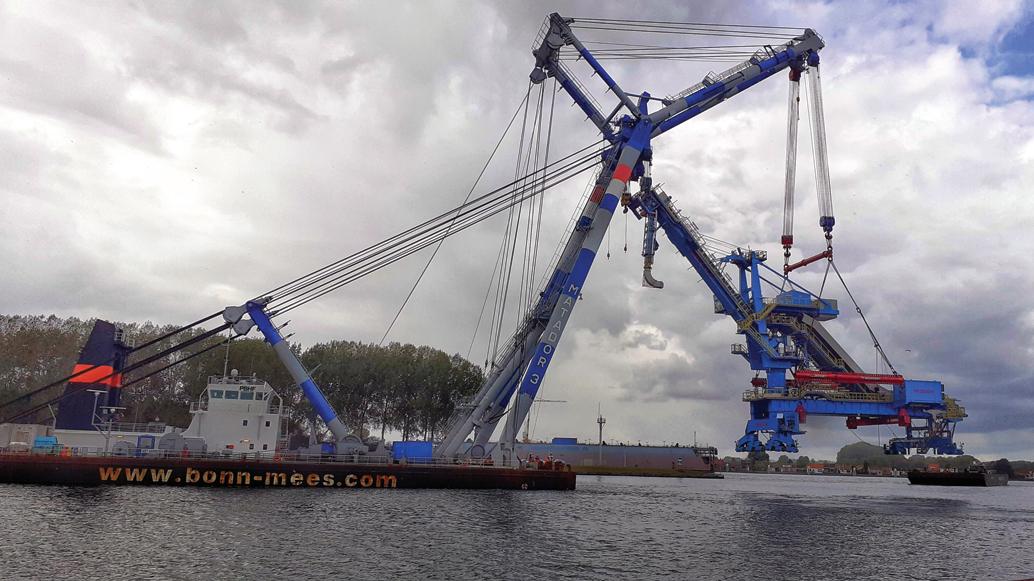
ENGINEERING & EQUIPMENT 82 NOVEMBER 2022 DCi www.drycargomag.com
Bedeschi shiploader for fertilizer installed in Indonesia.
Bedeschi shiploader during transportation
slopes in reduced length, avoiding the problem caused by the maximum incline angle granted by conventional conveyors; Unquestionable advant ages concerning the environmental safety due to the fact that the material is completely enclosed between the two belt loops and so, the spillage or the emission of dust in the air is unlikely to happen.
Bedeschi has long-term co operation with YARA. It has previously supplied one 250tph shiploader for urea, which is in operation in France, a 500tph shiploader to handle various types of fertilizer operating in Italy, and one 500tph shiploader for urea operating in Germany.

OCP – MAROC
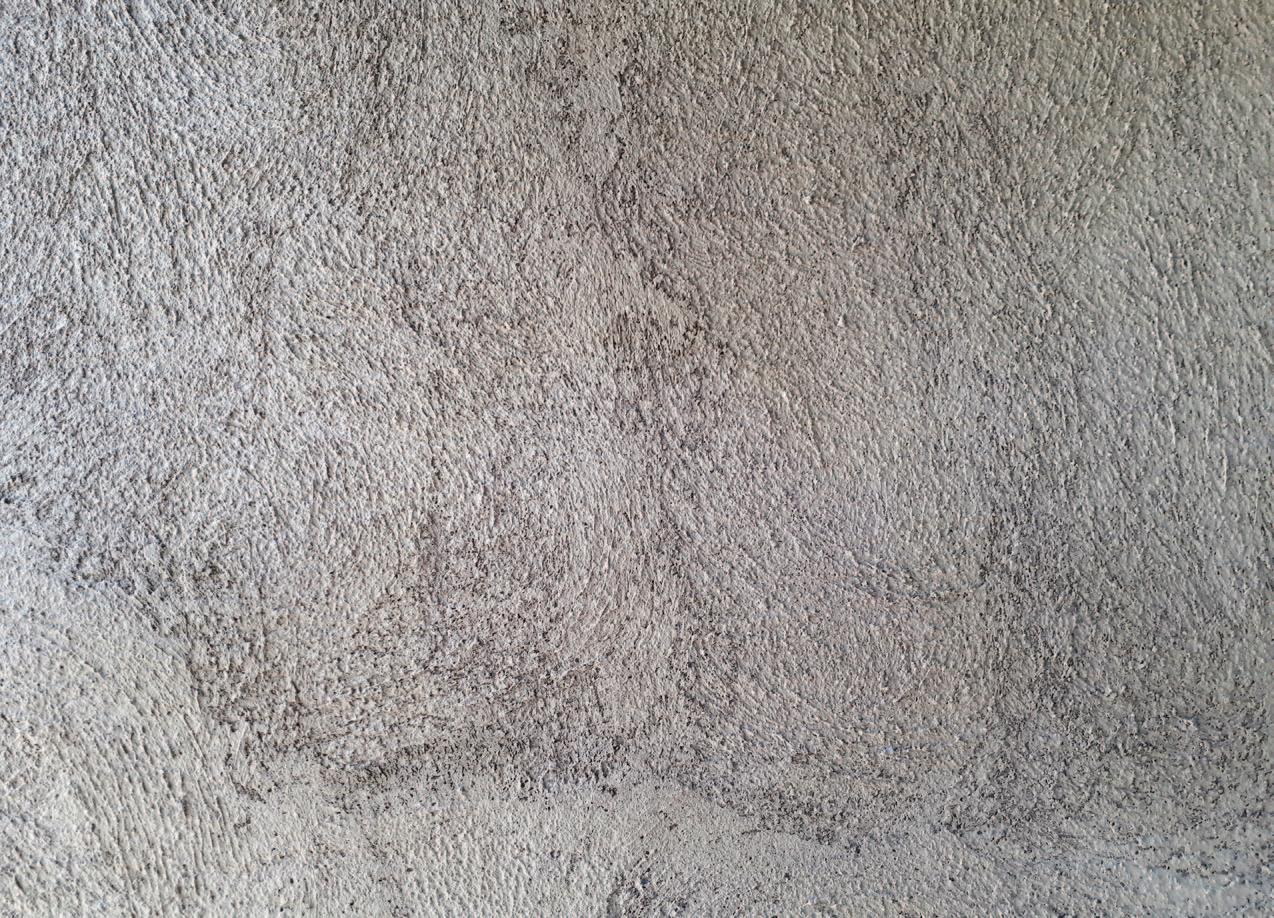
OCP, a world leader in phosphates, has chosen Bedeschi once again as material handling partner for a new project: the Office Cherifién des Phosphates has
decided to rely on Bedeschi’s know-how for the EPC supply of three new automated storages: two for fertilizer and one for sulphur, for a global storage capacity of 300,000 tonnes of material.
The new equipment will be installed in the chemical complex of Phosboucraa, 30km from the city of Laayoune, in the South of Morocco.
The new project has strategic importance for the development of the
industrial axis known as ‘southern axe’. The supply consists of material handling equipment for the storage of sulphur in import and the storage of fertilizer in export. In particular, the company will supply, among other things, three trippers, three reclaimers and six conveyor belts with capacity of up to 2,000tph.
The equipment will be similar to the one in the image, already supplied to OCP for the Jorf Lasfar plant in Morocco.

ENGINEERING & EQUIPMENT
Bedeschi 600tph shiploader for urea installed in Holland.
Bulk Storage Inc. offers customized fertilizer storage solutions
For over 30 years, Bulk Storage Inc. offers corrosion-resistant storage solutions for the bulk fertilizer industry. The company’s efficient building designs offer a storage dome that uses less square footage, saving working space and money. Its pre manufactured building components can be shipped worldwide and perform in the harshest of conditions.
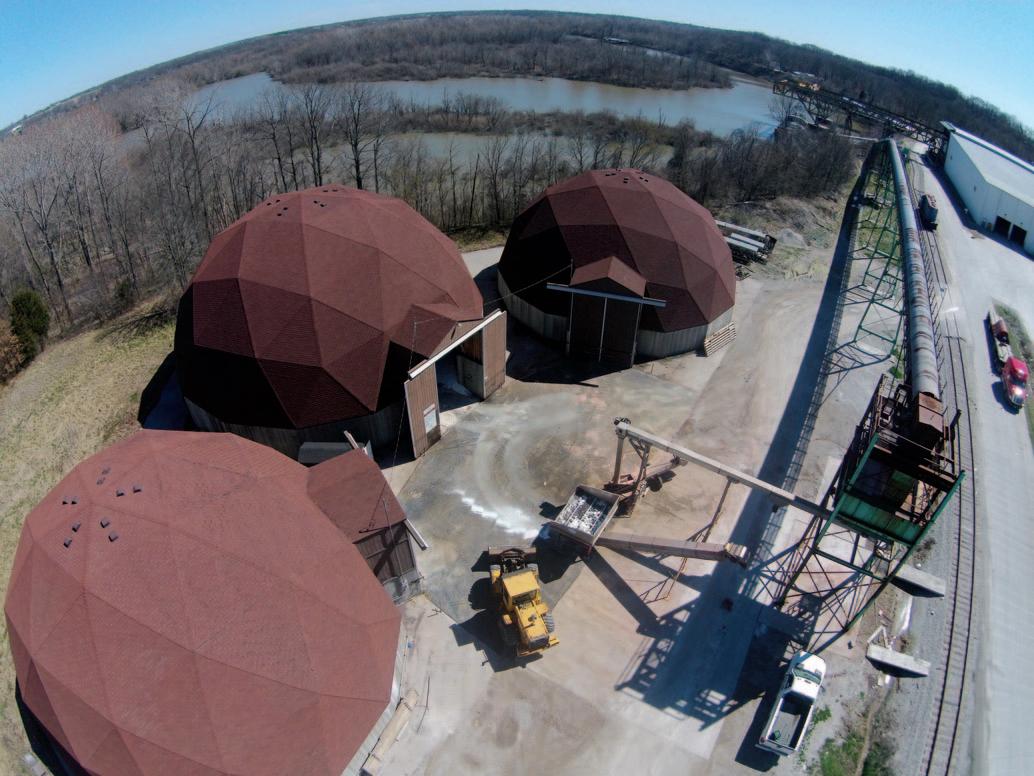
Customers looking to store single or multiple products can find a solution with Bulk Storage’s buildings, which can be sized to store +100,000 tonnes of dry bulk fertilizer. The buildings are also customiz able with conveyor loading and unloading.
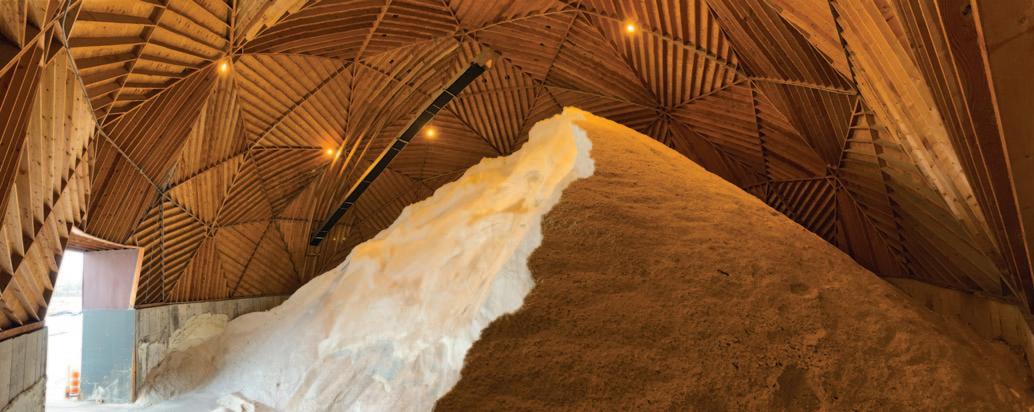
Bulk Storage Inc, also offers full inspection and repair services on dry
fertilizer storage systems worldwide.
THE ADVANTAGE OF BULK STORAGE INC .’S STORAGE FACILITIES
Most modern farms use fertilizer to condition the soil. Storing that fertilizer requires specialty equipment and structures; dry fertilizers tend to coat everything in a cloud of fine dust that can be corrosive. For this reason, Bulk Storage Inc. ensures that its buildings are engineered and constructed with the best materials to withstand the corrosive properties in the chemicals needed for crop nutrition fertilizers. Bulk Storage Inc’s staff dedicates itself to getting buildings up and ready for storing fertilizers as quickly
as possible. Its buildings are generally prepared for full-service operation in a few weeks with the company’s turn-key design and construction services.
NO JOB TOO BIG OR TOO SMALL Bulk Storage Inc. can custom-design and construct exactly the right building for the customer — whether storing 500 tonnes or 100,000 tonnes of fertilizer. Employees at Bulk Storage Inc., dedicate themselves to the clients and their needs. No matter the size of the job, the company is confident that all its customers’ storage needs can be met. In most cases, our bids can be prepared, advertised, and received in fewer than 30 days.
ENGINEERING & EQUIPMENT 84 NOVEMBER 2022 DCi www.drycargomag.com
BUILDINGS TO FIT THE CUSTOMER’S NEEDS
Bulk Storage Inc. prides itself on well-built, long-lasting structures for all bulk storage needs. Its geodesic domes are built to last, and its in-house design and construction team can meet any building code. It provides all custom-sealed blueprints, specifications, site reviews, and construction materials.
Geodesic domes are an ideal solution for fertilizer storing needs. With its round structure, customers can keep the maximum amount of fertilizer in a minimal amount of space.
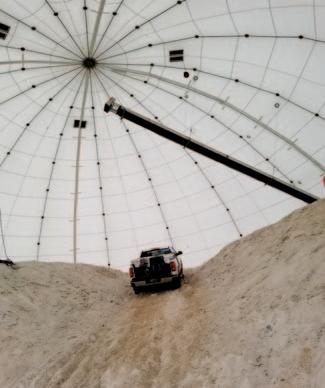
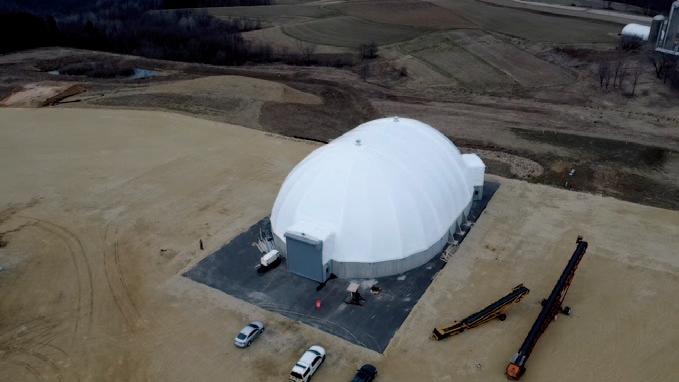
Bulk Storage’s smallest design has a centre point of 25 feet with large entrance doors and canopies, making unloading and loading easy and efficient. These buildings are engineered and designed to be resistant to fertilizer’s highly corrosive
properties. Long-lasting materials are used ensure that the customer’s investment stays protected.
Aesthetics are very important in urban areas, and Bulk Storage kept that in mind with its design. Its designs help the domes to look smaller than they are from the outside with gently sloping roofs and a low profile look that blends in with the environment.
TENSIONED FABRIC FERTILIZER DOMES
Bulk Storage Inc. is here to help ensure its customers get the storage solution they need while staying on budget. Its highquality fabric domes are a one-of-a-kind solution that combines the efficiency of a wood-framed dome with the cost savings of a tensioned fabric structure. The company’s in-house mobile construction crew can get the tensioned fabric dome
installed much quicker than an ordinary fabric shed, and its circular design is ideal for maximum storage. These structures come with hot-dip galvanized steel trusses and a 15-year prorated fabric warranty, allowing for a cost-effective and efficient fertilizer storage structure that will last for years.
STORAGE BARNS
The same high-level craftsmanship is evident when looking into Bulk Storage Inc.’s storage barns. From its New England fertilizer barns to its tensioned fabric fertilizer barns Bulk Storage Inc. takes a level of pride in its work that results in the best product possible.
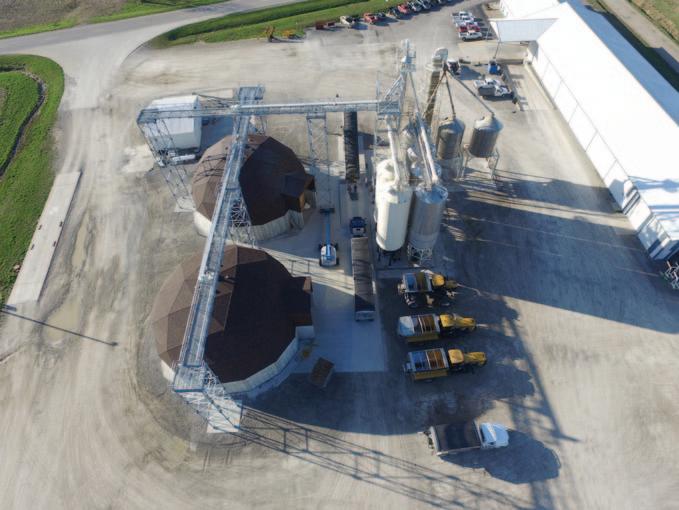
New England wing fertilizer barns have a centre aisle of 30 feet for easy inside loading and dumping. The STOREMORE, New England Wing Truss structure is an adaptable, solid wood construction that complements any roofing material making it blend in more easily with its surroundings. It’s easily expandable with wraparound sheltered storage areas. The permanent base wall makes it easy to add covered storage on any side of the building for vehicles and other equipment.
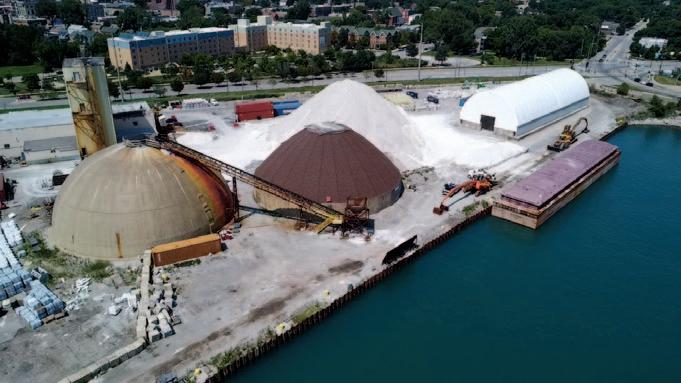
ENGINEERING & EQUIPMENT 85 NOVEMBER 2022 DCi www.drycargomag.com
Replacing non-biodegradable ingredients in fertilizers
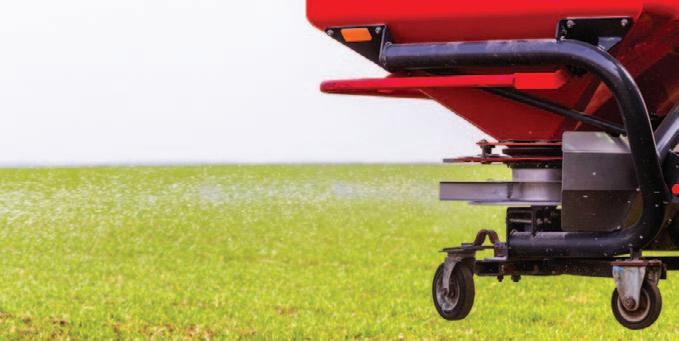
With a proven track record in fertilizer additives, the Dutch company Instral B.V. took on the challenge to develop bio-based alternatives. After thorough research and testing, Instral developed bio-based fertilizer additives that help to improve binding, granulation and/or prilling of fertilizers which is crucial in the shift towards replacing non-biodegradable ingredients.
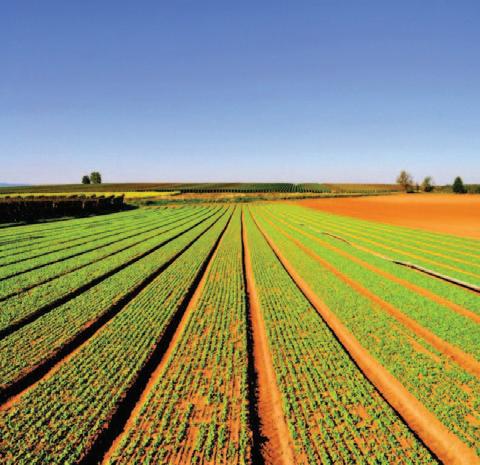
Fertilizers possess extraordinary physical properties that may cause problems during production, handling, application chain, storage and transportation, like caking, moisture uptake or dusting. Coatings can prevent such problems, but often consist of petroleum-derived polymers and waxes with little or no biodegradability. Globally, governments are striving to ensure that no more non-biodegradable plastics enter the environment. Within the EU, the Biostimulant and Fertilizing products regulation (EC) 2019/1009 came into force on 16 July 2022, prohibiting the use of nonbiodegradable ingredients in agrochemicals. This forces fertilizer manufacturers to look for bio-based alternatives.
IMPROVING BINDING AND GRANULATION
The bio-based coatings currently on the market are all less effective in preventing caking and taking up water than their petroleum-derived counterparts. This means either dealing with the massive lumping occurring in a stack of fertilizer granule or using massive amounts of coating material.
Instral decided to take a step back and look at the granulation process as well. The company found ways to improve the
manufacturing process using bio-based additives. As a result, the granules produced are of such quality that coatings are hardly necessary or that the less effective bio-based coatings suffice.
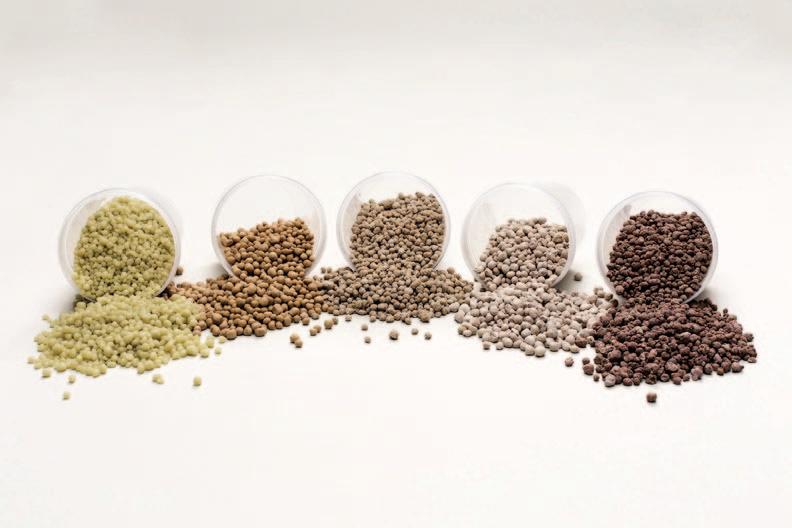
BIO BASED PRILLING
In the search for biobased solutions, Instral did not stop at the more prevalent types of fertilizers like NPK’s. It also looked into improving the prilling of urea. This process requires the harmful substance formaldehyde to improve the crushing strength of the urea prills. With testing still under way, Instral believes it has found an effective bio-based additive that could put an end to the use of the toxic
formaldehyde in the prilling of urea. The proposed additive improves the crushing strength of prills. lowers the dust content and lowers caking tendency.
TAILOR-MADE SOLUTION
As each type of fertilizer and each manufacturing process is different, Instral has no off-the-shell solutions for the industry. Nils Janbroers, director of Instral explains: “We help our customers find the exact tailormade recipe for the additive. We generally start out with testing six to eight formula’s on samples of the fertilizer. That usually brings the number of candidates down to two or three which we then optimize for the fertilizer at hand. After thorough testing in our lab, we help the manufacturer to implement the new additive to its test production site.”
ENGINEERING & EQUIPMENT 86 NOVEMBER 2022 DCi www.drycargomag.com
RHC Deutschland supplies fertilizer ship-unloader to Indonesian client
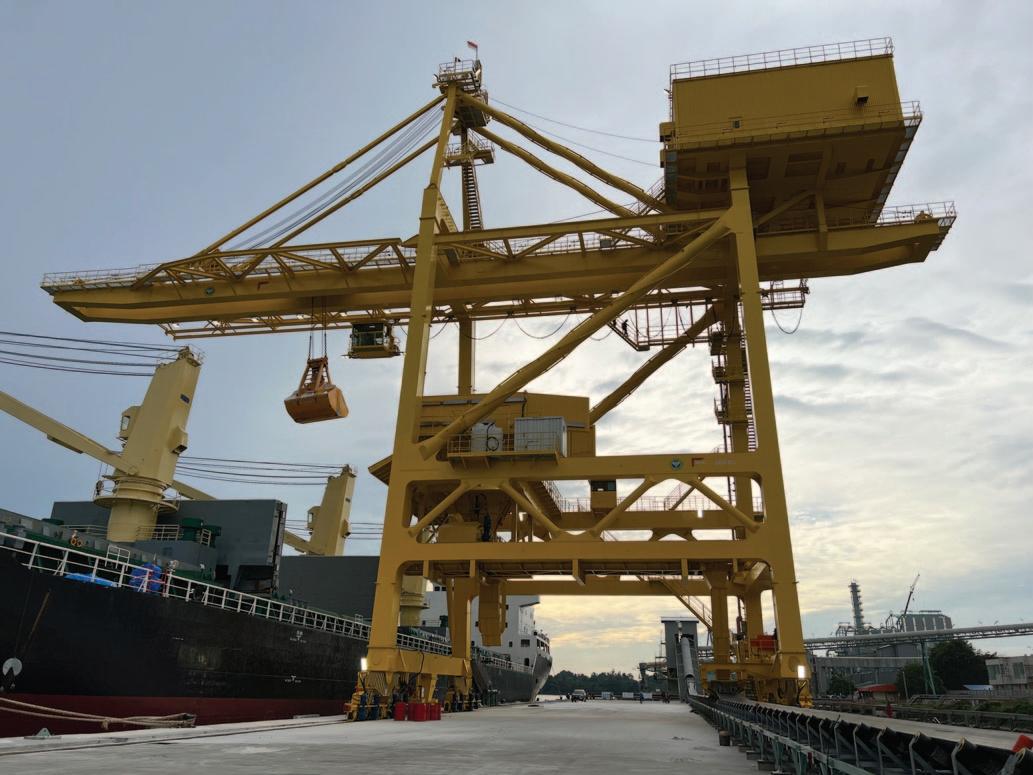
The world’s growing population inevitably has an increased need for food, creating demand for higher yields. This translates into a higher demand for artificial fertilizers. As part of the long-term planning of the renowned fertilizer manufacturer PT Pukuk Iskander Muda in Indonesia (a country with a rapidly growing population), production capacities have been massively expanded. The construction of a new quay for the unloading of ships up to a size of 40,000dwt and it was necessary to install a grab shipunloader to handle the fertilizer cargoes. In addition to other basic materials for the production of artificial fertilizers, urea — a very corrosive material — is also handled.
The contract for the ship-unloader went to RHC Deutschland GmbH, a Germanybased company with various production sites. In September/October 2022, the first ships were unloaded, and the ship-unloader and the downstream conveyor system were successfully put into operation. The sometimes very corrosive base materials made extensive use of stainless steel necessary on the contact surfaces. In order to reduce the formation of dust to a minimum, a dust suppression system developed in Germany is used.
TECHNICAL PARAMETERS OF THE SHIP-UNLOADER
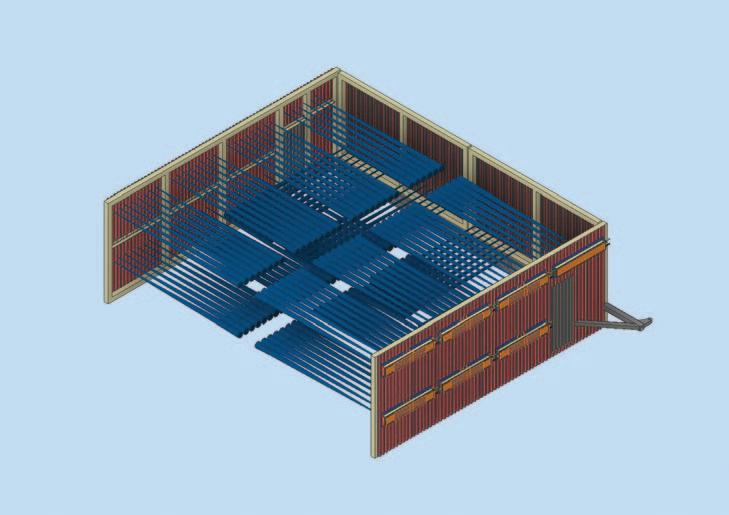
Rated capacity: 1,000tph
Max. capacity: 1,250tph — limited by the customer’s conveyor system Span: 22,000mm Outreach: 24,000 mm
Hoisting height: 20,000mm, below water 19,000mm
The dust-control system keeps emissions to an absolute minimum.
ENGINEERING & EQUIPMENT 87 NOVEMBER 2022 DCi www.drycargomag.com
The use of top-quality components with local after-sales service support was a matter of course and had the highest priority. The design and manufacture was carried out at the partner company under the full control of RHC.; as a result, the
commissioning and the unloading of the first ships went smoothly.
RHC is a highly specialized supplier of bespoke material handling systems used in port handling, metallurgy, power plants. However, the company’s expertise is not
limited to ship-unloading. RHC also supplies loading and storage systems (stackers/reclaimers) for iron ore, coal, scrap, etc. RHC delivers to international clients operating under a variety of operating parameters.
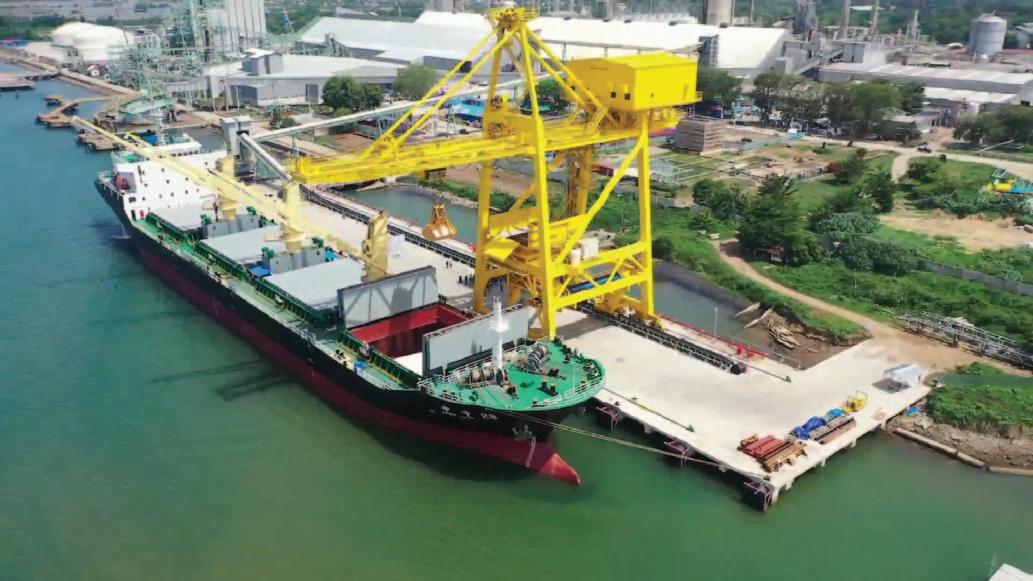
ENGINEERING & EQUIPMENT DC
i
“A man who stops advertising to save money is like a man who stops a clock to save time” To find out how you can benefit from advertising in the world’s only monthly dry bulk publication contact Andrew Hucker-Brown on: Tel: +27 31 583 4360; Email: info@dc-int.com DRY CARG O international DC i TM
– Henry Ford
Italian Equipment Manufacturers Italian Engineering
Rulmeca case history: CINTASA
Division: Bulk Sector: Mining, Coal, and Lignite
ABOUT RULMECA
Since 1962, Rulmeca Group has been a global partner in the material handling sector.
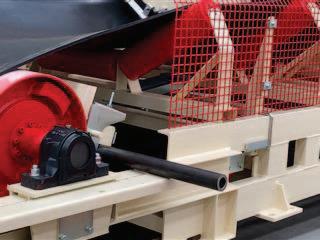
Over the years, it has been able to achieve a prominent role, at an international level, in the production of components and equipment for all types of conveyors, providing a highly qualified service based on specialized technical skills.
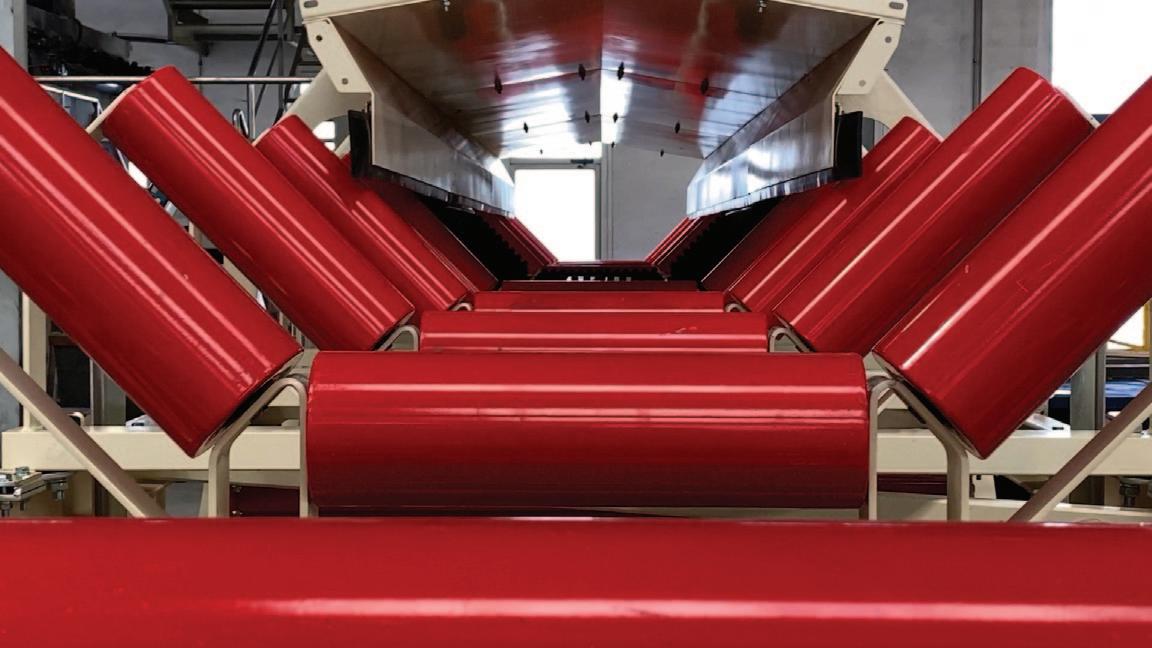
The worldwide activity today includes
the Rulmeca, Precismeca and Melco brands. Among its strengths: the financial solidity and long-term v vision of a family-run business;
Expertise
60 years of experience in the sector v offering products, services and consultancy of the highest quality; eight production companies, eight v sales companies and different local service centres to support customers, for a total of 1,200 employees around the world; significant investments in R&D, own v technologies and quality systems; the widest range of rollers and drum v motors of any other supplier; a global approach that wants to act v positively in support of local communities.
ENGINEERING & EQUIPMENT 89 NOVEMBER 2022 DCi www.drycargomag.com
Jay Venter
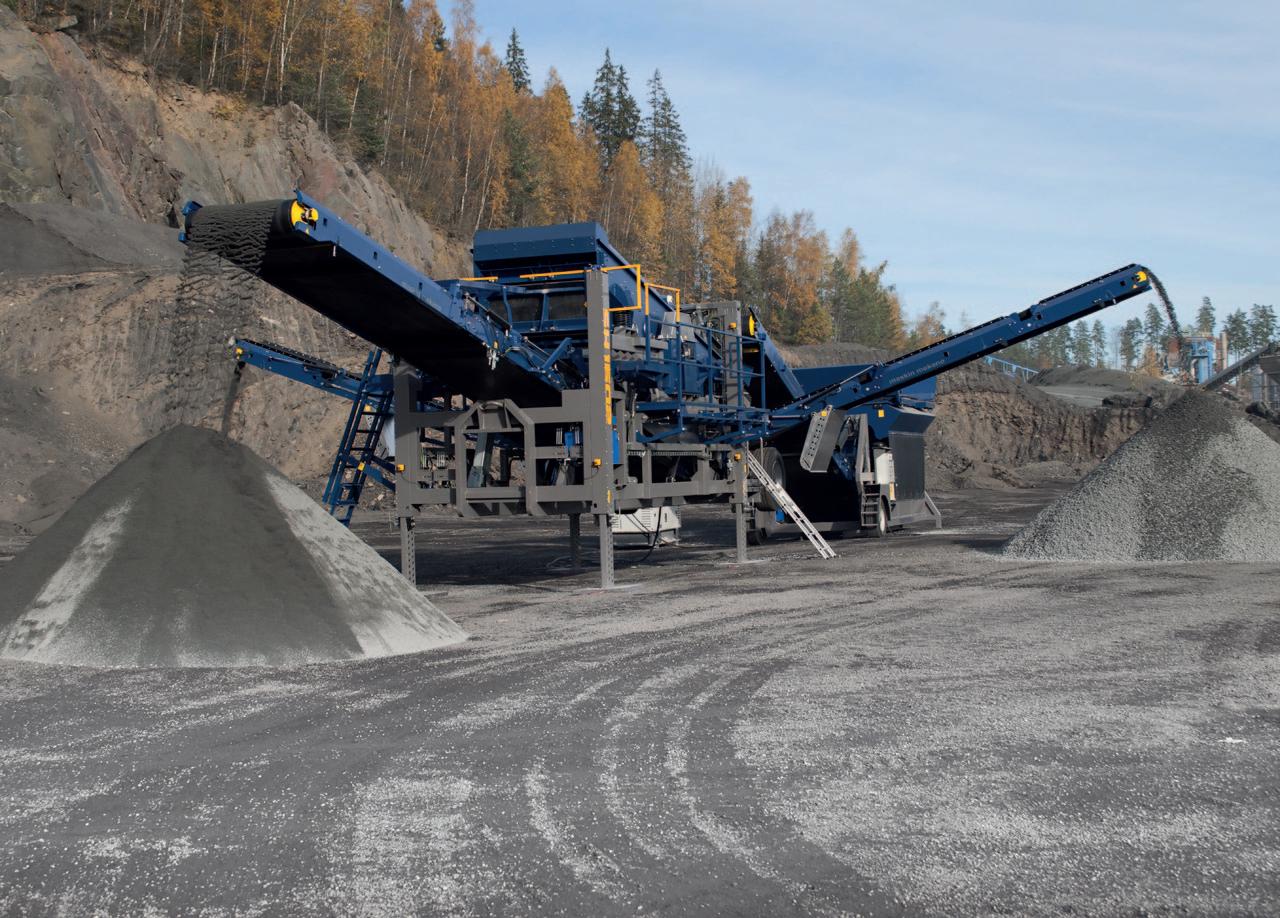

CINTASA , A PARTNERSHIP THAT LASTS OVER TIME
There is a long-term relationship between Rulmeca and the Spanish company Cintasa, which specializes in the design and production of conveyor belts and all its variants.
The companies share values and interests that go beyond the business and in which even the personal relationship is essential to be able to face all possible new projects with confidence. Great efforts have always been made to maintain fluid communication and mutual trust, both in terms of products and in the people who are part of the two companies.
Cintasa’s main activity is concentrated in the engineering, production and installation of systems for the handling, transport and storage of elements. Its wide range of conveyors is based on different systems such as belts, rollers, chains, metal plates, buckets, etc. Furthermore, the company incorporates distinct auxiliary elements in its installations, which could be: tunnels, silos, hoppers, structures, etc. This specialization in the sector has lasted for 50 years and has provided Cintasa with the experience necessary to be able to offer its customers (mechanics, cement factories, chemical sector, etc.) the best solution to every need.
Cintasa recognizes in Rulmeca the high quality of its products, the fast delivery times and the prices that are suitable for
the reference market.
RULMECA SOLUTIONS USED
Cintasa mainly consumes rollers of different types and sizes as its projects are custom designed:
PSV SERIES
This is a series of rollers that represent the highest quality and load capacity heavyduty conveyor rollers among Rulmeca’s components for bulk handling application. They are particularly suitable for conveyors that operate in very difficult conditions, where there are high workloads and material in large pieces is transported; at the same time, given their construction characteristics, they require reduced maintenance.

Typical fields of application are: mines, quarries, cement plants, coal-fired power plants and port installations.
The effectiveness of the sealing system of the PSV rollers makes them the ideal solution for environments where there is the presence of dust, dirt, water, with low or high temperatures or where there is a large difference in temperature between day and night.
The operating temperatures, with standard components and grease, are between 20°C and +100°C.
It is possible to reach temperatures outside this range by using special grease, bearings and seals.
MPS SERIES
The MPS series comprises particularly advantageous rollers also from an economic point of view, with rigid radial bearings. The roller is suitable for use on medium-capacity belt conveyors, even at high speeds and in outdoor environments, even if dirty. The operating temperatures with standard components and grease are between 20° C and +100° C. It is possible to reach temperatures outside this range by using special grease, bearings and seals.
IMPACT ROLLERS WITH RUBBERS RINGS
The shock absorbing rollers, more often known as ‘impact rollers’ consist of the basic steel PSV design, on which are fitted rings, designed to resist and absorb the pressure given by the impact of materials onto the belt.
These rollers are positioned in the carrying section of the belt, corresponding to the point of loading where the material falls onto it.
RETURNS ROLLERS WITH RUBBERS RINGS
The straight tracking of the belt may be compromised by the type of conveyed material, specially when this material is sticky and thereby adheres easily to the belt surface.
In this case, material is also deposited on the return rollers that support the belt, adding an irregular addition of scale to the
ENGINEERING & EQUIPMENT 91 NOVEMBER 2022 DCi www.drycargomag.com
roller itself.
As a consequence, not only wear and tear of the belt occurs, but forces are brought into play to move the belt away from its correct track.
Return rollers with spaced rubber rings contribute largely to eliminating the build up of scale that forms in certain conditions on the belt surface.
The rings are pointed, assembled at intervals, in the central part of the roller, where they have the scope to break up the scale which normally is present at the belt centre; meanwhile flat rings mounted in groups at the extremities of the belt, support and protect the belt edges, also in cases of limited belt wandering.
Return rollers with rings should not be used as belt tensioning devices.
The rubber rings may function in the temperature range between 20°C +80°C.
Arrangement G: Return rollers with v pointed rings spaced in the central part and positioned in sets at the side. Used on belt conveyors of medium capacity.
Arrangement L: Return rollers used v on belt conveyors in high duty plant. They are provided with sets of flat rings, positioned at the roller extremities, and with pointed rings spaced in the central part of the roller.
Arrangement C: Return rollers for v return transom sets of ‘V’ design format with base rollers from series PSV, with characteristic proportional dimensions to the requirements designed into large belt conveyors.
Arrangement with special flat v rubber ring type B for pulp and paper and other industries.
BELT CLEANERS
The problem of conveyed material adhering to the conveyor belt, occurs frequently with wet or sticky material, resulting in frequent downtime for maintenance, and clean up, with consequent loss of production.
The problems of belt cleaning have increased in parallel with the development of conveyors of ever increasing lengths, speed and belts widths, necessary to satisfy the need to maximize load capacities.
Therefore, the use of cleaning equipment has become an indispensable requirement to assure general plant efficiency and to reduce the periods of service needed for maintenance.
There has been a notable development of this equipment in recent time for differing reasons: prolonging the life of the conveyor limiting the deterioration of the
belt, improving the energy efficiency of the installation, reducing loss of material thereby increasing the load capacity, eliminating a major cause of wear on the return rollers.
Belt cleaners series P for uni- v directional belts.
Belt cleaners series R for reversible v belts.
Belt cleaners series H for reversible v and uni-directional belts for tangential applications.
Belt cleaners series D patented for v single directional belts Simple plough cleaners v
PU SCRAPERS WITH BLADES IN POLYURETHANE
TYPE PU-83 SIMPLE PRE SCRAPER WITH SINGLE
POLYURETHANE BLADE
Position: tangential for pulleys v Ø 220 1,000mm.
For BW 400-2000, maximum speed v 3.5m/s, also reversible.
For easy to medium cleaning. v Typically a first scraper for an end v user.
Also used by many OEMs as a v standard scraper.
Easy to replace the scraper blade v without tools.
The scraper must not be fitted to v chevron belts or belts with mechanical joints.
For materials: sand, gravel, stone, saw v dust, garbage, soil
TYPE PU-89 HEAVY PRE SCRAPER SINGLE STRONG AND THICK POLYURETHANE BLADE
Position: tangential for big pulleys v Ø 400 1,000mm.
For BW 650-1,400, maximum speed v 6m/s, also reversible. For heavy cleaning. v Easy to replace the scraper blade v without tools.
The scraper must not be fitted to v chevron belts or belts with mechanical joints.
For materials: gravel, limestone, v crushed stone, iron ore, cement
TYPE PU-91 PRE-SCRAPER WITH SEGMENT
POLYURETHANE BLADES
Position: tangential for pulleys v Ø 200 630mm.
For BW 400-2,000, maximum speed v 3.5*m/s, also reversible. Medium to heavy cleaning. v Accurate cleaning due to flexible v multi-sectored blades.
Easy to service and maintain. v The scraper must not be fitted to v
chevron belts or belts with mechanical joints.
For materials: sand, gravel, crushed v stone, wet and sticky material.
PU 91 can be used at belt speeds up v to 5m/s with certain modifications.
TYPE PU-92 SECONDARY SCRAPER
Single strong and thick polyurethane blade and pre-tensioning device
Position: under the return belt v 30 100mm away from the head pulley.
For BW 400-2000, maximum speed v 3.5**m/s, single direction belts.
For medium industry with stringent v cleaning requirements.
Also in combination with a pre- v scraper for a maximum cleaning effect. Easy to service and maintain. v Can be fitted with tungsten-carbide v blades.
The scraper must not be fitted to v chevron belts or belts with mechanical joints.
For materials: gravel, limestone, v crushed stone, iron ore, cement and others.
PU 92 can be used at belt speeds up to 4,5 m/s with certain modifications.
TYPE PU-88 PLOUGH SCRAPER
Self aligning steel frame and 2 exchangeable PU-scraper strips.
Position: on the return belt before the v tail pulley.
For BW 400-1,800, maximum speed v 4.5m/s. The purpose of the plough is to remove loose material from the return run of the belt.
MOTORIZED PULLEYS FOR BELT CONVEYORS — BULK
The Rulmeca Motorized Pulley has a twoyear guarantee and is the ideal drive unit for belt conveyors: ‘Fit it and forget it’. The main features of the Motorized Pulleys, all made by Rulmeca, are: purpose-built design; v totally enclosed inside a steel shell; v safety; v low purchasing and installation cost; v low maintenance cost; v efficiency; v cleanliness; v thermal protection; v weight saving and distribution; v variable frequency converter; v fewer parts; and v low noise. v
All solutions can support the development of the customer and quality projects. The main purpose is to support them in achieving their goals.
ENGINEERING & EQUIPMENT 92 NOVEMBER 2022 DCi www.drycargomag.com
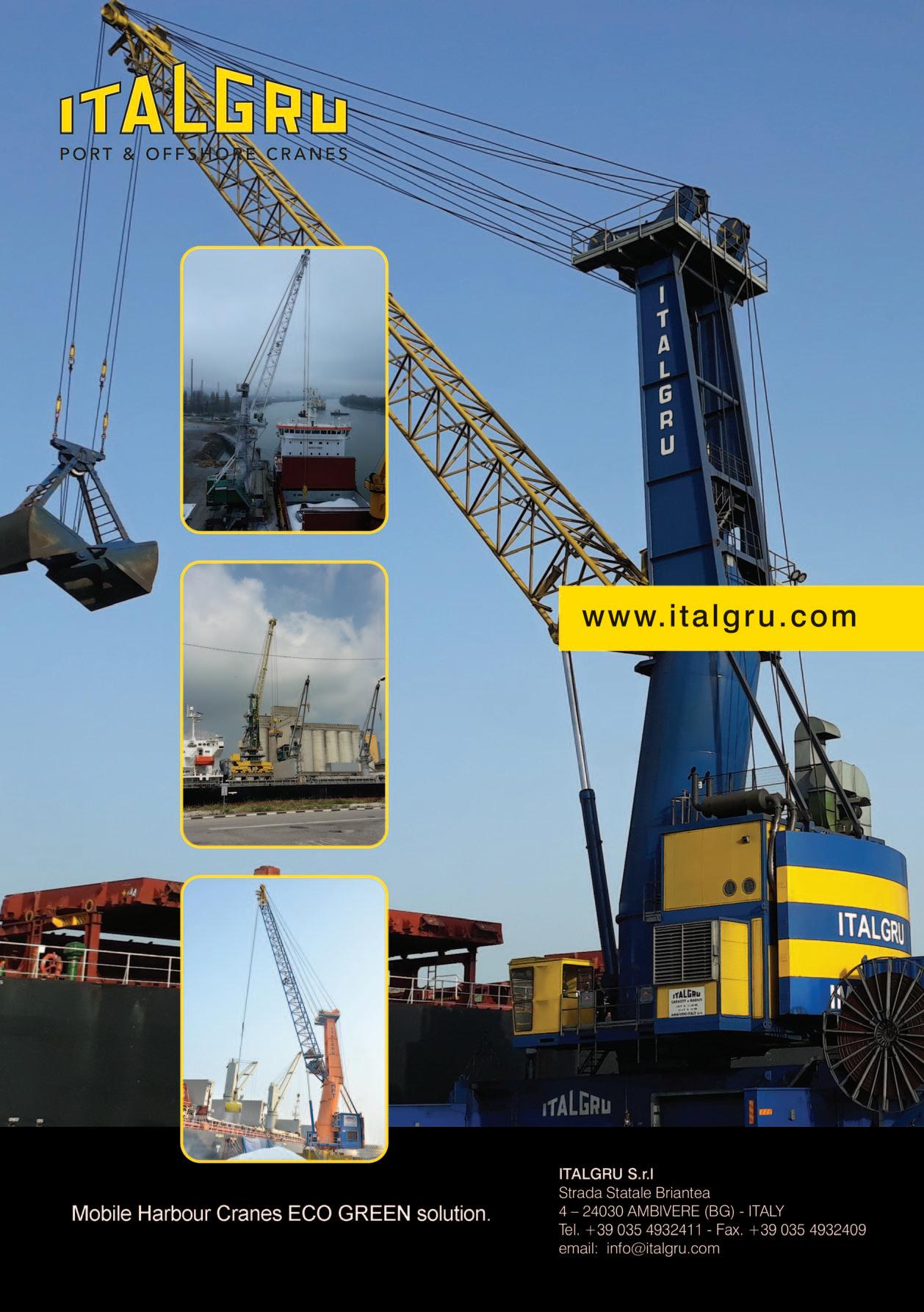
A selection of a few recent Bedeschi dry bulk related projects

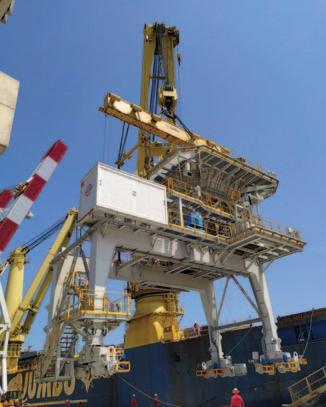
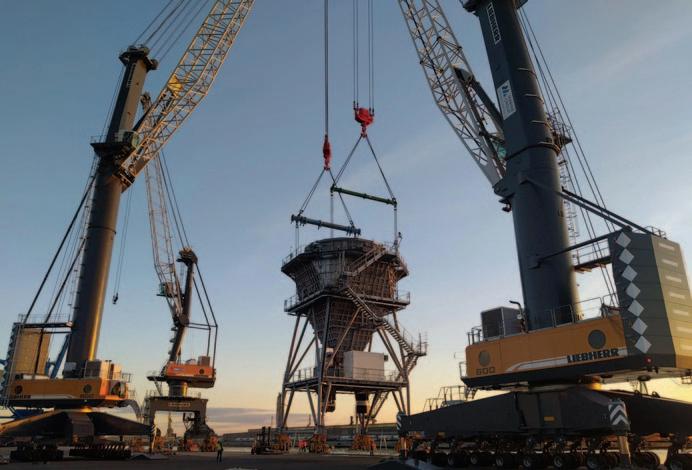
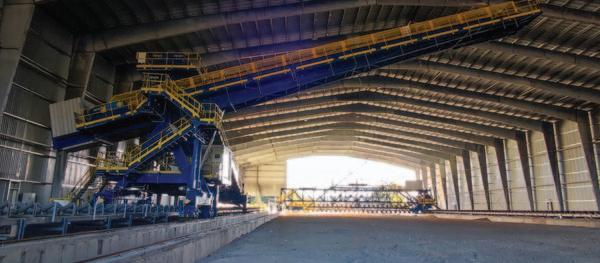
SITE UPDATE FROM MITCHELL CEMENT PLANT IN THE US (16/11/2022)
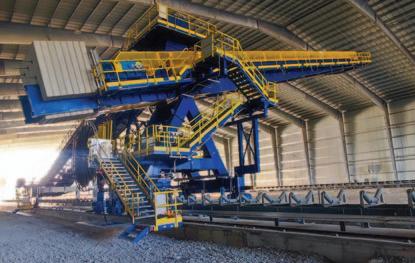
two apron
one
reclaimer.
NEW BEDESCHI ECO HOPPER READY TO BE SHIPPED
(04/11/2022)
Bedeschi’s team completed the erection and commissioning of the Eco-hopper in Rostock (Germany). The photos show the Eco-hopper completed and moved alongside the vessel ready to be shipped to its final destination in France. Bedeschi supplied a fully erected Eco-hopper on Turnkey basis, with a high level of customization according to final client requirements. The project is state of the art for the environmental standards: dust control and de-dusting system have been specifically designed for this application. Bedeschi is in charge of the whole process from engineering, procurement, construction until the final commissioning for the equipment.

UNLOADING OPERATIONS OF TWO SHIPLOADERS AND ONE ECO HOPPER FULLY ERECTED
(27/10/2022)
Unloading operations of Bedeschi’s two shiploaders and one Eco-hopper that have been shipped fully erected from Jabel Ali port to Ghana Takoradi Port. The machines have been pushed in their correct position and will soon be installed and put into operation. The scope of the project is the supply of handling equipment and services for bauxite and manganese in export and clinker in import. In fact, one shiploader will handle manganese, the other one will handle bauxite. Other part of the supply for Takarodi Port includes five belts conveyor for a total length of 3km.
ENGINEERING & EQUIPMENT 94 NOVEMBER 2022 DCi www.drycargomag.com
Site update from the plant where Bedeschi is finalizing the installation for Mitchell Cement Plant in the US. The supply includes two crusher units,
feeders,
stacker, and one
Both stacker and reclaimer are installed inside a longitudinal park. In the pictures, the stacker and the reclaimer at the final stage of installation. The stacker will handle limestone at a capacity of 1,200tph, while the reclaimer has a capacity of 650tph.
DCi

Thank you
...for proving us right. Advertising really does work. To find out how you can benefit from advertising in the world’s only monthly dry bulk publication contact Andrew Hucker-Brown on: T: +27 31 583 4360 E: info@dc-int.com W: www.drycargomag.com
DRY CARG O international
DC i TM
The new Liebherr mobile harbour crane of type LHM 550 is the largest mobile harbour crane in South Norway. SmartGrip, electric drive, and a v comprehensive service package were part of the features setting the crane apart.

A special naming contest was held in v honour of the crane by the local community.
Port of Arendal adds LHM 550
Located in the southern part of Norway between Larvik and Kristiansand, the Port of Arendal is the biggest bulk port in Norway that uses mobile harbour cranes. The new LHM 550 joining the port is equipped for a variety of cargo applications. Liebherr’s own SmartGrip assistance system will optimize bulk handling for a battery factory in the region.
In August 2022, Liebherr delivered a
The LHM 550 arrived in Arendal on 22 August and features an outreach of 54 metres and heavy-duty lifting up to 144 tonnes.
new LHM 550 to the Port of Arendal in Norway. The main commercial terminal for the port is located at Eydehavn, just outside the city of Arendal. Eydehavn is a harbour that offers cranes and handling equipment for bulk loads, project cargo, offshore equipment, and containers. With a lifting capacity of up to 144 tonnes, this LHM 550 offers the port the ability to support larger project and special cargo, as
www.drycargomag.com
BREAKBULK & BAGGING 97 NOVEMBER 2022 DCi
well as optimized bulk operations. Another distinguishing benefit sought by the Port of Arendal is Liebherr’s extensive and high standard of service. Besides remote technical support and local field service, a large selection of original parts will help keep the LHM 550 running over many years.
OPTIONS FOR IMPROVED BULK PROCESSING, HANDLING LARGER CARGO, AND SUPPORTING MORE CUSTOMERS
The four-rope version of the LHM 550 that was delivered to the client in Arendal will provide flexible applications for cargo and material lifting. For increased efficiency in handling bulk cargo, a suitable grab that is coupled with Liebherr’s SmartGrip technology was part of the crane’s delivery. This feature can optimize the filling rate of the grab in a self-learning manner. In this way, SmartGrip learns after just a few lifting cycles how to optimize capacity utilization of the grab. This reduces overloads to a minimum, increases the material handling rate and, at the same time, alleviates crane operator stress. Bulk material such as salt and sulphur will be among the main resources that will be handled by the LHM 550.
A forthcoming project in the area that will benefit from the crane’s optimizations is a new battery factory by Morrow Batteries.
Rune Hvass, Port Director at Arendal Havn, notes: “After deliberations about which LHM model fits our logistical needs the best, we ultimately decided on the LHM 550. An increasing number of customers are demanding capacity for
The new crane has already effortlessly handled a lift of 138 tonnes for the harbour.
larger and heavier project and general cargo. To also provide better support for a new battery factory that will be built locally, the choice for a larger mobile harbour crane made most sense.” Hvass continues: “The high-quality level at which Liebherr is building its cranes, and especially the service concept Liebherr provides, were some of the main reasons why we decided to purchase a Liebherr mobile harbour crane.”
To help reduce noise, the crane is equipped with noise insulation material in the winch and machinery compartment. The crane is also equipped with an e-drive to enable local CO2-emission-free operation. In addition, the complete LiDAT smartApp package was chosen for the LHM 550. The LiDAT modules such as Maintenance and Optimise help monitor a variety of variables for better performance tracking and efficiency of the crane.
CRANE’S ARRIVAL IS WELCOME NEWS FOR CLIENTS AND COMMUNITY
The Port of Arendal now has a new, wellcalibrated machine to effectively support its clients’ growing logistical demands. With a radius of 54 metres, the LHM 550 is the perfect crane for handling bulk cargoes in the Capesize ship class. Container handling ships of the NewPanamax class are also part of the crane’s forte. General cargoes and heavy-duty lifting up to 144 tonnes complete the range of applications of the LHM 550.
To help mark the delivery of the crane, a special naming contest was hosted by the port. Arendal Havn invited 25 groups featuring the region’s kindergartens,
primary schools and lower secondary schools to participate in a naming contest for the port’s new giant. The winner of the contest was Trollstubben kindergarten with the group Fjelltroll and Vetter. They received a prize of NOK 2,000, which equates to around €200, and a tour of the harbour. The LHM 550 was named Hulken, or Hulk in English, and is based on the Marvel comic book character.
ABOUT LIEBHERR-MCCTEC ROSTOCK GMBH
Liebherr-MCCtec Rostock GmbH is a major European manufacturer of maritime handling solutions. The product range includes ship, mobile harbour and offshore cranes. Reachstackers and components for container cranes are also included in the product portfolio.

ABOUT THE LIEBHERR GROUP
The Liebherr Group is a family-run technology company with a broadly diversified product range. The company is one of the largest construction machinery manufacturers in the world. However, it also offers high-quality, user-oriented products and services in many other areas. Today, the group comprises more than 140 companies on all continents. In 2021, it employed more than 49,000 people and generated a total consolidated turnover of over €11.6 billion. Liebherr was founded in 1949 in Kirchdorf an der Iller in southern Germany. Since then, the employees have pursued the goal of convincing their customers with sophisticated solutions and contributing to technological progress.
BREAKBULK & BAGGING 98 NOVEMBER 2022 DCi www.drycargomag.com
DCi
Package deal
K 2022: Starlinger focuses on reducing resource consumption
After two years of pandemic, interest in the packaging solutions made of woven plastic tape fabric supplied by the Austrian world market leader Starlinger & Co GmbH continues to be high. Especially sought after are sustainable packaging and closedloop solutions.
The most important exhibition for the international plastics industry has been a success for the Vienna-based machine manufacturing company. “This year’s K show has been sensational for us.
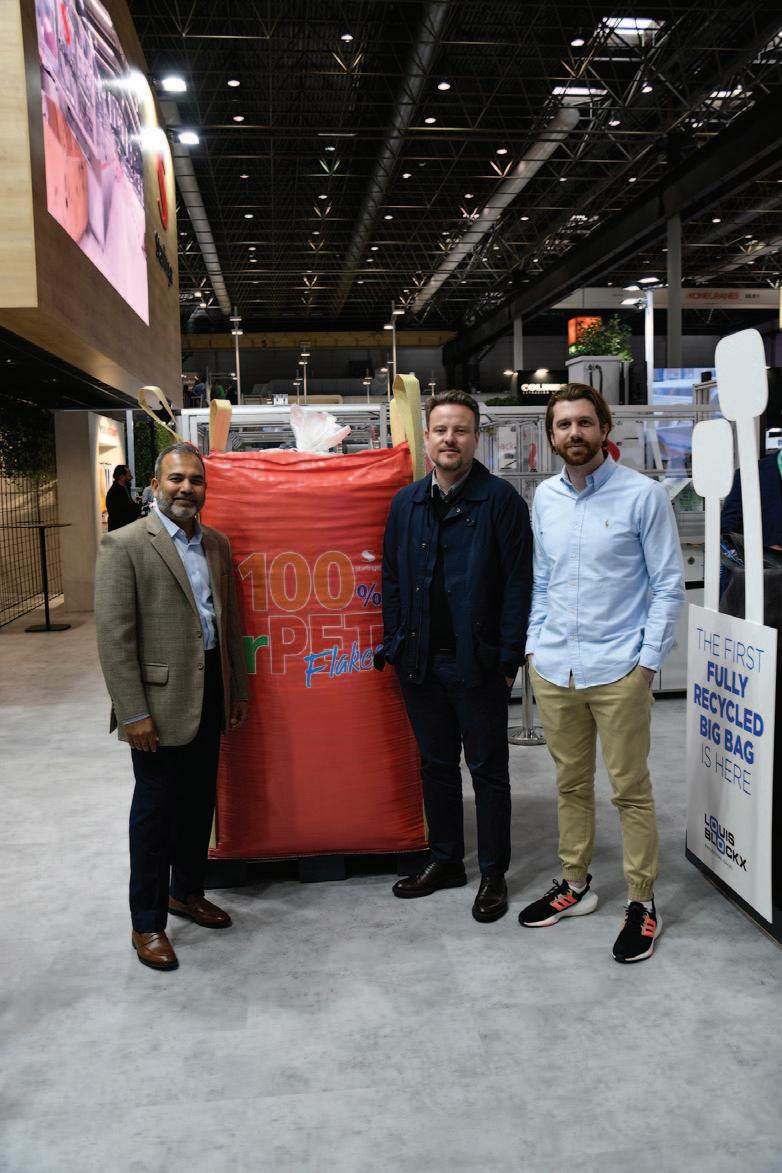
Everybody
about the developments in the sector after all the restrictions due to the pandemic,” said Hermann Adrigan, Head of Sales at Starlinger, summing up the exhibition. “A lot of customers, among them many longtime business partners, visited us both here at our booth in Düsseldorf as well as in Austria during our Open House in our factory which took place at the same time.” The number of deals closed during the
exhibition shows that many companies in the sector are willing to invest. So did Packem Umasree (pictured above), a joint venture of Brazilian big bag producer Packem S.A. and the Indian big bag producer Umasree Texplast. The partners negotiated and closed the purchase of Starlinger production equipment for heavyduty fabric made from rPET for their plant in India at the K show. “For us, K 2022 equals K 2019 in this respect,” confirmed Adrigan. “Both here in Hall 16 as well as at
BREAKBULK & BAGGING 99 NOVEMBER 2022 DCi www.drycargomag.com
is happy to get together personally and talk
bulk bagging & FIBCs — and their role in the bulk handling cycle
the booth of our division Starlinger recycling technology in Hall 9 we sold a number of projects already in the course of the exhibition.”
A main attraction for many customers was the conversion line for AD*STAR woven polypropylene block bottom valve sacks at the Starlinger booth in Hall 16: it produced AD*STAR sacks with a share of 22 % recycled content at a speed of 140 sacks/minute. Also, big bags made of 100% recycled polypropylene and 100% recycled PET supplied by Starlinger customers drew a lot of interest. With the ‘Circular Packaging’ concept for big bags initiated in 2019 Starlinger offers a model for a closed packaging loop for packaging producers.
“Sustainability plays a major role in almost all inquiries we receive nowadays”, explained Adrigan. “As machine manufacturers we have been putting the reduction of resource consumption – be it energy, be it raw materials – in the central focus of our technical developments for decades. Now, also recycled material can be processed on our lines without loss of quality. Packaging producers know: if you
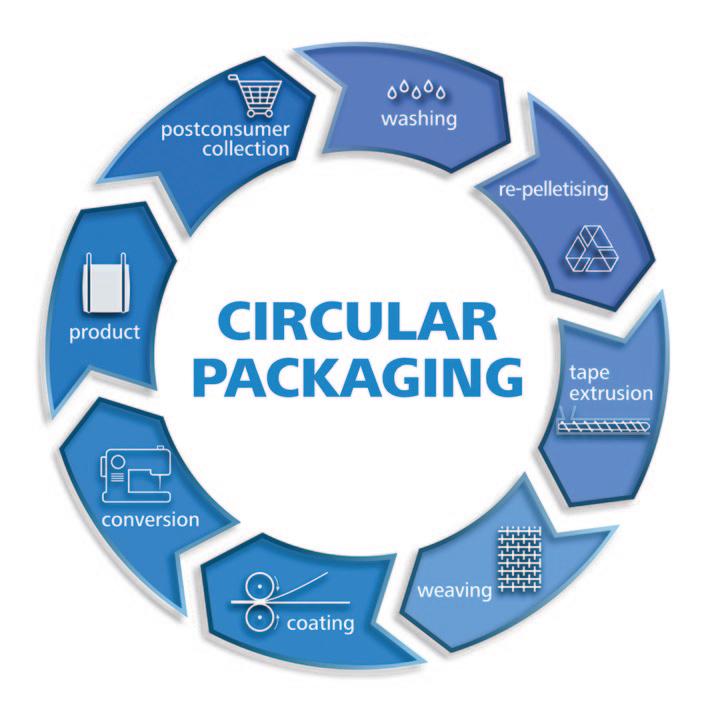
want to produce woven PP or PET sacks in a sustainable way, Starlinger is the place to go.”

ABOUT STARLINGER & CO GES.M .B.H.:
Starlinger is an Austrian machine manufacturing company based in Vienna with production sites in Weissenbach and St. Martin, as well as in Schwerin, Germany and Taicang, China. As a major global supplier of machines and complete systems for the production of woven plastic bags, as well as systems for plastics recycling, PET extrusion and finishing, the Starlinger brand is synonymous with quality and technological leadership in more than 130 countries. Founded in 1835, the family-owned company has been exporting its products around the world for more than 50 years and achieves an export quota of over 99.5%. The company has its own sales and service centres in Brazil, China, India, Indonesia, Mexico, Nigeria, Russia, South Africa, Thailand, the United States and Uzbekistan, each of them guaranteeing swift and professional technical service.
Starlinger is a participant of the United Nations Global Compact, the world’s largest corporate sustainability initiative, and adheres to the principles for responsible business set out therein.
& BAGGING 100 NOVEMBER 2022 DCi www.drycargomag.com
BREAKBULK
STATEC BINDER: serving small and large corporations in all five continents
STATEC BINDER is a respected specialist in packaging systems for bulk materials, and continues to successfully apply its expertise on a global scale. With its flexible and customer-oriented packaging technology, the Austrian company is represented on the international market, placing itself among the foremost suppliers of high-performance open mouth bagging machines. The wide-ranging product portfolio offers customized solutions of the highest quality for products used in a variety of industries.
The fully automatic high-performance bagging and palletizing systems by STATEC BINDER package and palletize free-flowing bulk goods on a daily basis. With satisfied clients located on five continents, STATEC BINDER bagging machines are used worldwide. The company counts small firms as well as large corporations — represented in the petrochemical or chemical industry, animal feed production, agricultural business, sugar or fertilizer industry and many others — among its existing customer base.
With more than 1,700 installed machines worldwide, STATEC BINDER can look back on numerous positive references.


Whether customers require fully automatic or manual machines, the packaging expert is able to offer the right system to each of its customers to meet their high standards and requirements. For all industries, made-to-measure solutions —tailored to the corresponding general conditions — are constantly created and strongly focused on customers. Beyond the standard product line, the Austrian company also offers customer-specific solutions, which are drawn up together with the customer.
“Today, it is becoming increasingly important for customers to find a competent and reliable partner. Even though our business are primarily bagging and palletizing machines, we consider it to be our responsibility to support customers with their challenges and to provide them with the best possible advice and support. This is the only way we can be a strong and reliable partner,” says Josef Lorger, Managing Director of STATEC BINDER.
CUSTOMER SERVICE AS A SUCCESS FACTOR
Thanks to proven technology as well as continuous developments and optimiza tions, the company serves as an internationally recognized partner to
YOUR PARTNER FOR BAGGING & PALLETIZING
HIGHPERFORMANCE open mouth and FFS (form-昀ll-seal) bagging machine
HIGHPERFORMANCE robot, high-level & portal palletizer
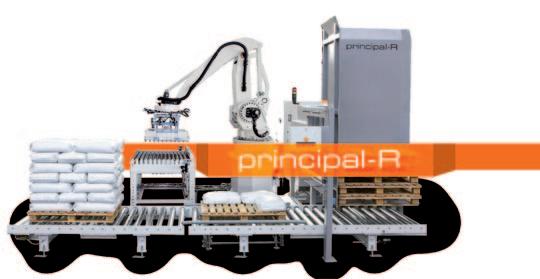
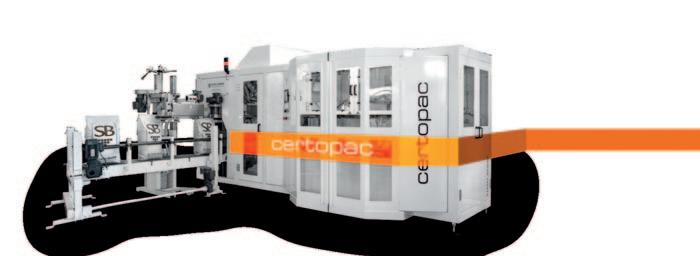
Flexible and customized solutions
More than 1700 successfully installed machines worldwide
More than 40 years of experience
STATEC BINDER stands as a strong and reliable partner for the packaging of your products.
www. statec-binder.com
STATEC
BREAKBULK & BAGGING
BINDER GmbH Industriestrasse 32, 8200 Gleisdorf, Austria Tel.: +43 3112 38580-0 E-Mail: o�ce@statec-binder.com
many. Customers all over the world put their trust in STATEC BINDER every day. Expert consulting services, a high level of service competence and support for any concern provide reasons for this. Customer service is characterized by highly trained employees and online service with real-time support.
STATEC BINDER specialists are always available to provide assistance and answers to questions, from dealing with orders of spare parts and their delivery, ongoing inspections and maintenance of machines and individual customer training programmes, to tailor-made service agreements.
The fullest satisfaction of the customers has the highest priority. STATEC BINDER focuses on a high level of communication, fast availability and proximity to the customer within its partnerships. That is why a large number of the company’s representatives offer not only consultation, but also support customers with maintenance services and inspections directly and immediately on site.
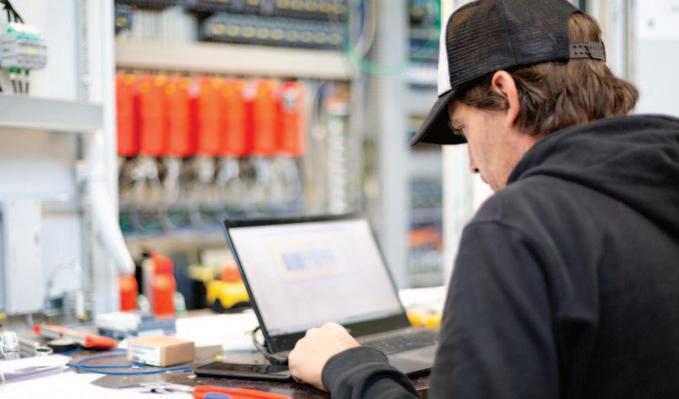
After 40 years of experience, the Austrian company stands for absolute reliability, characterized by precision and constant innovation.
HIGH- PERFORMANCE BAGGING SYSTEMS
Depending on the specific product and its properties as well as the desired performance, either open-mouth bagging machines or FFS (form, fill & seal) machines are used.
Standing as the most efficient machine out of the broad product portfolio of STATEC BINDER, the PRINCIPAC is also among the fastest open mouth bagging machines around the globe. As a result of this high performance, the machine is in great demand within many industries. High
flexibility and reliability characterize this bagging system. There are two more openmouth packaging machines in the product portfolio of STATEC BINDER: CERTOPAC and ACROPAC. Depending on the customers’ requirements the suitable machine is chosen. On request, all STATEC BINDER packaging systems can be equipped with a dust proof filling spout for packaging powdery products.
The FFS machine SYSTEM-T is particularly suitable for fast packaging of bulk materials. It combines the highest packaging quality of PE tubing with a high production capacity. The SYSTEM-F, a fully automatic vertical FFS machine allows easy and quick adjustability and only requires little space.
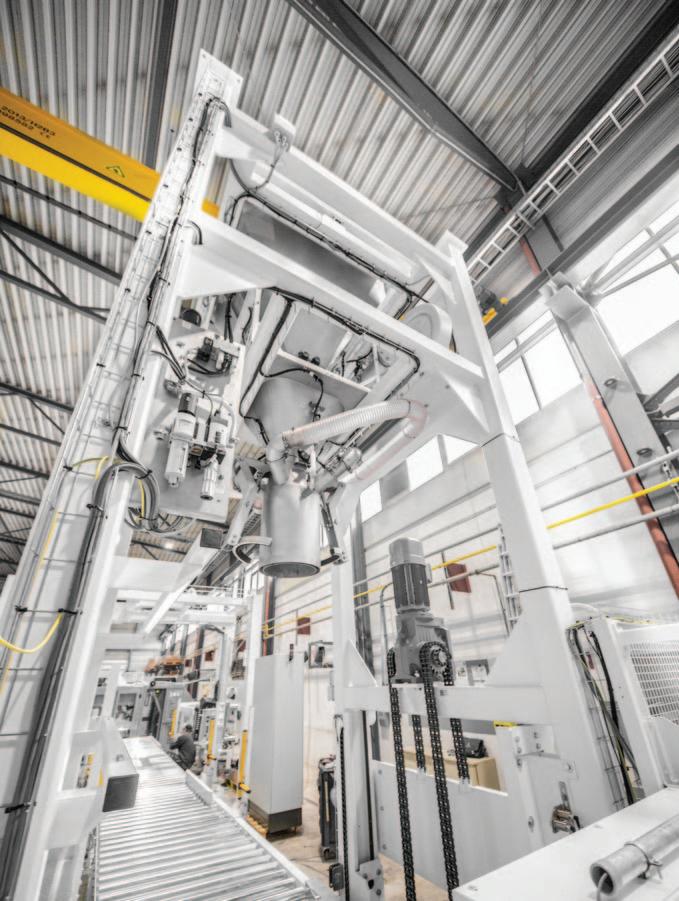
The semi-automatic big bag filling station makes it possible to fill big bags (FIBC) with a filling weight of 500kg to 1,500kg. At 150 big bags per hour, this big bag filling station is one of the fastest in the world. Furthermore, it is characterized by the extremely sturdy construction and the high level of reliability.
ABOUT STATEC BINDER
STATEC BINDER is a well-known specialist when it comes to bagging and palletizing fertilizer. In addition, the Austrian company constantly proves that the customer's requirements have top priority and it is looking for the perfect solution for bagging and palletizing the respective product. For these reasons, many customers rely on STATEC BINDER machines and long-term and successful partnerships are established.
One thing is certain for STATEC BINDER: only through the experience and feedback of the customers is it possible to continuously further develop and optimize the machines in order to meet the requirements of the customers and to ensure satisfaction.
BREAKBULK & BAGGING 102 NOVEMBER 2022 DCi www.drycargomag.com
Big bag workshop.


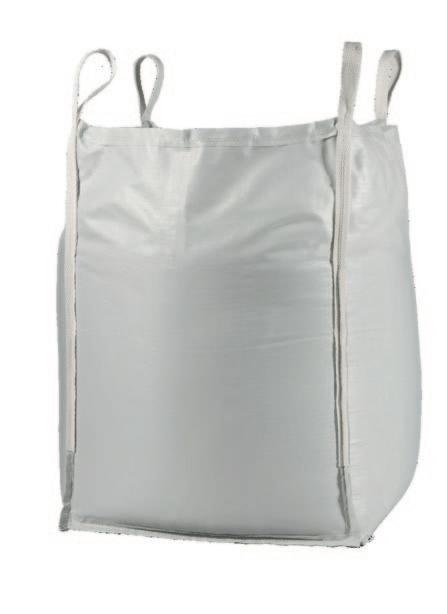
ARODO: focusing on maintaining the high quality of customers’ powders
Packaging and palletizing expert Arodo has extensive all-round expertise in the handling of powdery materials for, among others, the bulk industry. The Belgiumbased company offers particular expertise in: Bag filling and closing lines; v AROVAC® bag vacuuming technology; v Palletizers; and v Stretch hood machines v
Packaging powdery products is an operation that requires specialized packaging technology. After all, it involves a complex interplay: on the one hand, the accuracy of the system and the reliability of the packaging, and on the other, logistical performance and cost-efficiency.
Because of this complexity, Arodo has dedicated itself to the development and production of customer-specific powder packaging lines for producers of highquality powders. It is thanks to this unique focus that the company has such a strong position in the market. In fact, its AROVAC® technology is the only one in the world that vacuum packs powders with Arodo’s bag filling machines.
GLOBAL TRACK RECORD
Expertise comes with experience. Arodo has built up an impressive track record over the past 30 years.
It has sold its machines in around 20 countries worldwide: from the United States and Sweden to Israel and India.
ARODO’S MOTIVATION IS INNOVATION
It is crucial to continuously stay ahead of the pack: for the customer, and also for Arodo. Innovating for the long term can only be achieved with a strong innovation policy, a clear-cut technology roadmap, and a corporate culture driven by continuous improvement. Arodo’s introduction of high-speed machines with double filling
innovation at project level: putting v new ideas in practice as soon as a project demands it; and innovation for the long term: v develop and apply new ideas based on market needs.
UNIQUE OPEN-MOUTH BAG FILLING MACHINE
With an Arodo bag filling machine, customers can pack all their powdery products with maximum efficiency. Arodo’s many years of experience enable it to develop optimal packaging processes for every product and application.
Arodo offers a range of bag filling machines for paper and plastic open mouth bags. These can be closed in a variety of ways. Arodo uses a range of techniques to remove residual air: from mechanical systems and its advanced vacuum tech nology, as well as combined solutions. Customers then choose the dosing system that best suits their product.
It is hard to find a bag filling machine manufacturer with this range of options anywhere in the world. And, even more importantly, Arodo has the knowledge to help customers find the ideal packaging solution.

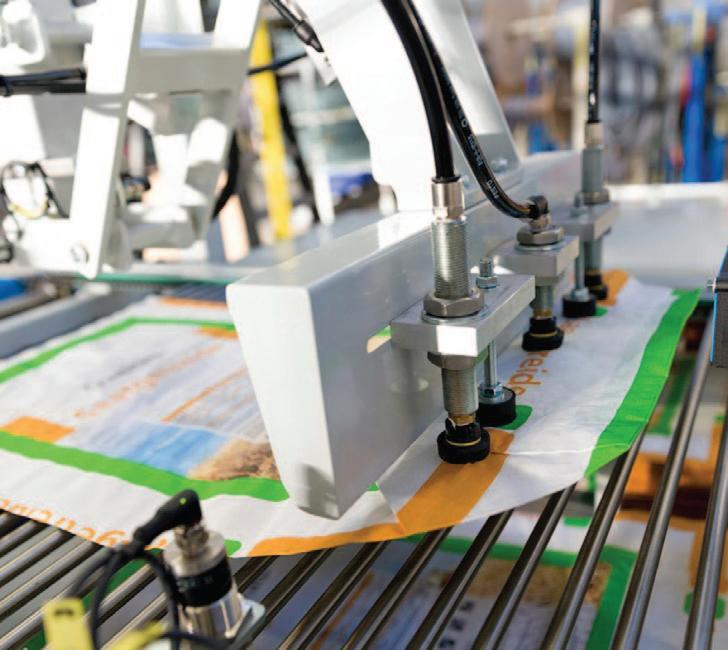
BREAKBULK & BAGGING 104 NOVEMBER 2022 DCi www.drycargomag.com
spouts and the AROVAC® technology — the world's only vacuum packing technology for powders — are proof of this.
MAXIMUM PROTECTION, CAREFREE TRANSPORTATION
Packaging powders that are difficult to de aerate is a knowledgeintensive discipline, especially if the packaging needs to be tightly sealed. It is with that goal in mind that Arodo developed the AROVAC® technology. With this unique technology, customers benefit from maximum protection and carefree transportation of their product.
The bag filling machines of Arodo are the only ones in the world capable of packaging powders ranging from cement to powdered milk, so they are fully airtight and perfectly stackable.
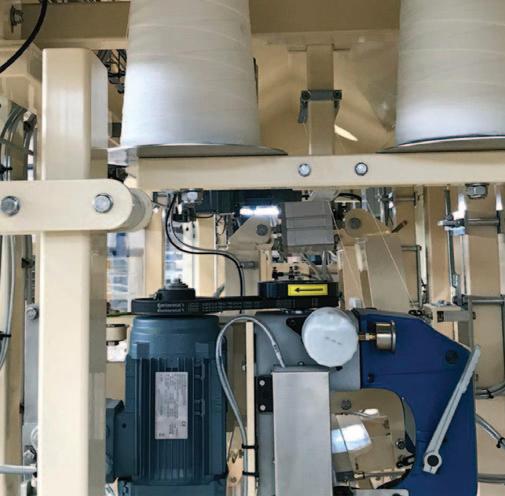
AROVAC® TECHNOLOGY
The AROVAC® vacuum technology is the only technology in the world that allows hermetically sealed packaging of hygroscopic powders. What's more, powders in bags that are difficult to package can be stacked perfectly. There is simply no greater security.
WATER- AND AIRTIGHT


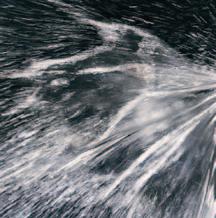
Hermetically sealed, 100% protection
Using the technology of AROVAC®, the customer’s quality powders are bagged in hermetically sealed packaging. This means that even hygroscopic powders such as cement mix, minerals and milk powder are 100% protected against external influences. The more complex the properties of the powder are, the more the customer benefits from this technology.


IDEALLY STACKABLE
Stable transport
In addition to maximum product protection, the size and compactness of the AROVAC® bag ensure ultimate stackability. This may seem like a minor detail, but offers major benefits in practice. It ensures that safety and stability are guaranteed during transport and storage.
SHOCK RESISTANT
No tearing, no waste
Bags that tear cause waste, but also give the customer negative experiences. The compact AROVAC® bag is extra shock resistant and offers better protection against compressive forces, so that ripped bags hardly ever occur. Needless to say that the plastic Arodo uses for the competitively priced bags can be recycled.
Premium powder, premium packed
From
Finally: a 100% waterproof packaging
Thanks to the AROVAC® technology you can opt for bags that are 100% waterproof and completely sealed.
This offers you maximum protection and carefree transportation of your product, even when stored outside for longer periods.
automatic bag filling machine to stretch hooder: our customized packaging solutions make sure your powders maintain their high quality.
How to quickly reload from big-bag to bulk
Value added logistics (VAL) is the creation of higher added value in the logistics chain. In addition to transport, many transport companies also offer repackaging of products. This is also the case in the bulk industry: dry bulk goods are often transported in bulk quantities. When these substances are processed, the products are subsequently repackaged, for example from big-bags to bulk.
Transport and delivery of raw materials happens more and more with the help of FIBCs (flexible intermediate bulk containers), also known as big-bags. For efficient discharging, TBMA offers sophisticated systems to optimally utilize the benefits of these bags.
DUST-FREE , EFFICIENT AND HYGIENIC
TBMA big-bag discharging systems are designed for trouble-free discharging of various products from different types of big-bags. Dust formation, product loss and contamination are thus prevented. Products can vary from free to poorflowing. The systems are suitable for processing single or multi-trip bags, with or without a plastic inner liner.
Discharge usually takes place in, for example, a hopper, screw, loading chute, rotary valve and/or pneumatic conveying system. Sieves, filter units, weighing cells, etc. can be added optionally. For highly polluting products, such as carbon black or Ti02, we offer a solution to adequately remove and dispose the inner liner to limit contamination of the environment to a minimum.
BIG-BAG TO BULK TRUCK
Dry bulk goods are often transported and stored in bulk quantities. Regularly, when these products are processed, they are subsequently repackaged, for example from big-bags to bulk. The value-added logistics industry plays an important part in this process. When transferring bulk goods from big-bags to bulk trucks, time is of essence; sometimes a limited free-ofcharge time slot to load the truck is applicable. For loading bulk trucks, TBMA offers special, high-capacity and flexible bigbag discharging systems.
absorption capacity that can be used as an anticaking aid. It enhances the flowability and prolongs the shelf life of powders or granulates which are liable to caking during storage and transport.
DISCHARGING
SIPERNAT Sipernat is a silica with a particularly high
For the discharging of big-bags holding Sipernat, TBMA designed a twindischarging system for emptying two bigbags at once. The bags are placed above the discharge hoppers with a fork-lift. These hoppers are equipped with a threebladed knife to cut the big-bags. The product then drops into the discharge hoppers and into a single horizontal screw conveyor with opposite pitch, which serves both hoppers. This way, the product ends up in the middle, where it is transferred into an inclined screw conveyor, which transports the product upwards to a loading chute. When loading a bulk truck, the loading chute is connected to the truck’s manhole, ensuring dust-free loading.
A centrally placed, integrated dust filter system filters any product dust that occurs in the discharge hoppers. The S-AX dust rotary valve below the filter system transports the product directly back into the screw conveyor. This way, no product is lost.

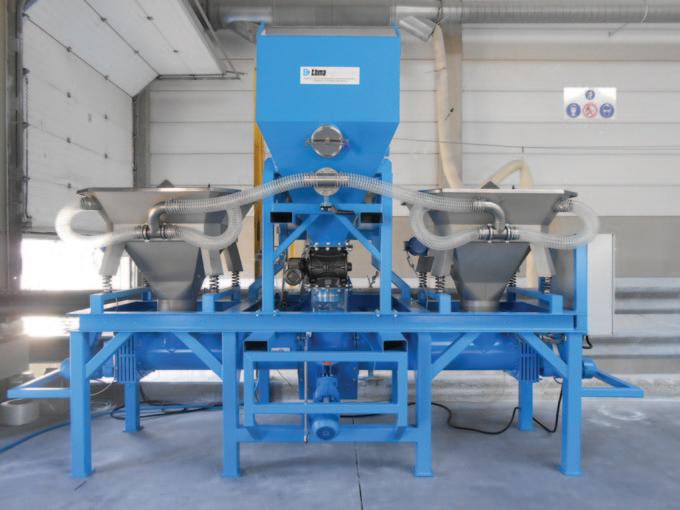
TIO2 DISCHARGING INSTALLATION
Titanium dioxide (TiO2) has been used for a century in a range of industrial and consumer products, including paints, coatings, adhesives, paper, plastics and rubber, printing inks, coated fabrics and textiles, as well as ceramics, floor coverings, roofing materials, cosmetics, toothpaste, soap and water treatment agents. For a leading producer of TiO2,
BREAKBULK & BAGGING 106 NOVEMBER 2022 DCi www.drycargomag.com
TBMA Twin-discharging big-bag discharging system with integrated dust filter system.
The Moduflex loading chute ensures efficient and dust-free loading.
TBMA designed and supplied a customengineered big-bag discharging installation. Key words were high-capacity, ergonomic design, flexibility and minimal dust emission. Also, the system should be able to load two bulk trucks at once.
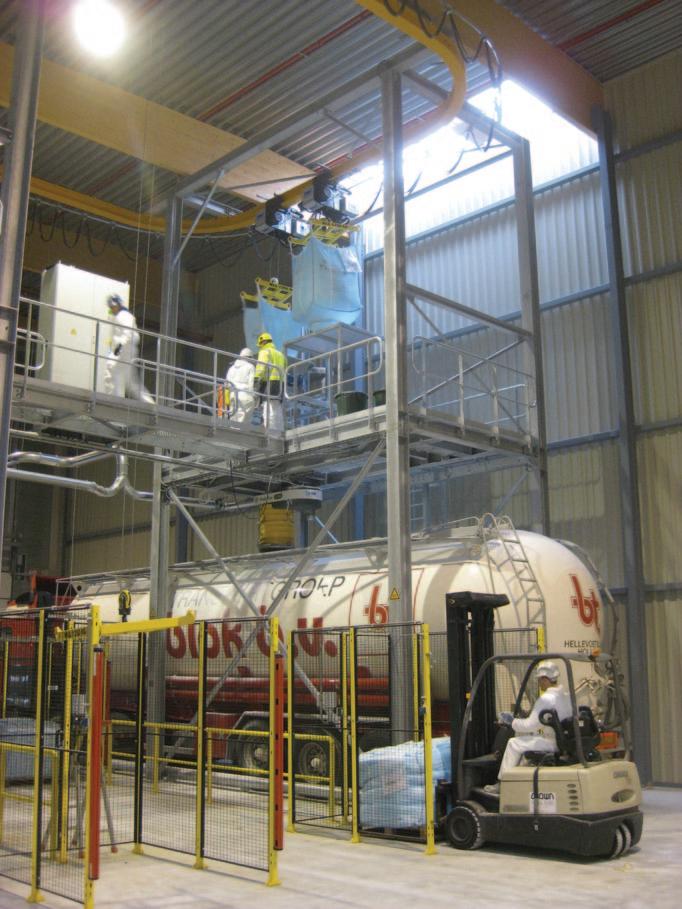
The TiO2 is being produced in a variety of grades for different applications. Crosscontamination between these grades should be avoided at all times. To accomplish this, TBMA designed an installation with two discharging stations. These stations in turn are equipped with two discharge hoppers, so different grades of TiO2 can be discharged without the need to clean the hopper in between. Each of these hoppers is equipped with a large control sieve and a Moduflex loading chute for a dust-free connection to the bulk truck. The central dust filter unit ensures a dust-free working environment.
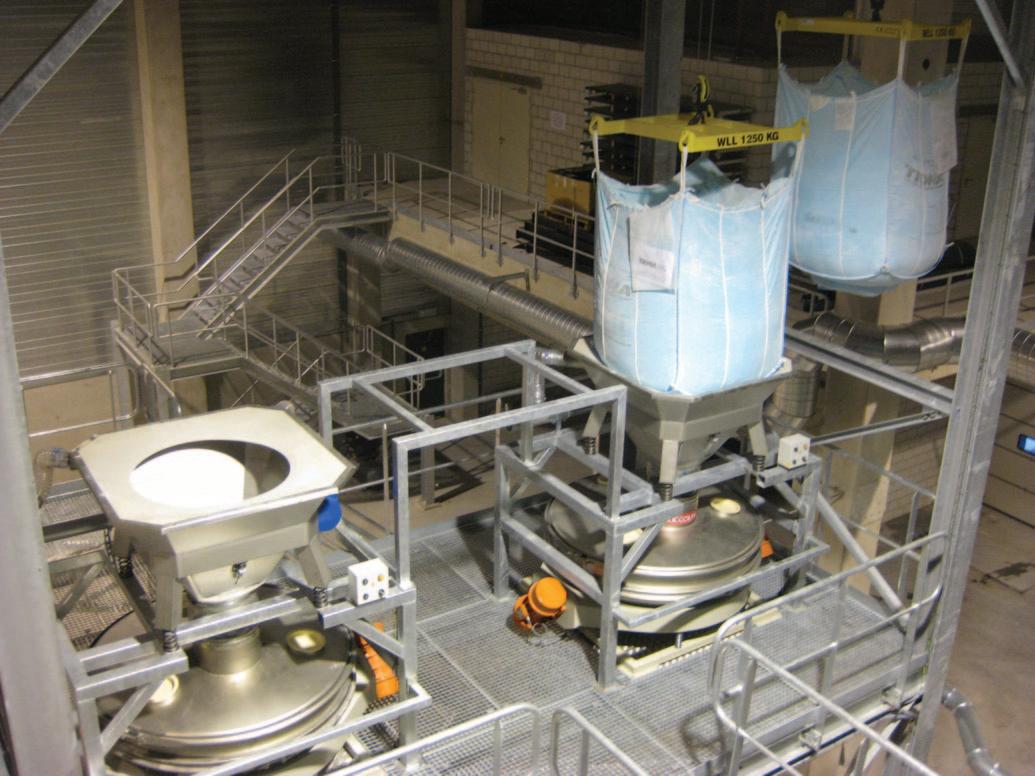
The big-bags are placed at the pick-up point with a forklift. The integrated automatic hoisting device lifts and transports the big-bags to the discharge hoppers. Each discharging station has two hoists: when one big-bag is being emptied, the next one is being prepared at the pickup point and without operator interference, automatically lifted and positioned above the discharge hopper.
Altogether, this clever design allows a continuous and quick big-bag discharging and very efficient filling: the system can fill a 23t truck within one hour. Due to the double-station execution, this means two trucks every hour. Talk about added value!
Continuous TiO2 discharging to fill a 23t truck within one hour.
VALUE-ADDED LOGISTICS (VAL)
With more than half a century of experience, TBMA is an expert when it comes to loading and unloading systems for bulk trucks, silos, ships and stockpiling. The starting point here is always creating a
Two discharging stations to avoid cross-contamination.
dust-free, safe and flexible solution for your production process.
The customer’s ROI and business continuity as well as sustainability also play a significant role in the design of all TBMA systems.
BREAKBULK & BAGGING 107 NOVEMBER 2022 DCi www.drycargomag.com
Quick Way’s four-panel baffle bag and specialist FIBCs
China-based Quick Way (QW), formerly Changzhou Kuaitong Plastic Products Co., Ltd., was established in 1999. It is a professional container bag production factory. It has two production bases in Changzhou, China, with a clean workshop of about 60,000m2 and more than 700 employees.
After 20 years of steady development, it has become a leader in China's container bag industry, and an innovator and promoter of the industry. The company adheres to the core value of ‘Building Our Competitiveness with Beauty’, which is not only a slogan, but also an insistence that every employee builds with responsibility, wisdom and innovative thinking.
The packaging, storing and transporting of bulk materials such as powder, granules, flakes and the like is never an easy task. To effectively reduce cost, increase efficiency and assure the quality in the procedure, it is important to have a safe, convenient, highly efficient way of packaging. QW offers comprehensive solutions with its FIBC products, saving customers from unnecessary hassles.
QW’s products cover Type A, Type B, Type C, Type D all types of container bags. It provides large bags to customers in the fields of food, agriculture, chemistry, and
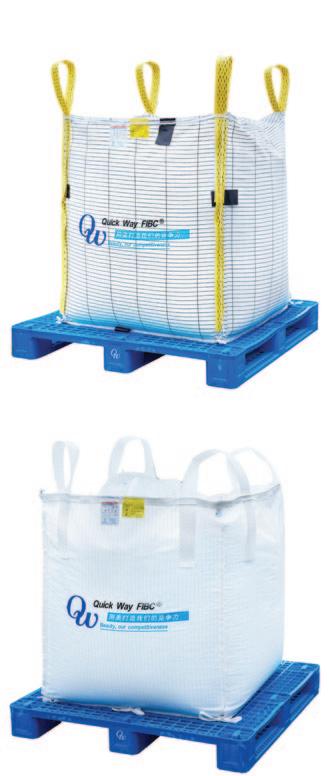
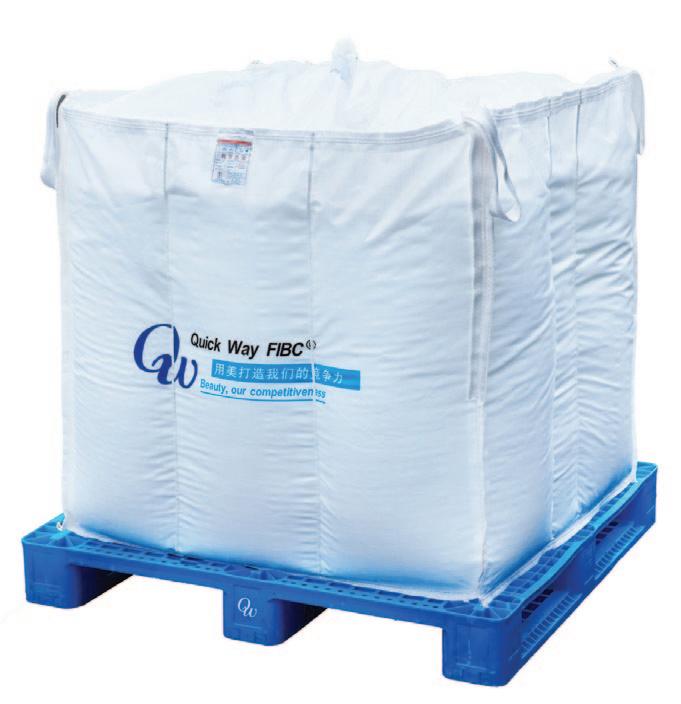
Quick Way’s four-panel baffle bag.
medicine with a productivity of 4.5 million units per year. Users all over the world include Chemours, BASF, Covestro, DSM, ADM, Cargill, etc. The bags are widely used as packaging, storage and transportation tools for granules, powders and even liquids.
BEAUTY = COMPETITIVENESS
often used in combustible environments. Through the correct way of grounding continuously during the process of filling and discharging the bulk materials, it is possible to avoid the hazards of static sparks or even explosions.
Type C (above) and Type D (below) FIBCs from QW.
After QW optimized the production procedure, the four-panel baffle bag has become the company’s most competitive product. The structured design makes the product upright and straight. With the inner baffle, the shape after filling becomes even more satisfactory. no slant and less bulge after filling; v stable and safe when stacking v maximizes warehouse utilization v QW’s efficient production on this v specific design makes it easier to meet customers’ requirements on lead time; widely using for packing powder, v granules, flakes, etc. in pharmaceuticals, foods and chemicals. The packing capacity ranges from 500 to 1,500kg; and can be designed as Type A, Type B, Type v C or Type D to adapt to various environments.
TYPE C GROUNDABLE CONDUCTIVE FIBC
Type C conductive FIBC is the kind that is
QW strictly controls the quality of v conductive fabric during the weaving process, making sure of the accurate yarn gaps and their placement.
QW received compliance certification v on Type C FIBC from the Swiss Institute in 2005. It can be used along with L2 PE liner when there is a need for better shift-proofing.
TYPE D ELECTROSTATIC DISSIPATION FIBC
Type D electrostatic dissipation FIBC is also a design that used frequently under combustible condition. Type D fabric is different from Type C, in that it has the feature to dissipate static charges so is no need to ground. Type D prevents static sparks.
no need to ground — the operation is v safer and more convenient;
QW received compliance certification v on Type D FIBC from the Swiss Institute in 2008. It can be used along with L2 PE liner when there is a need for better shift-proofing;
QW has been supplying Type D FIBC v to its customers for over ten years.
BREAKBULK & BAGGING 108 NOVEMBER 2022 DCi www.drycargomag.com
Air-Pallet® container is Semi-Bulk Systems’ flagship product
Semi-Bulk Systems Inc. is a 47-year-old company providing an array of dry solids handling and dry/liquid mixing processes to industrial, food and beverage, cosmetic and any/all users of bulk solids.
Initially the company focus involved the handling and mixing of specialty chemicals, often filled and shipped in the Air Pallet® container (see below). As the company has expanded its offerings, systems using standard bulk bags or Super Sacks has become a large portion of its ‘dry side options.
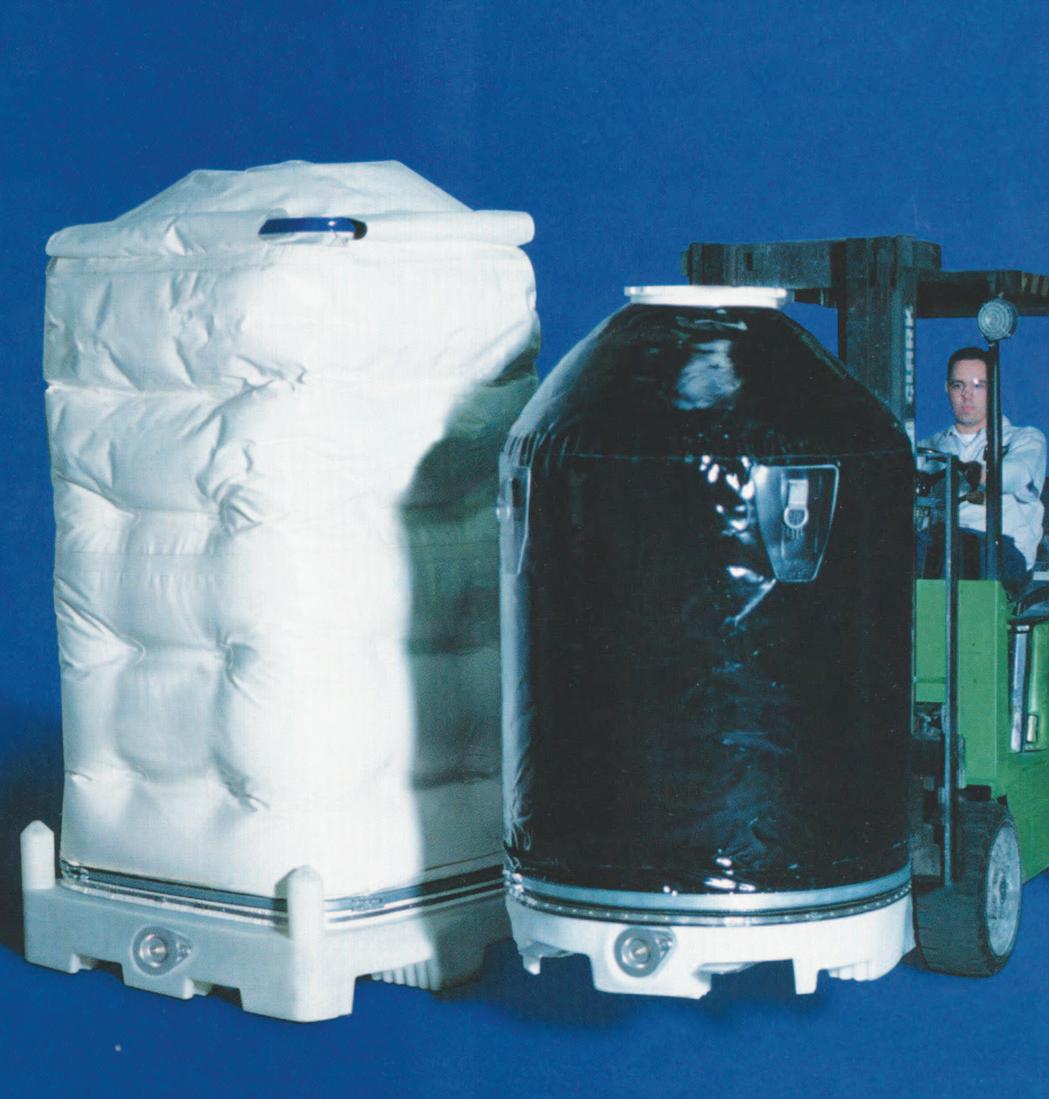
Although Semi-Bulk Systems primarily provides dry bulk and semi-bulk powdered solids handling options to support its
dry/liquid dispersion processes, it has also provided a number of stand-alone bulk bag filling and unloading systems.
Semi-Bulk Systems designs/builds/ manufactures and outsources the various components used in a complete process. Since the company specializes in both dry handling equipment as well as its proprietary powder/liquid mixing equipment, it has few competitors that do both whereas it has many competitors who do one or the other.
Semi-Bulk Systems stresses features, benefits, results, value and ROI to its clients; which when understood, provides far more sustainable competitiveness than fighting
the pricing wars.
Semi-Bulk Systems’ clients tend to be in the Fortune 500 category since, as a small company, it can use its limited sales and marketing resources more effectively while achieving greater success than trying to target everyone.
BENEFITS OF THE AIR PALLET®
When it comes to storing and transporting powders, there are a number of difficult challenges. Storage, transport, and processing powders pose tremendous obstacles: dust-filled air; back injuries from lifting and dumping heavy bags; waste disposal hassles and expense with empty
BREAKBULK & BAGGING 109 NOVEMBER 2022 DCi www.drycargomag.com
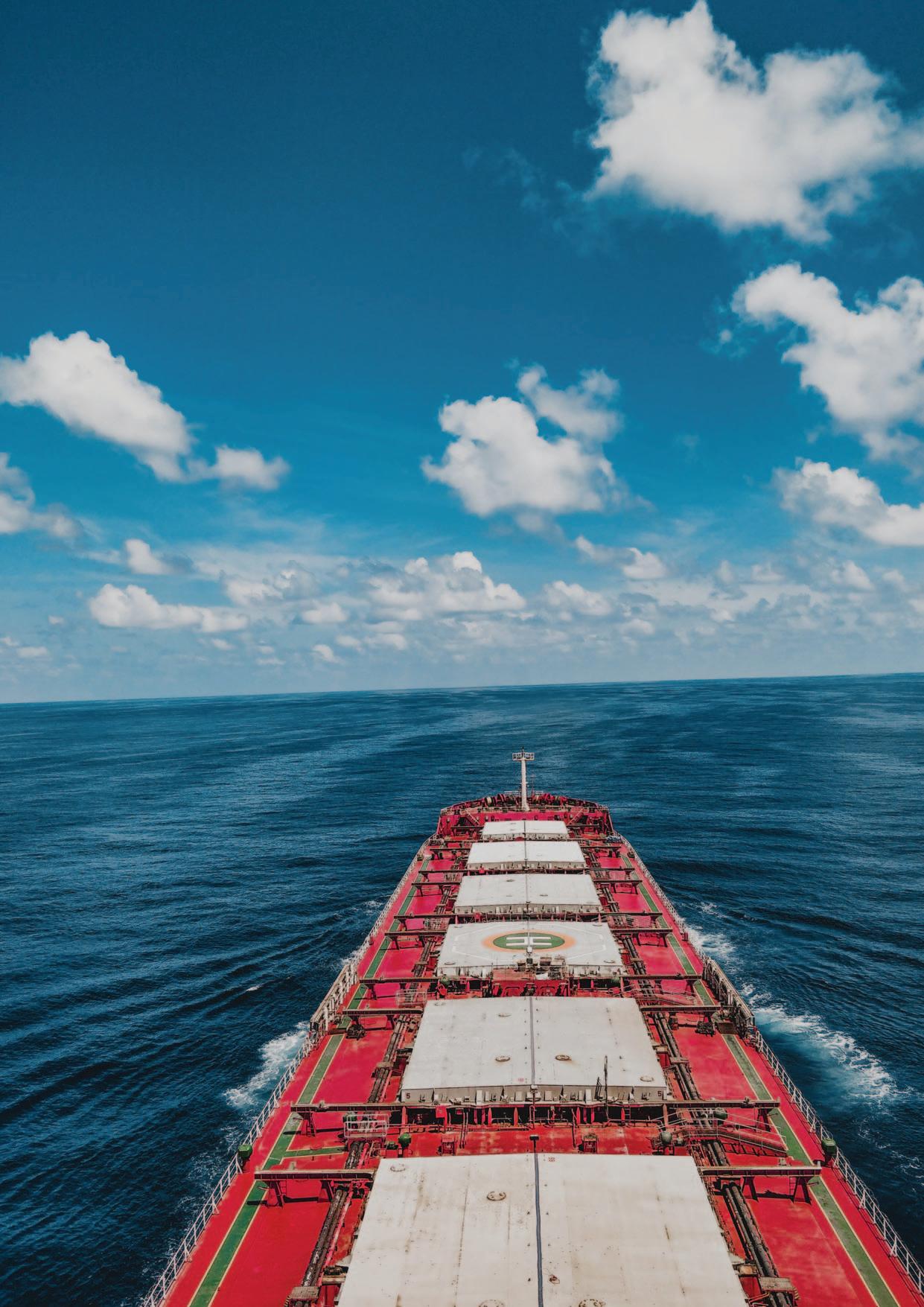
YOU ARE RUNNING A TIGHT SHIP Now let’s tell the world. DCi To find out how you can benefit from advertising in the world’s only monthly dry bulk publication contact Andrew Hucker-Brown on: T: +27 31 583 4360 E: info@dc-int.com W: www.drycargomag.com
packaging; floor space constraints with typical reusable containers; and ceiling height constraints hampering use of standard FIBCs, just to name a few.
Semi-Bulk Systems has been developing effective solutions to the challenges of handling and mixing powders and liquids for more than 45 years. The result is a patented, state-of-the-art technology that is extremely fast, clean, easy and economical. Customers looking for individual components or a totally integrated system can be assured of custom-designed solutions to meet their specific manufacturing needs.
The unique design of the Air-Pallet® System makes it possible to load, transport, store, and unload dry ingredients under completely closed conditions, totally eliminating dust or contamination. It allows total automation with PLC and loss-inweight controls to deliver powder to processes including gravity, vacuum pneumatic conveyors, and the VACUCAM® process. The Air-Pallet® offers:
HIGH QUALITY
reliable flowability: the porous v ‘fluidizing’ membrane floor permits powders to flow smoothly and at a uniform rate with proper fluidization.
LOW COST
waste reduction: the Air-Pallet® v containers are completely reusable and returnable; and reduced labour and product loss: v Air-Pallet containers replace a large number of bags or drums and connect to automated unload options.
FLEXIBILITY & CONVENIENCE reduced space requirements: a range v of Air-Pallet container models and sizes are designed to accommodate very low to very high bulk densities, reducing storage space requirements and optimizing shipping capacities; reduced storage needs: the v containers are completely collapsible, so they can be stacked when empty waiting to be returned; and easy integration: all of the systems v permit integration with the customer’s existing processes, allowing them to add as much or as little of Semi-Bulk’s technology as they want.
HEALTH & SAFETY
complete dust-control: the sidewall v of the Air-Pallet® container has welded seams — all connections form air-tight seals, and fill and unload components are totally enclosed; and fewer injuries and reduced health v care costs: the system requires no heavy bag lifting and dumping.
Operator contact with hazardous or explosive powders is eliminated. Work areas stay cleaner, reducing slips and other housekeeping hazards.
THE ONLY TOTALLY INTEGRATED SYSTEM FOR DRY INGREDIENT HANDLING DUST FREE FILLING EQUIPMENT
Semi-Bulk Systems offers filling v systems for Air-Pallet® containers, as well as bulk bags with adaptors for drums and pallet box filling. Available options include: scale base with automated fill weight control; compaction tables and thumper tables for product densification and stability; adjustable mast for accommodation of varying container heights; automated divert valve control for vent and dust control to dust collector; manual and power roller conveyors to load empty containers and remove full containers; inflation blowers for bulk bag liners and vacuum blowers for product densification where applicable.
Filling systems for bulk bags and bins v designed for hygienic filling of food ingredients. They also incorporate options listed above.
Semi-Bulk Systems offers complete design engineering, including initial ingredient evaluation and characterization. All fabrication and assembly are done in the company’s manufacturing facility, and systems are tested in its production-scale pilot plant before they are placed into the customer’s operations. Then Semi-Bulk Systems supervises the installation and start-up and provides ongoing training and service.
TYPICAL APPLICATIONS
Semi-Bulk Systems custom designs each system to fit its customer's specific product and processing requirements, physical plan accommodations and other variables. It can design an entire system or the necessary components to integrate the Air Pallet® system within the customer’s existing process.
Custom-designed applications are being developed on a regular basis as the company works to meet each client's distinctive, individual needs. The following applications are examples of how the Air Pallets® container is currently being used in both industrial and sanitary processes.
Industrial applications: examples of v products being shipped and handled in Air-Pallet® containers include pigments, clays, starches, PVC resins, precious and heavy metal catalysts,
dispersants, powdered thickening agents, specialty and intermediate chemicals and heavy metals.
Sanitary applications: examples of v products currently being shipped or handled in Air-Pallet® containers include specialty chemicals, brewing filtration materials, pet food ingredients and health care compounds.
UNLOADING OPTIONS
When the Air-Pallet® container reaches its destination, the contents can be conditioned to flow into almost any unloading or conveying process. A unique feature of this system is its capability to discharge controlled increments, measured by container weight loss or by receiver weight gain.
ADVANCED TECHNOLOGY FOR HANDLING DRY INGREDIENTS
Semi-Bulk Systems’ Air-Pallet® system is the only totally integrated system for dry ingredient handling on the market. It provides an incomparably safe, clean, and economical method for handling pigments, resins, clay, starches, flour and other fine powders. Here's how it works.
The Air-Pallet® container is the heart of the system. The sidewall is constructed of heavy duty PVC, polyurethane or other coated fabric attached to a lightweight HDPE base. The base contains a unique built-in fluidizing membrane floor, air probe entry port, product discharge port and four-way access entry for fork lifts and hand trucks.
Using a dust-free automated filling station supplied by Semi-Bulk Systems, the customer’s supplier fills the Air-Pallet containers with their raw materials and ships them to their plant. These containers eliminate the need for bag breaking and drum dumping.
While they are designed to hold up to 4,100 pounds, they require much less storage space because they are collapsible. Since the containers are also reusable, there is no package waste handling and disposal.
The Air-Pallet® container can be emptied in its entirety or in controlled increments. The porous fluidizing membrane floor in the base permits lowpressure ‘conditioned’ gas to permeate the entire contents uniformly at a controlled rate. When the dry ingredients are conditioned, they assume the properties of a liquid and can then be transferred either directly into the manufacturing process or to interim storage.
BREAKBULK & BAGGING 111 NOVEMBER 2022 DCi
www.drycargomag.com
DCi
Company Page Company Page
A/S Cimbria 83
Alex Stewart International Corporation Ltd Back Cover
Arodo BV 105
ASGCO “Complete Conveyor Solutions” 65
BEUMER Group GmbH & Co KG 15
Cambelt International LLC 75
Cleveland Cascades Ltd
Inside Front Cover, 81
Control Systems Technology Pty Ltd 55
CRS - Container Rotation Systems Pty Ltd 3
DemcoTECH Engineering 69
Doppelmayr Transport Technology GmbH 57
E-Crane Worldwide 5
Gambarotta Gschwendt 67
Hagglunds AB 54
Italgru S.r.l. 93
LD Ports & Logistics 32
Liebherr-MCCtec Rostock GmbH 41, 43
Listenow GmbH & Co. 61
Mack Manufacturing Inc 53
Martin Engineering 59
MGB & Company 39
Negrini Srl 95
Neuero Industritechnik GmbH Inside Back Cover
ORTS GmbH Maschinenfabrik 73
PEINER SMAG Lifting Technologies GmbH 16
REEL Alesa 71
RULMECA HOLDING S.P.A. 90
SIBRE - Siegerland Bremsen GmbH 7
SIG Società Italiana Gomma Spa 51
Starlinger & Co. Gesellschaft m.b.H. 103
STATEC BINDER GmbH 101
Terex Deutschland GmbH 63
Van Aalst Bulk Handling BV 68
Van Beek 53
Verstegen Grijpers BV 19
Vigan
Front Cover, 28
INDEX OF ADVERTISERS
www.drycargomag.com DRY CARGO international DC i FREE ACCESS to up-to-date news affecting the dry bulk and breakbulk industries FREE ACCESS to over 200 digital issues of Dry Cargo International magazine FREE ACCESS to the DCi online archive search utility FREE ACCESS to DCi’s unrivalled global market coverage The world’s leading and only monthly magazine for the dry bulk industry
SHIP LOADER SPECIALIST



















NEUERO



produces the most reliable and high-quality bulk ship loaders worldwide. Environmentally friendly with less dust, less noise and more efficiency | neuero.de/en

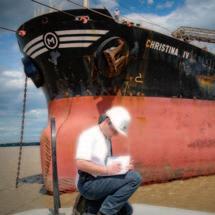


Experienced Soya Bean Inspections 21 Sefton Business Park, Aintree Liverpool, Merseyside L30 1RD United Kingdom T: +44 (0) 151 525 1488 E: glenn.forbes@alexstewartagriculture.com Your global network of inspection and analytical services www.alexstewartagriculture.com





































































 Port and transshipment solutions CBG series
Port and transshipment solutions CBG series




































































































































































































